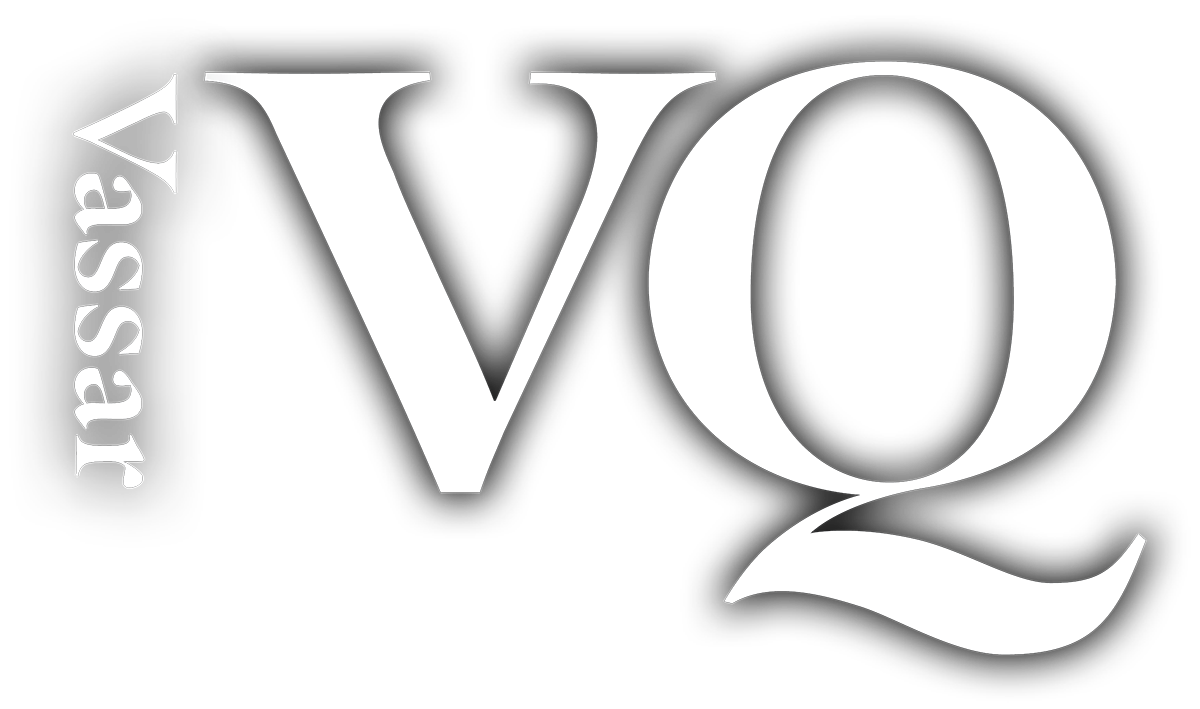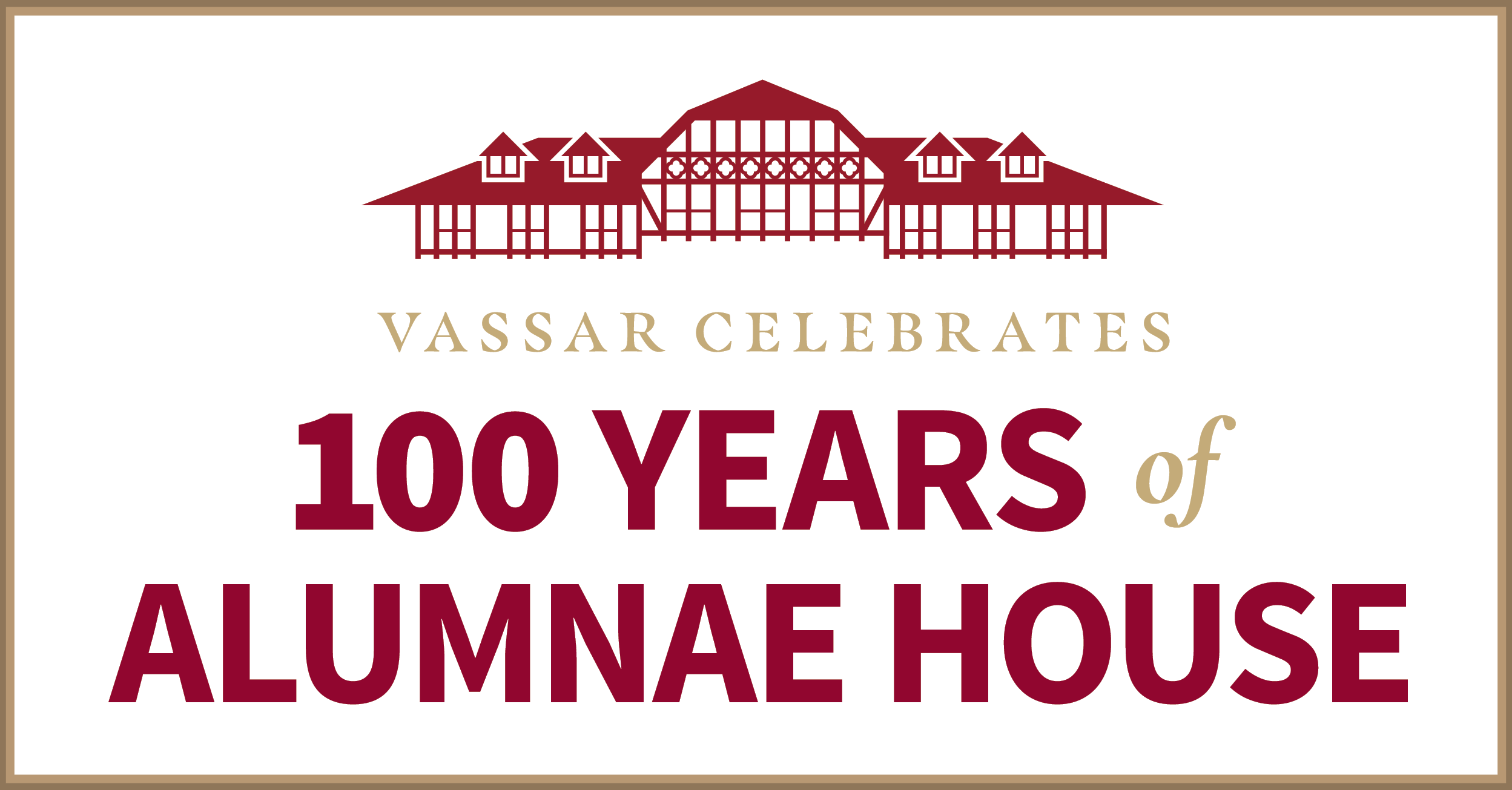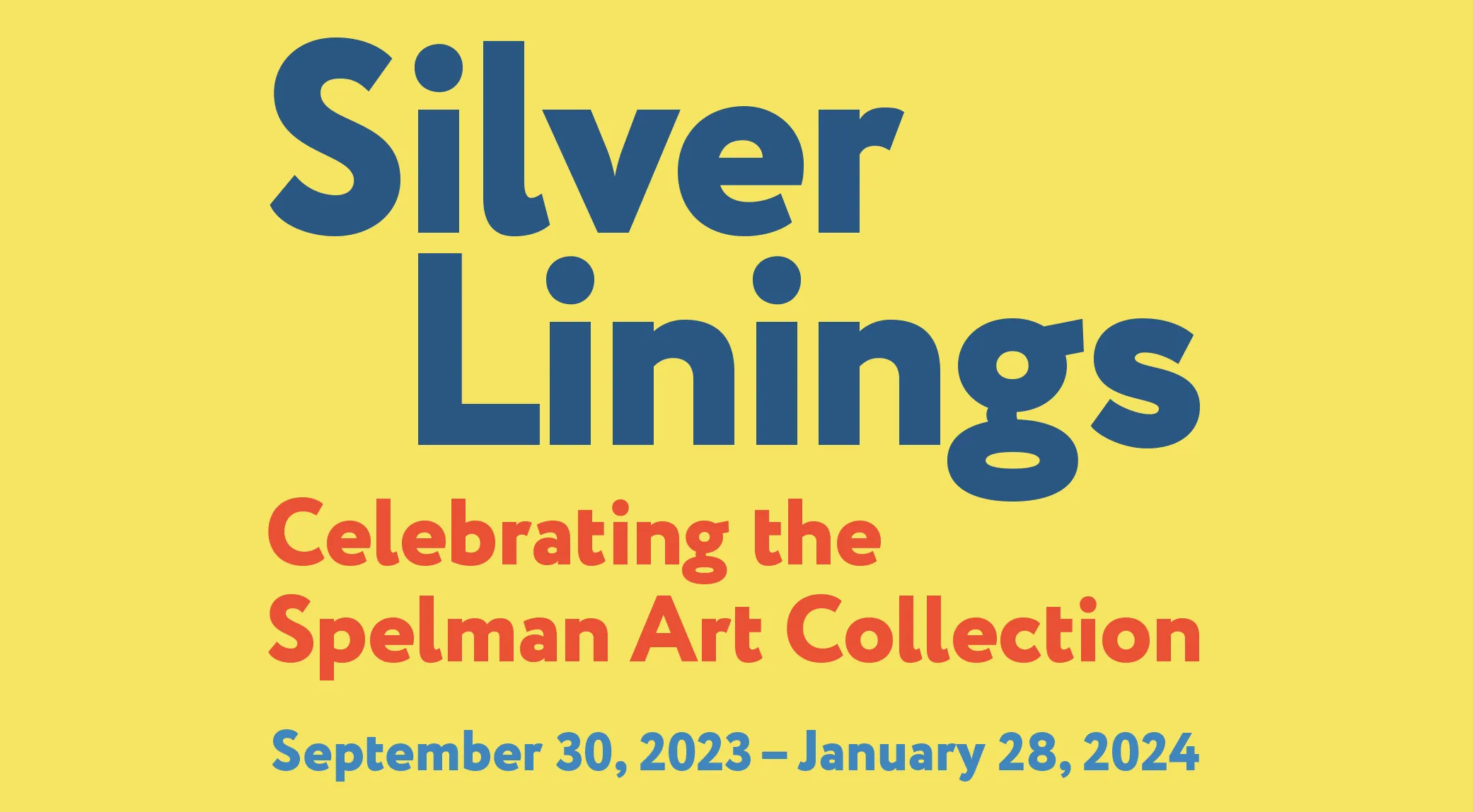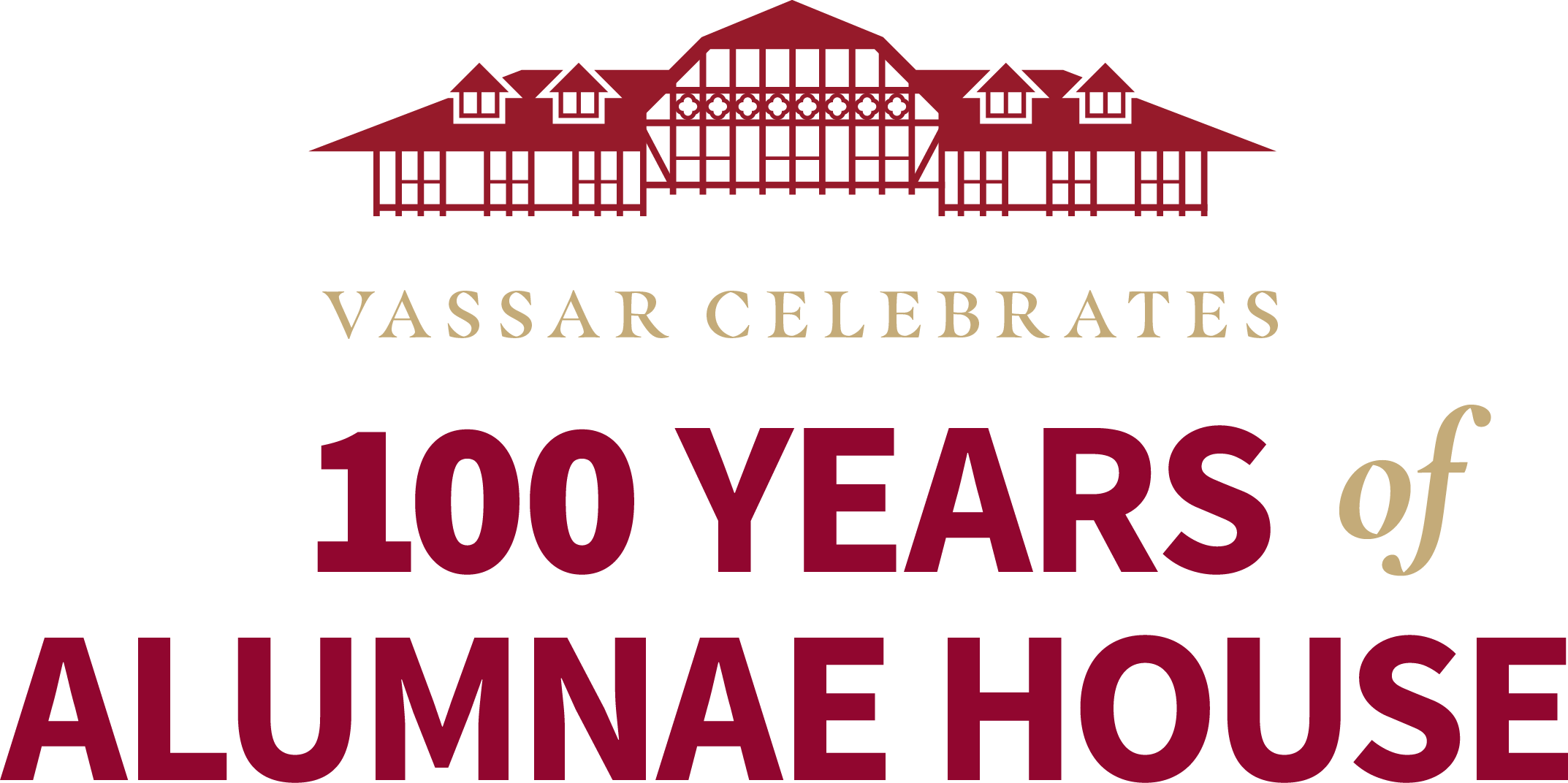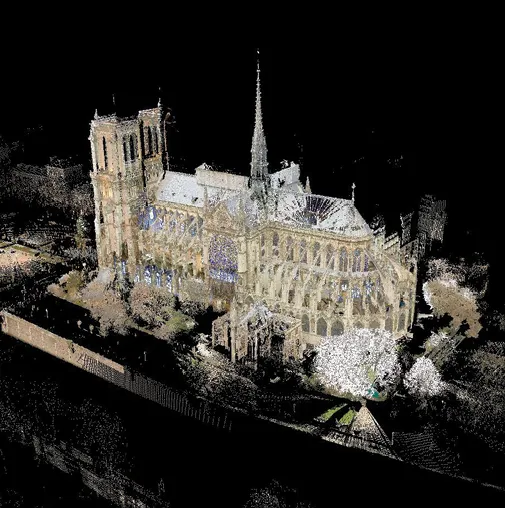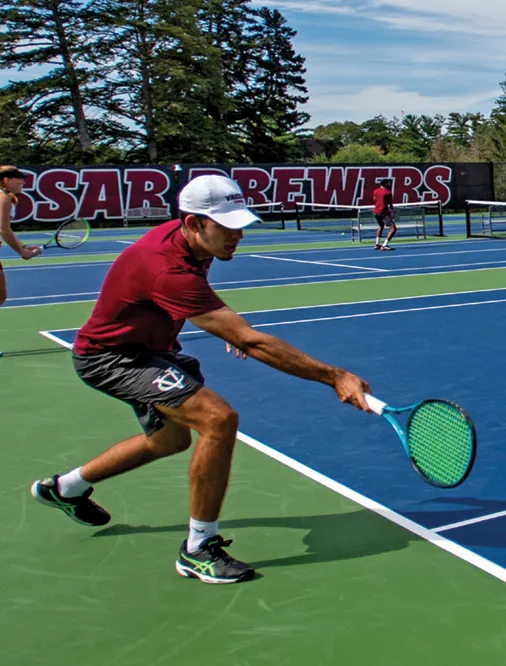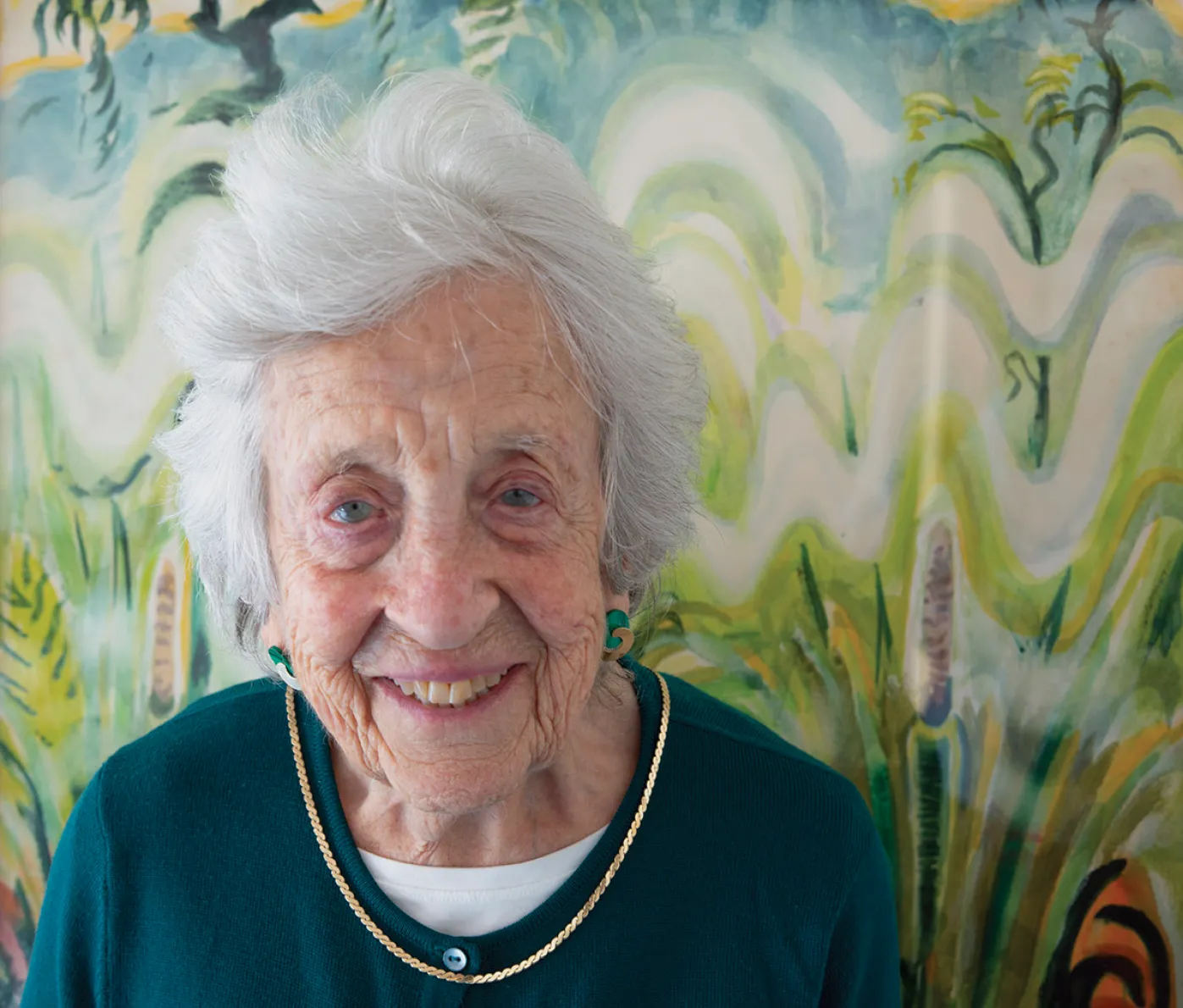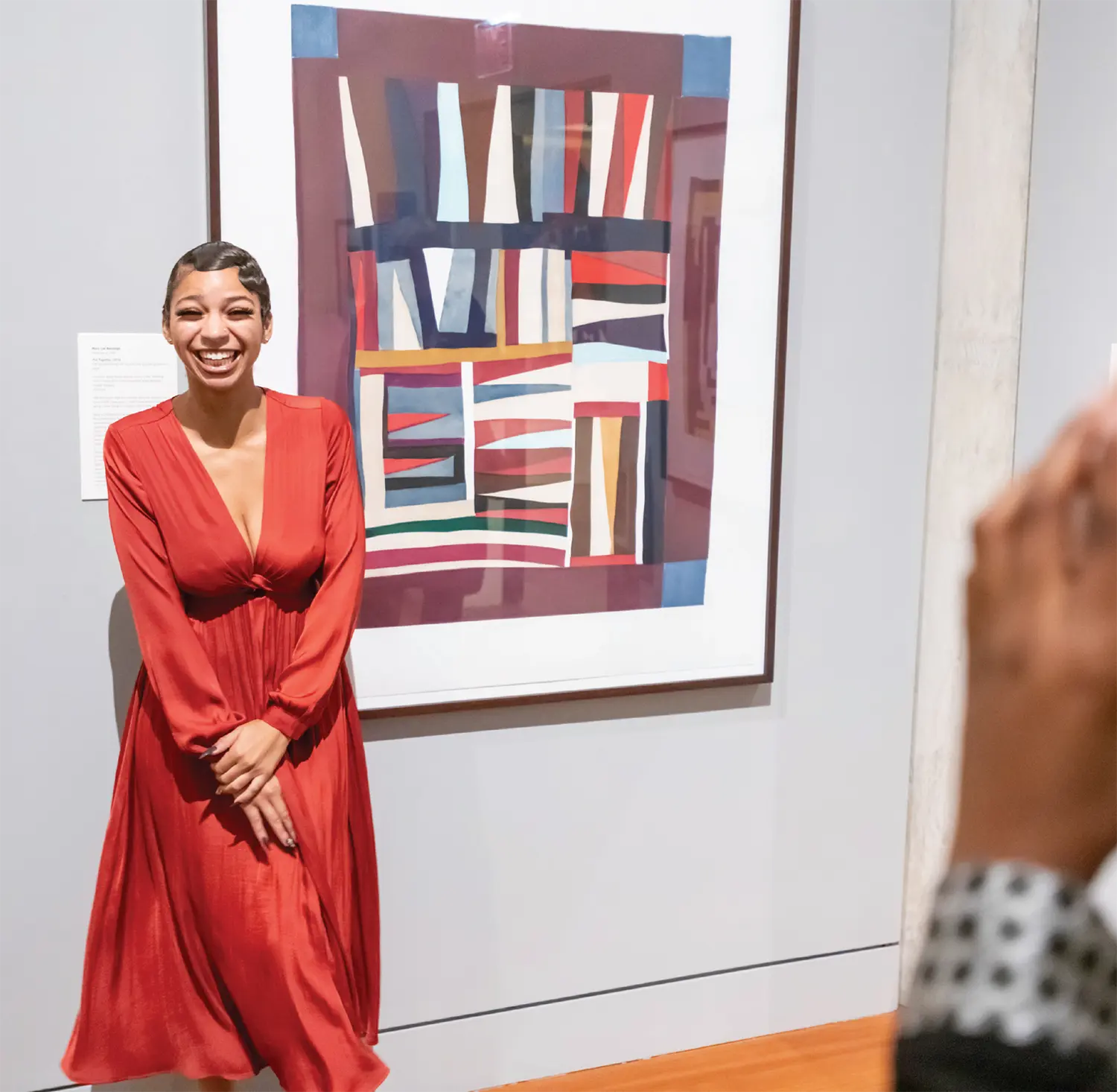VOLUME 119 ISSUE 3
THE ALUMNAE/I QUARTERLY
Contents
Features
Departments
Remembering Professor Anne Gittleman
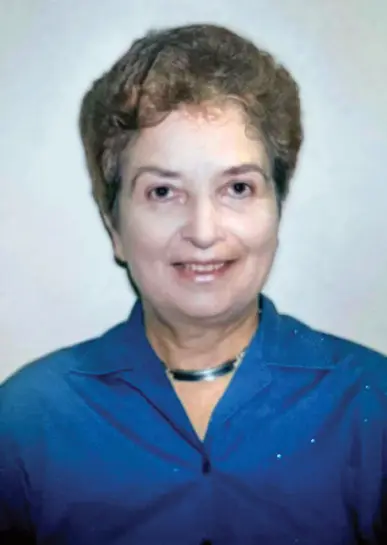
Anne taught at Vassar for 33 years (1954-87). I knew her first as a formidable presence in the Department of French and Francophone Studies (previously the French Department) when I was a student and later as a wonderful colleague when I joined the faculty.
Anne and I shared an office when I started teaching in Chicago Hall. It was a tiny space for two, and we had to be careful quite literally not to step on each other’s toes. Since we often corrected papers and exams side by side, I learned by osmosis: Underline every mistake, make just a few suggestions, encourage all rewrites.
A distinguished scholar, Anne is best known for her meticulous critical edition of Garin le Loherenc. It is a model of the genre. The fact is that she embodied high standards in whatever she did: teaching, scholarship, or service to the department and College. She was also a wonderful hostess, as evidenced by the many times Barney and she opened up their home to members of the Vassar community.
We missed her after she retired. She remains with us now as an inspiration.
Professor Emerita of French and Francophone Studies
A Real “Drag”
I see “drag” as a mockery of women and of female sexual expression just as “blackface” is considered a mockery of Black people today. Yes, both are forms of artistic expression.

I posed this issue to ChatGPT: “Why are drag performances not considered in poor taste as blackface performances were?” It gave a long, detailed answer that drag is okay but blackface is not supporting today’s norms. When pushed with the message: “But many people find drag performances offensive as a mockery of women and female sexual expression,” ChatGPT agreed it’s important to respect and engage with the diversity of viewpoints on this issue. The Vassar article dismissed noncelebratory reaction to drag performance as just “backlash” rather than addressing other points of view objectively.
Incidentally, I am a registered Democrat. Unfortunately, that is an important piece of information in this discussion.
Glendale, AZ
We value your feedback on the magazine’s content. Please send letters to vq@vassar.edu.

Let your classmates know what’s new with you at anytime via online Class Notes submissions.
Your note will be forwarded to your correspondent for inclusion in an upcoming issue. To submit your note for the Vassar Quarterly, visit:
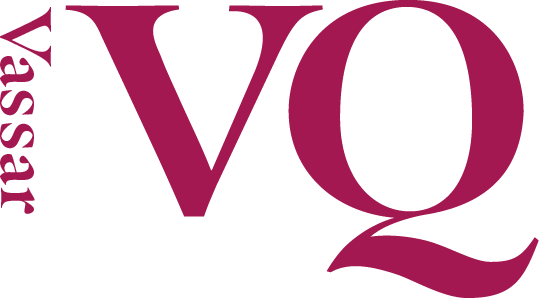
- Publisher
Alumnae/i Association of Vassar College
Monica Vachher ’77, President - Vice President, Communications
Victoria Grantham - Associate Vice President, Editorial and Publications; Editor, VQ
Elizabeth Randolph
elrandolph@vassar.edu - Art Direction and Design
Aidan Gallagher
Daniel Silva - Print Production
Daniel Lasecki - Class Notes
Nada Glick ’61, Coordinator
Joan Giurdanella, Copy Editor - Editorial Assistants
Sufana Noorwez ’24
Emilee Busby ’26 - Communications Advisory Committee
Justin Hergianto ’04, Chair
Anne Green ’93
Chip Reid ’77 - Editorial Offices
124 Raymond Avenue, Box 647
Poughkeepsie, New York 12604
845.437.5447 Fax 845.437.7239 - Postmaster
Send address changes to Central Records, Box 14, Vassar College, 161 College Avenue, Poughkeepsie, New York 12603 - Yearly Subscriptions $15
- Unsolicited Manuscripts
We discourage the submission of unsolicited manuscripts or stories written without prior consultation with the editorial office. However, we do welcome story ideas and pitches. Please email vq@vassar.edu with your suggestions. - Articles reflect the opinions of the writers and not necessarily those of the magazine, AAVC, or Vassar College. Vassar, the Alumnae/i Quarterly, is published in the spring, summer, and fall/winter by the Alumnae/i Association of Vassar College (AAVC).
- Mission
AAVC is a living bridge whose mission is to ignite powerful connections to Vassar, to each other, and the world. - Affirmed 2013.
Copyright © 2023 AAVC
Honoring History, Charting a Path to the Future

Today, Alumnae House anchors what is becoming a signature gateway to campus, which will now include the Vassar Institute for the Liberal Arts, The Heartwood (a 50-room inn featuring the Salt Line restaurant and the Night Owls bar), with Alumnae House presiding on the knoll. These three buildings, along with the Alumnae Lawn (now conserved in perpetuity) and thoughtful landscaping to enhance access and synergy of the area, make contemporary the age-old functions of hosting alums and guests, convening conversations, and enjoying the Vassar community over good food and drink. Yes, Vassar Devils will continue to be served.
The architecture of the Institute and Inn takes inspiration from Alumnae House. For instance, the subtle pattern in the Institute glass siding mimics the wooden timbers on Alumnae House. The shape of the Inn windows and dormers recalls the windows and dormers of Alumnae House, and a gentle accessible path through greenery connects the new structures with the older Alumnae House. This bringing together of the historical and the contemporary while thoughtfully considering their interrelationship is core to Vassar—the ability to honor tradition and be cutting-edge at the same time.
Vassar is a place where edges meet. And the collisions of ideas, ways of being, and beliefs can spark creativity. It can be rough—working at the boundaries where differences are in full view—but this is where novel advances emerge, where learning happens, and where transformation begins. The Institute and Inn will enable expanded programming (e.g., conferences, workshops, community engagement activities, lifelong learning efforts) for Vassar and broader local, regional, national, and global communities. And for those who cannot make it physically to campus, the Institute hosts a podcast called “Conversations at the Salt Line,” again prompting conversations where differences and edges in one’s life come together for learning. Recent guests have included Professor Eddie Glaude, Jr., Jason Blum, Chip Reid, Sasha Velour, Stacy London, and Margaret Hamburg.
In summary, the new addition to the “West Campus” builds upon the vision of Alumnae House while honoring its 100 years of convening. Together, this part of campus exemplifies the bringing together of disparate paths in a hospitable and inclusive environment to connect us all for the next 100 years and beyond.
Come visit!


President
President Bradley Awarded
Yale’s Highest Alum Honor

Bradley, who received her PhD from the Yale School of Public Health in 1996, was one of four recipients of Yale’s Wilbur Cross Medal, the highest honor the university bestows on its graduate school alums. Cross Medal recipients are nominated by peers in their field and then evaluated and selected through an internal review process at the Yale Graduate School of Arts and Sciences. Bradley accepted the award and delivered the Dean’s Lecture at the School of Public Health in ceremonies at the university on October 2.
In her talk, “Getting on the Balcony,” Bradley spoke of the many transitions in her career that began as an administrator at Massachusetts General Hospital, shifted to her graduate work, public health research and other leadership positions at Yale, and pivoted again to a series of global health initiatives that she has continued to carry out while serving as Vassar’s President since 2017.
“I love transitions—as much as they are unsettling, too,” Bradley said, “because they allow a time of disengagement and reengagement, and in that moment when one has disengaged from the previous work but not yet reengaged fully in the new work, all things are free, unencumbered, full of potential, open to what may be new. … Transitions, for me, are at the heart of learning.”
Bradley explained how she is currently applying what she learned while taking part in a research project in 2003 with Dr. Harlan Krumholz, a professor at the Yale School of Medicine, to a new project she and others at Vassar are currently undertaking. The original project examined how hospitals responded when heart attack patients were initially admitted.
“In 2003, only about a third of patients with lethal heart attacks received the angioplasty (or similar procedure for opening a blocked coronary artery) within 90 minutes of arriving at the hospital,” she said. “And opening that artery saves lives. We noted, however, that a set of hospitals were consistently getting it right—they were faster and more successful. And amazingly to us from our privileged perch, these were ‘no name’ hospitals.” The study led to changes in heart-attack protocols at hospitals across the country that have resulted in the saving of countless lives since then, Bradley noted.
Applying this methodology to a completely different subject, Bradley and a team of researchers at Vassar are currently analyzing policies and procedures at colleges that maintain much higher than expected graduation rates. “What are they doing differently? That’s our research question, and of course we want to learn and ideally spread whatever evidence emerges,” she said.
Bradley concluded her talk by reflecting on the patterns that have emerged in her life and career. “First, students have often been at the center of change for me. They often do not know it, but they have opened many doors in unexpected ways,” she said.
“Second, the pursuit, rather than the attainment, of truth seems crucial. At the height of accomplishment, I have moved to open a new area of inquiry. It is not for everyone, but it has made for a meaningful journey for me.
“And last, if change is the throughline of this talk and my career, I must end in paradox—as all this change has been possible due to the tremendous stability that has come from my love-filled marriage to John, the stability of our health—which we all know is so important—and the many institutional and personal supports that Yale and the academy at large have provided me.”
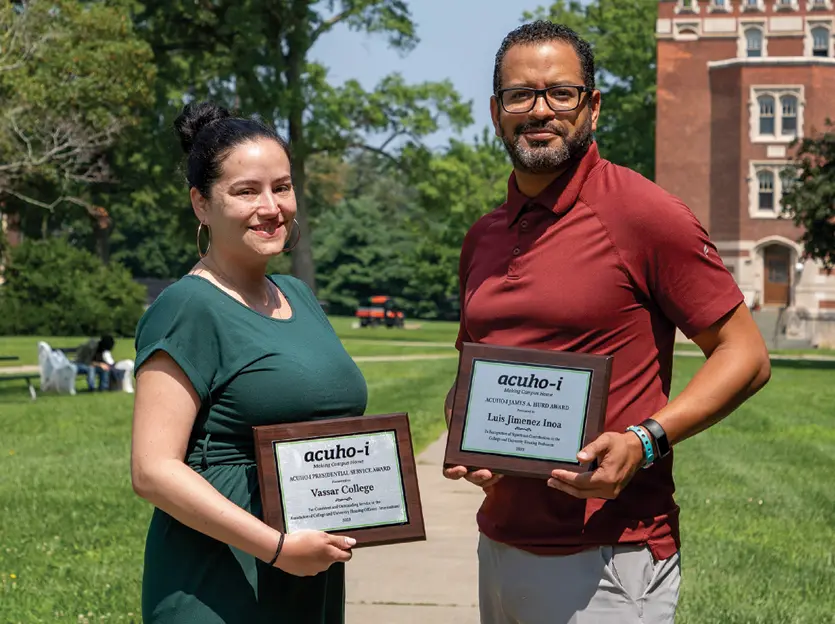
“Small but Mighty”
Current ACUHO-I President Leon McClinton presented the President’s Service Award to the College at the organization’s annual convention this summer in Portland, OR. Luis Inoa, Dean of the College for Residential Life and Wellness, right, accepted the award for the College and collected accolades of his own. Having earned the President’s Individual Award for service to ACUHO-I last year, this year Inoa was the recipient of the James A. Hurd Award, which recognizes outstanding contributions by a professional of color.
Inoa serves as Co-Chair for the Future of the Profession, Supporting Mental Health imperative and is the incoming chair of the Small Colleges and Universities Network. Yetty Marquez-Santana, Vassar’s Director of Residential Education, who also attended the event, serves as ACUHO-I’s Director of Inclusion and Equity.
As he announced the award, McClinton referred to Vassar as “a small but mighty college in the northeast that has become a tried-and-true friend of ACUHO-I. My thanks go out to Vassar for sharing these talented individuals with us and serving as a model for what an engaged member institution looks like.”
“You don’t do this work to earn an award,” Inoa concluded, “but to be recognized by our peers puts Vassar on the map as a small college that does lots of good work.”
Renowned Filmmaker and Cinematographer on Success in the Biz
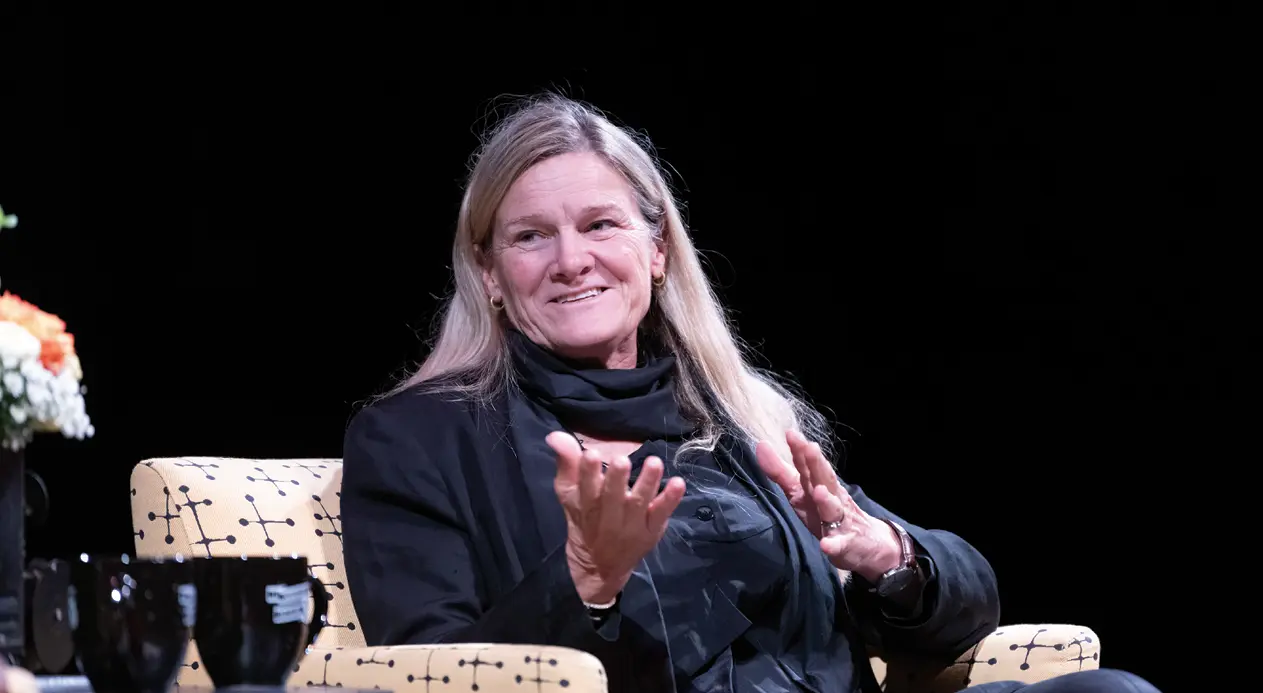


and Vassar’s Uniquely Beautiful Campus at
Convocation 2023
“The fundamental role of a college campus is to foster intellectual discovery, creative thinking, a sense of community, and discourse,” Elet told the more than 1,200 attending the 158th annual event. “It is a place that provides a sense of safety and belonging; and at the same time, a healthy jolt of disorientation to provoke new modes of thinking. It is a laboratory for learning.”
Professor Elet led her audience on a virtual tour of campus elements, noting that “the collection of buildings, landscape elements, and the enduring tree canopy all contribute to the distinctive character or spirit of the place—its genius loci. The campus is a tangible expression of the College’s identity, where physical setting serves to express intangibles of character and meaning.”
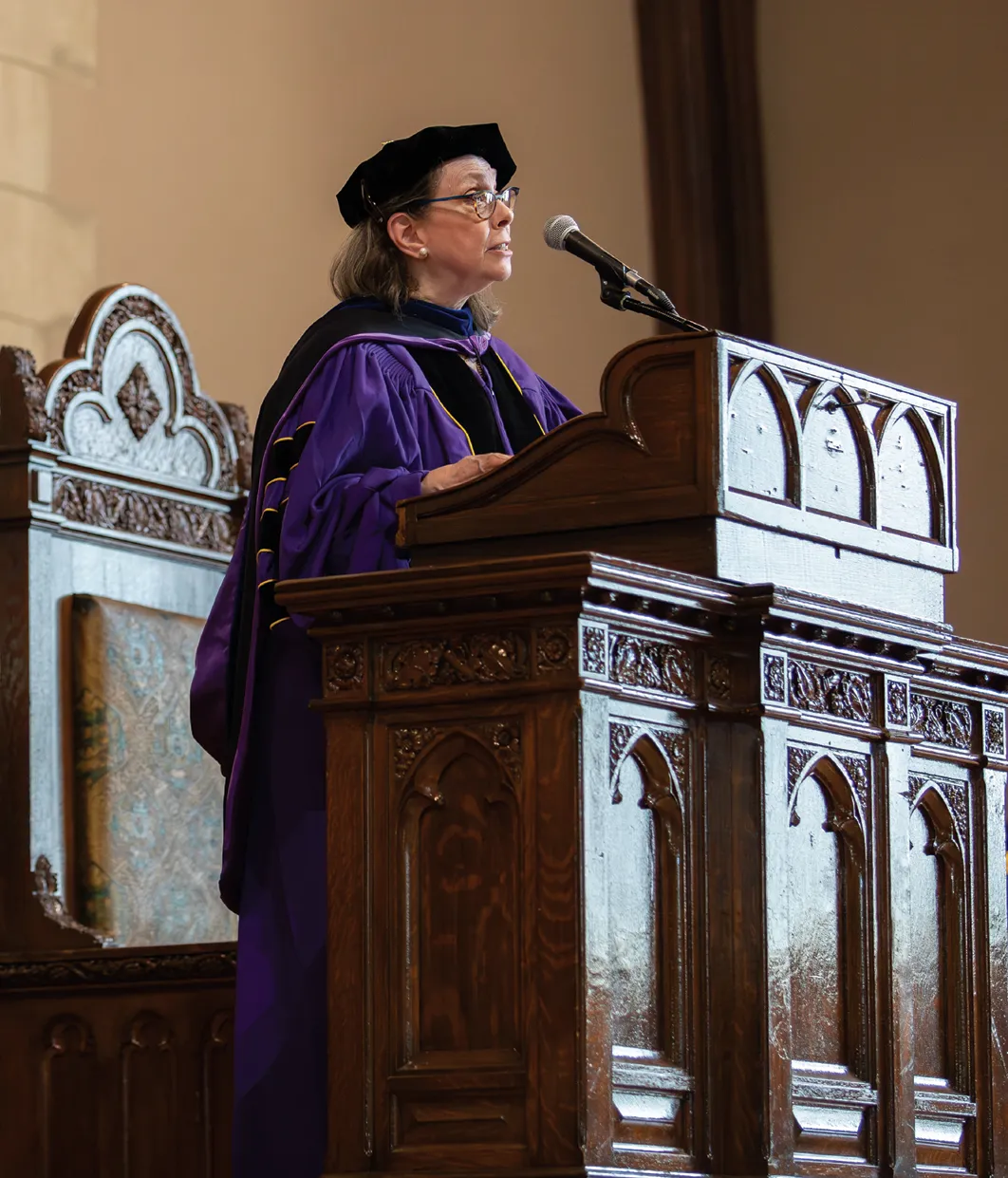

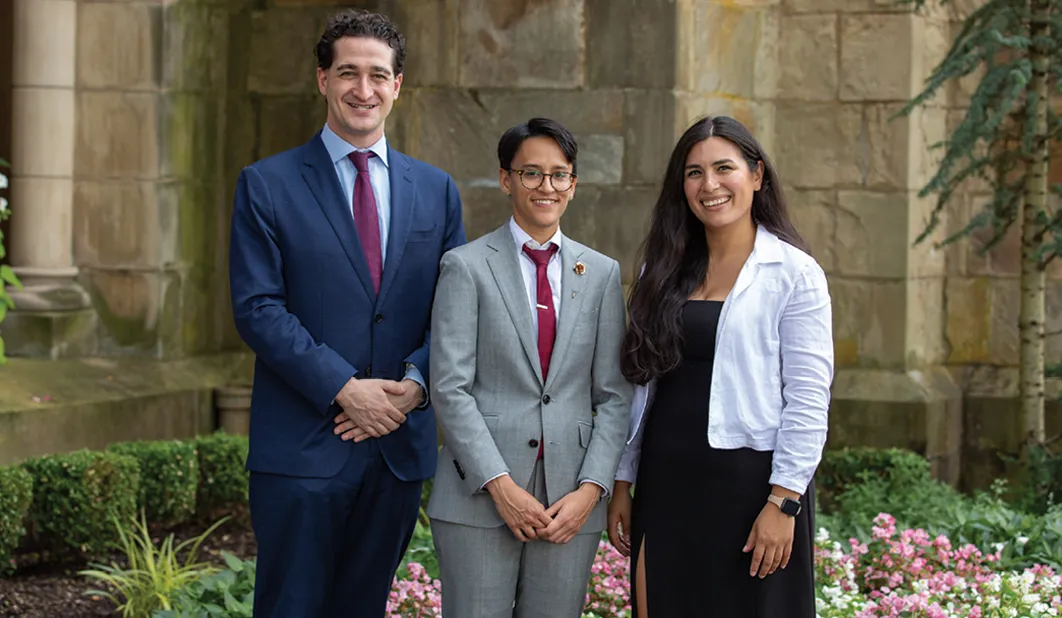
As the class of 2027 filed into the Chapel clad in the caps and gowns they will wear again four years from now, they were greeted by the music of organist Gail Archer, then a riveting performance by the Convocation Choir that President Elizabeth H. Bradley said brought tears to her eyes.
During Convocation, President Bradley announced the seven new recipients of faculty endowed chairs. They are:
Professor of Art, the Isabelle Hyman Chair
Kathryn Libin
Professor of Music, the Mary Conover Mellon Chair
Colette Salyk
Associate Professor of Astronomy, the Maria Mitchell Chair
William Hoynes
Dean of the Faculty and Professor of Sociology, the Jane Baker Nord ’42 Chair
Laura Haynes
Assistant Professor of Earth Science, the Mary Clark Rockefeller Chair
Molly McGlennen
Professor of English, the Anne McNiff Tatlock ’61 Chair
Ming-Wen An
Professor of Mathematics and Statistics, the Elizabeth Stillman Williams Chair
Priya Nair ’15, Deputy Chief Diversity Officer in the Office of New York Governor Kathy Hochul, echoed the themes of community and personal growth while accepting the Young Alumnae/i Achievement Award, presented annually by the Alumnae/i Association of Vassar College (AAVC). “I am so grateful to Vassar, because it is a huge part of where I am today,” Nair said. “Vassar gave me skills like writing and research, but also skills of relationship building, of being curious about other people, and most importantly, of being authentically me.”
Nair said they were eager to see how the undergraduates seated in the Chapel before them would tackle the world’s challenges upon leaving the campus. “Please know you will always have me in your corner,” they said. “I can’t wait to see all the ways you will transform yourselves and transform the world.”
Nair received the award from Stephanie Goldberg ’14, a member of the AAVC’s Recognition Committee and AAVC Vice President Brian Farkas ’10, who reminded members of the Class of 2027 that “Vassar is not a four-year experience. Vassar is with you for a lifetime.”
Olivia Gross ’24, President of the Vassar Student Association, urged her fellow students, particularly members of her class, to make the most of the coming year. “When we come back to Vassar, it should be with no regrets,” Gross said. “College is about connections and support. This is our college experience, and we have the power to make it the best it can be.”

Kelly Marsh
Grants in Action!
The Leica Stellaris 8 is a next-generation confocal microscope that will transform faculty and student research opportunities at Vassar and other Mid-Hudson regional colleges. It is scheduled for delivery in December and is expected to be fully operational for research projects across multiple disciplines by spring, said Bergstrom, who lead a multiyear proposal submission process.
“Twelve faculty members in five departments contributed to writing the grant proposal,” Professor Bergstrom said. “That demonstrates just how much this microscope will be used. It’s a real workhorse that we will use in our day-to-day teaching as well as in our research.”
Professor Zupan said she was looking forward to using the new microscope in student-led projects in her lab. “Imaging with the old microscope is so time-consuming—it takes 90 minutes to perform a procedure that will take eight minutes on the new one,” Professor Zupan said. “With its capacity to complete more projects more quickly, the new microscope will enable more students to be trained on confocal microscopy techniques, which will hopefully make them more excited about participating in research. This acquisition is a real game-changer for a lot of us.”
Associate Professor of Biology Jennifer Kennell, who co-wrote the grant proposal with Bergstrom and Associate Professor of Psychological Science Bojana Zupan, said the grant calls for Vassar to share the use of the microscope with other college faculty and students in the region. This collaboration is consistent with ongoing Vassar faculty collaborations with science faculty at other institutions in the Hudson Valley.
Members of the science faculty at two local colleges said they were also looking forward to using the microscope for their research. “This [microscope] will be a real community resource,” said Megan Dennis, Associate Professor of Biology at Marist College.
Lydia Bright, Professor of Biology at SUNY New Paltz, said she was eager to use Vassar’s new acquisition for her own research. “I look at live cells and need to see how proteins move around, and this microscope is ideal for my work,” Bright said. She said she planned to bring some of her students to Vassar as well. “It will be good for them to see some cutting-edge technology that they may encounter in grad school or later in their careers,” she said. “It will be good for them to be able to say that they have used this kind of technology.”
The Preserve at Vassar Gets New Trees
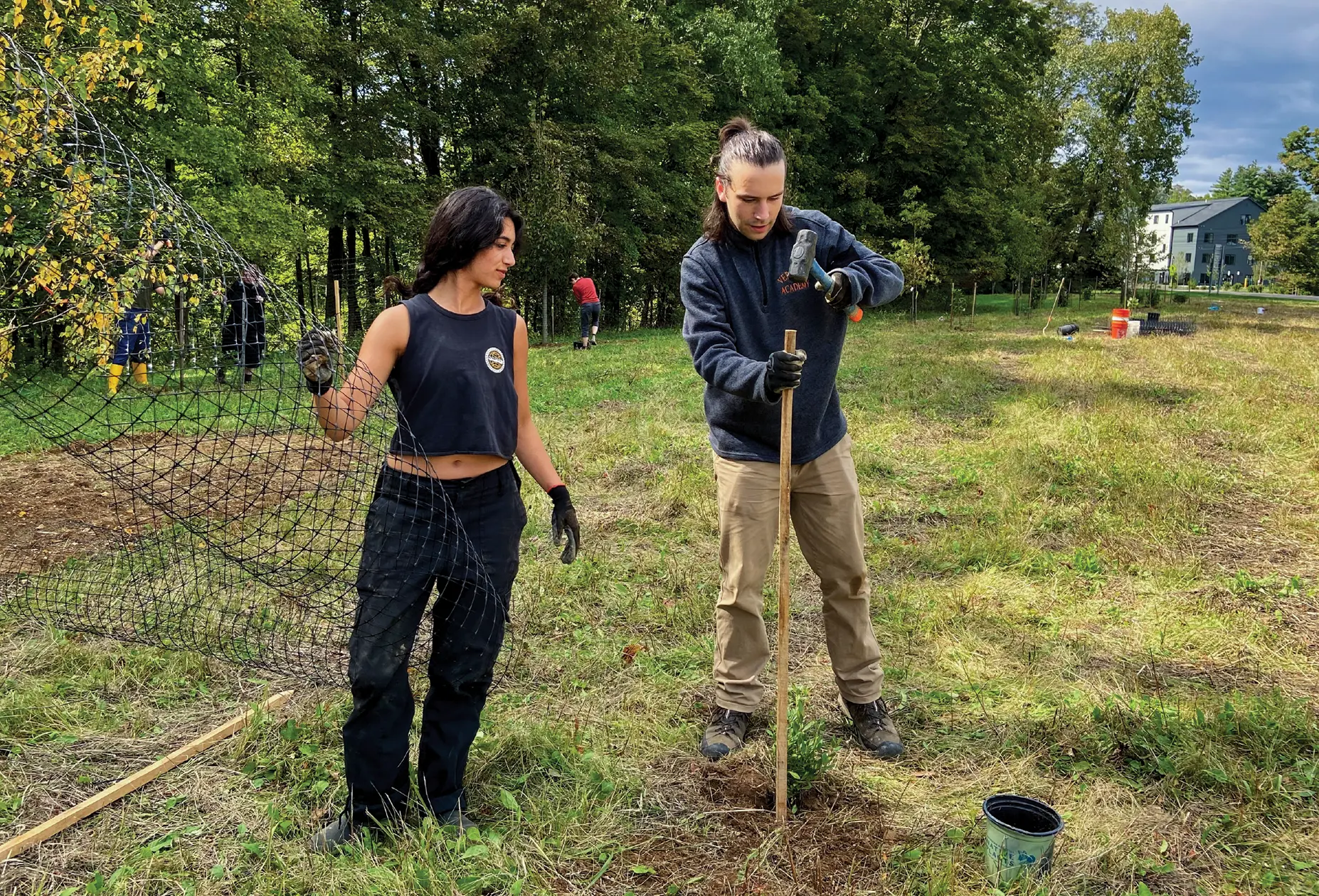
Vassar’s Historic Musical Performances Get New Life in Digital Recordings
A $40,000 grant from the Mellon Foundation through the Council on Library and Information Resources “Recordings at Risk” program enabled the College to digitize nearly 300 performances recorded on phonograph records, tapes, and compact discs between 1934 and 2016. They are available for listening at Vassar’s Digital Library by members of the Vassar community; educators and researchers may request access by emailing library_systems@vassar.edu. The recordings include formal concerts, Vassar class “parties” (original musical plays), a cappella group performances, school songs, and collaborations between Vassar faculty, students, and choral groups from other colleges and universities.
“Recordings at Risk” is a limited-term (2017-2025) national regranting program to support preservation of rare and unique audio, audiovisual, and other media through digital reformatting. The digitization was done by firms in Philadelphia, PA, and Andover, MA.
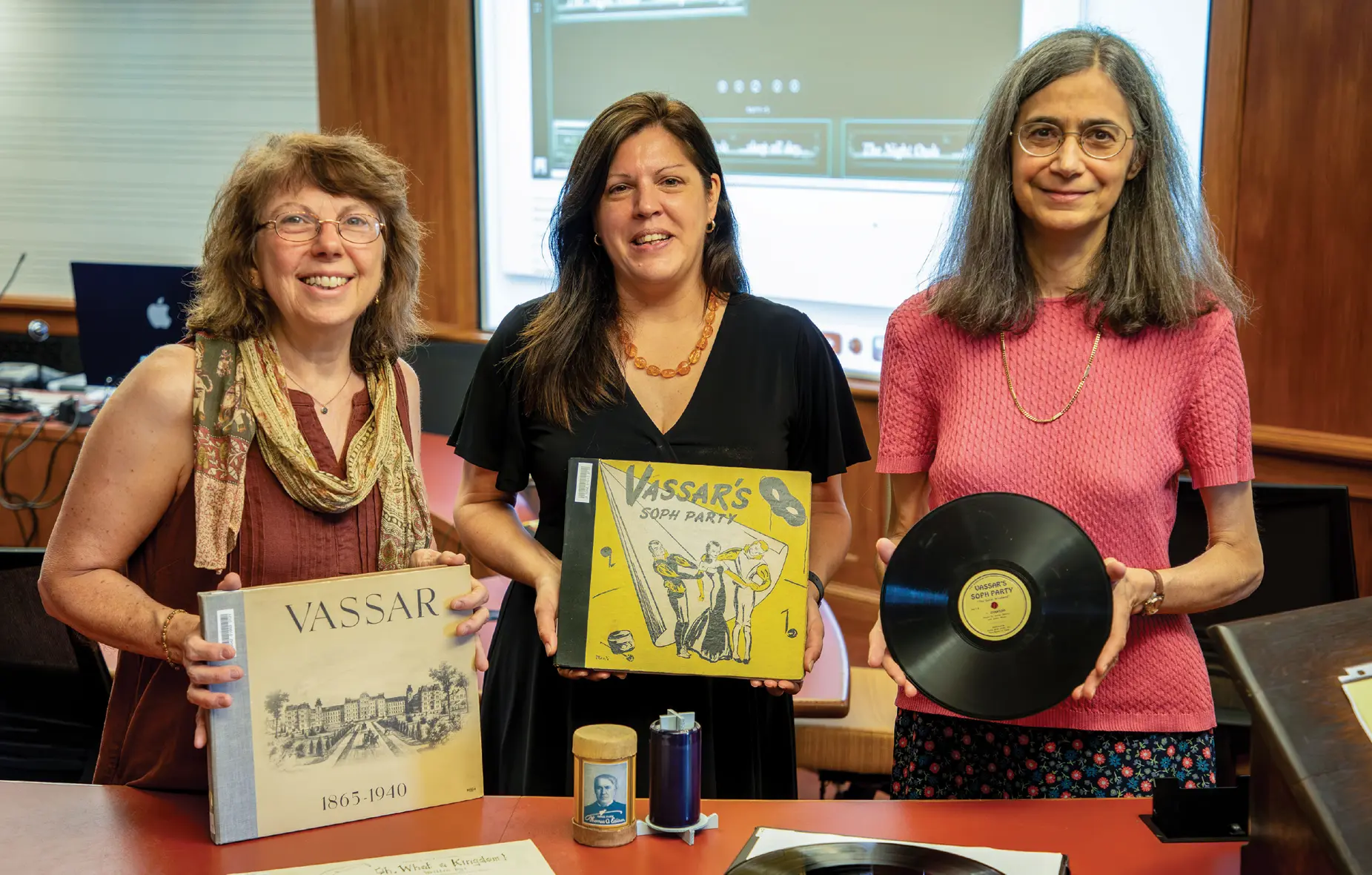
Buck Lewis
Vassar Professor Awarded Climate Research Grant
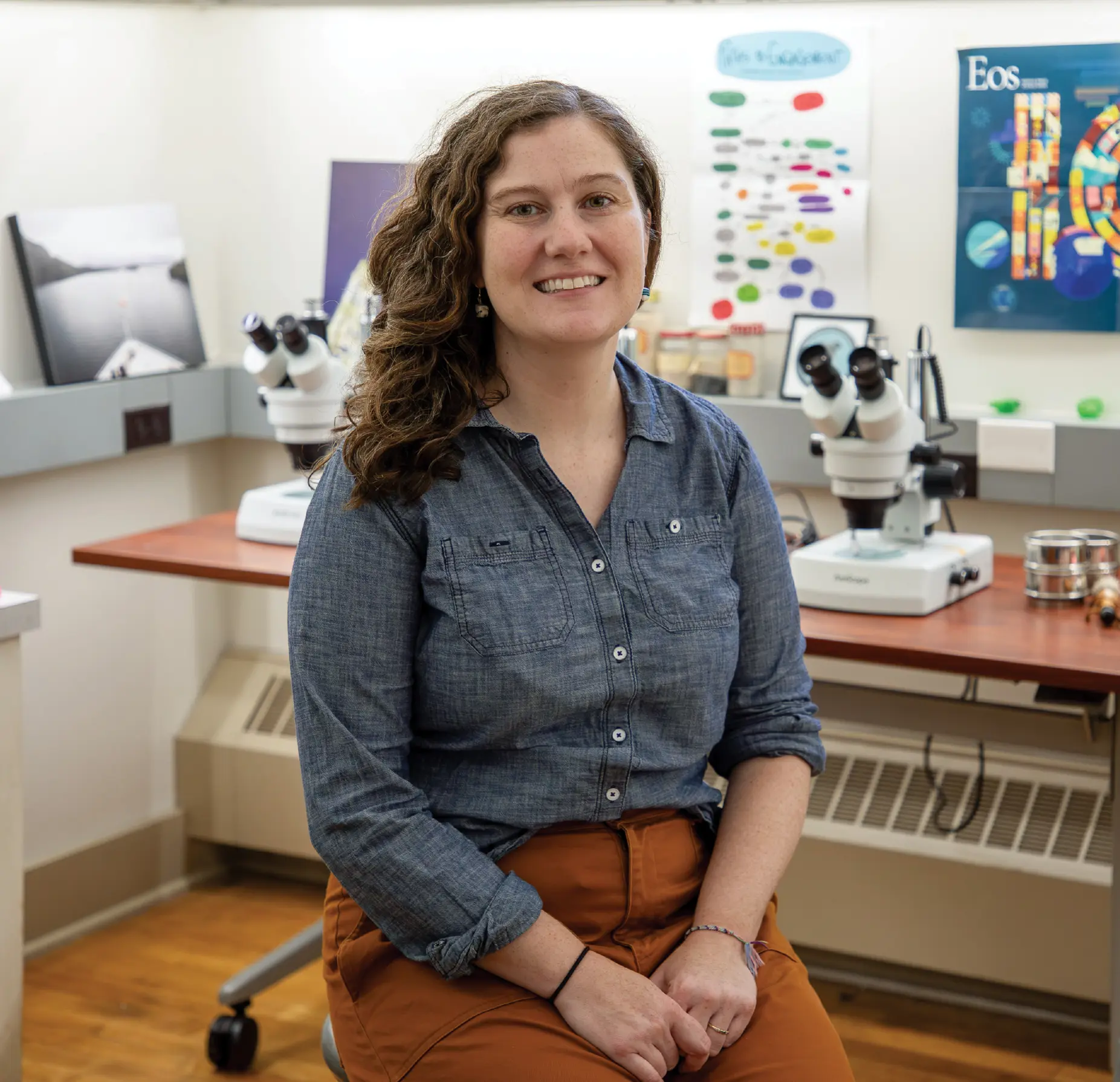
Haynes, along with Jennifer Fehrenbacher, Associate Professor of Earth, Ocean, and Atmospheric Sciences at Oregon State University, and Emily Osborne, a Research Scientist at NOAA, will collaborate on a study. It will assess how proposals to use the ocean to combat the rise in carbon-dioxide levels in the atmosphere will affect marine organisms. Some are proposing to dump alkaline minerals into the ocean to help it absorb and store more carbon dioxide, but the impacts of these actions on marine life remain largely unknown. Haynes, Fehrenbacher, and Osborne will investigate how adding these minerals to the ocean would affect foraminifera—small, shell-building plankton that are important to the ocean’s carbon cycle.
Haynes, who has been studying foraminifera throughout her academic career, said the grant would fund research she will be doing at the Bermuda Institute of Ocean Sciences in summer 2025 and 2026. She will recruit four Vassar students each year to assist her in her research. The grant is part of a $24.3 million project funded by the National Oceanographic Partnership Program, a consortium of public and private organizations including NOAA, the National Science Foundation, the federal Department of Energy, the Office of Naval Research, and the ClimateWorks Foundation.
Lumina Grant to Shine Light on College Success
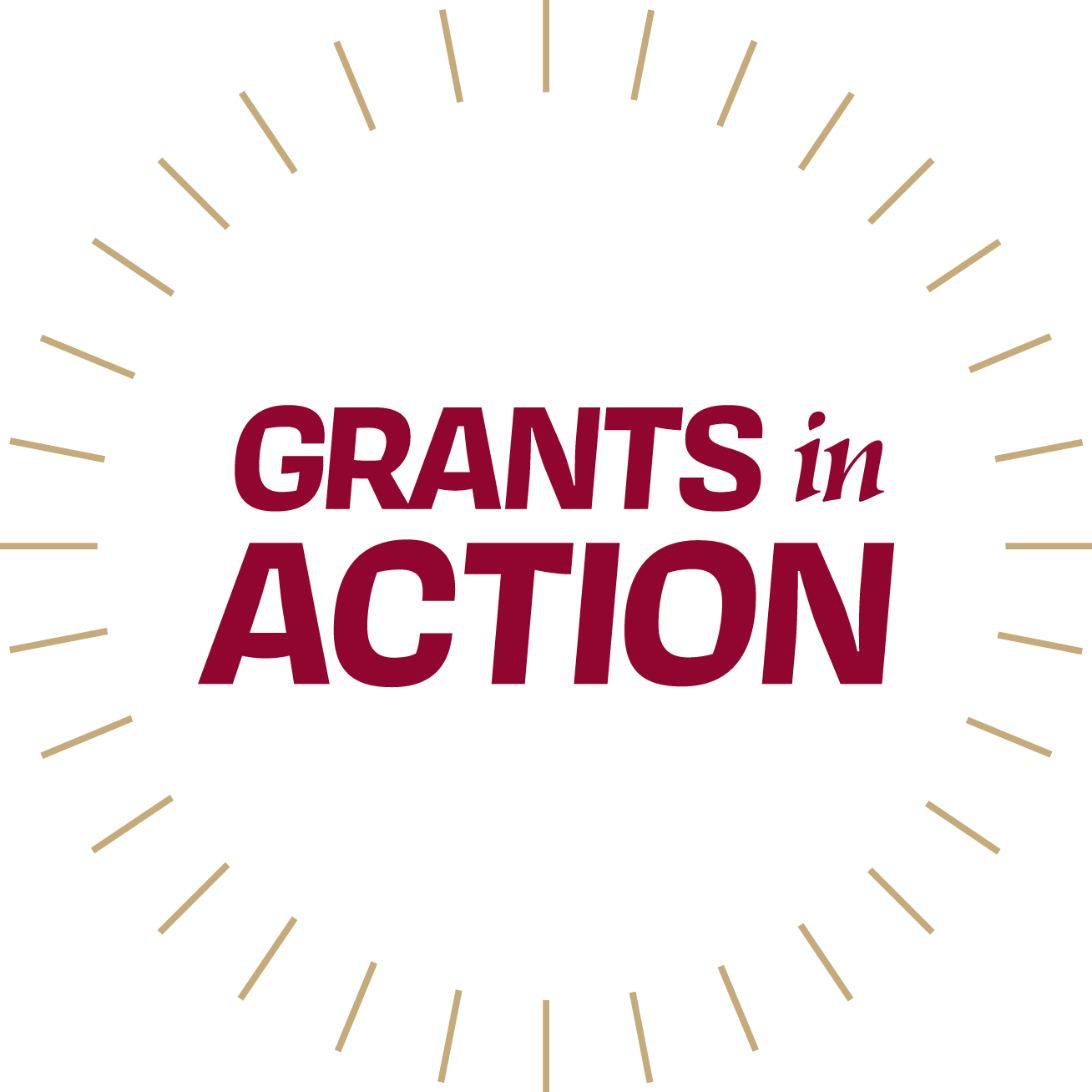
Bradley will be joined by Wendy Maragh Taylor, Associate Dean of the College for Student Growth and Engagement, and Professor of Education Christopher Bjork as lead investigators on the project. Charlotte Gullick, Exploring Transfer Together Program Manager, and Biniam Tesfamariam, Vassar’s Director of Institutional Research, are the other members of the team. They plan to visit six institutions having greater than expected results over the next 12 months, meeting with faculty, students, and administrators to gather relevant data.
The Lumina Foundation is an independent, private foundation in Indianapolis committed to making opportunities for learning beyond high school available to all. Lumina envisions higher learning that is easy to navigate, addresses racial injustice, and meets the nation’s talent needs through a broad range of credentials. The foundation aims to work toward a system that prepares people for informed citizenship and success in a global economy.
Connecting Alums:
“Multicultural and Affinity Engagement Virtual Events” kicked off in October, Latinx Heritage Month, with an event featuring Dr. Natasha Gordon-Chipembere ’92, author of the award-winning historical novel Finding La Negrita. She spoke about Costa Rica’s Afrodescendiente heritage, its contemporary expatriate community, and how her background as a child of Costa Rican/Panamanian immigrants influenced her writing.
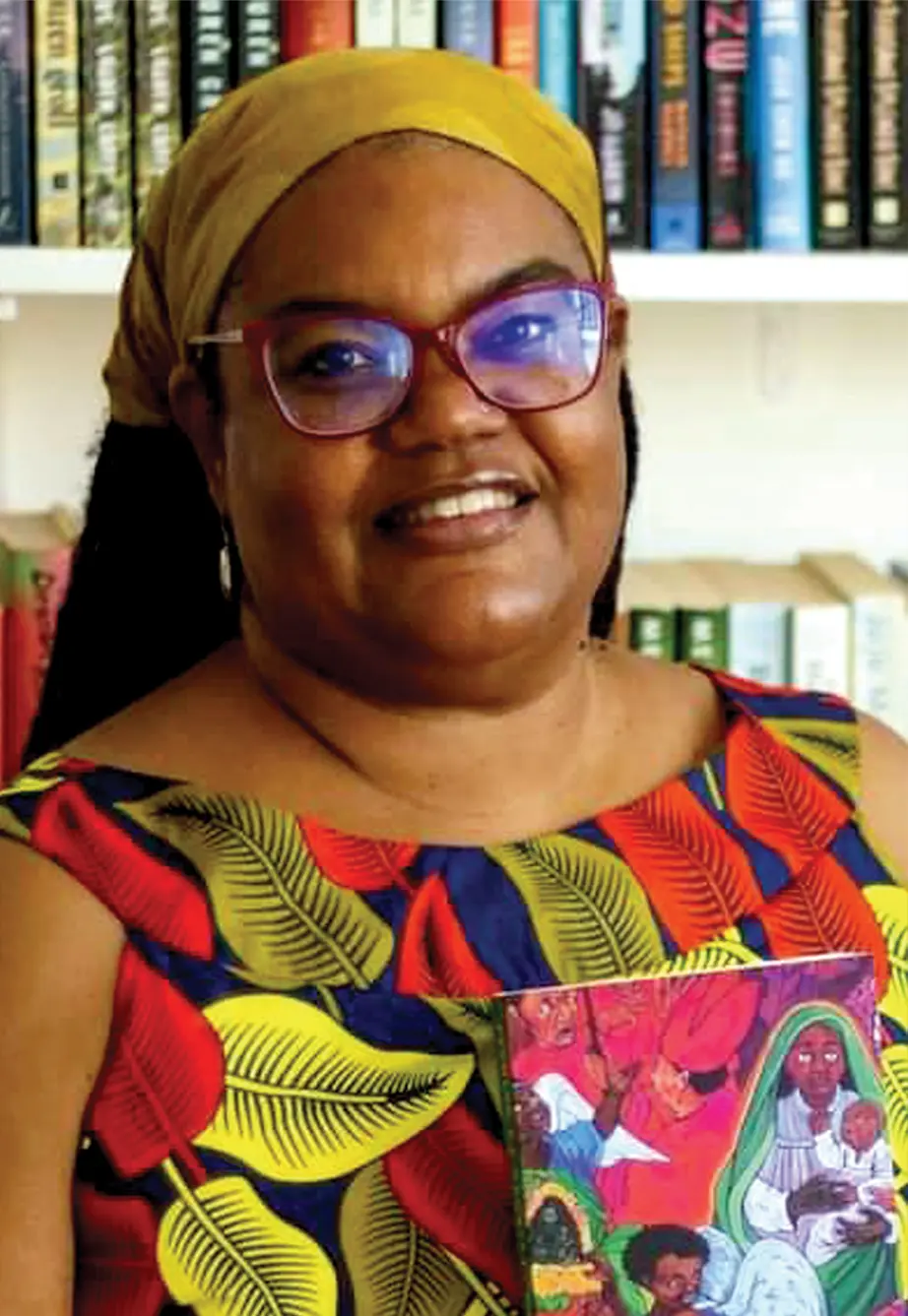
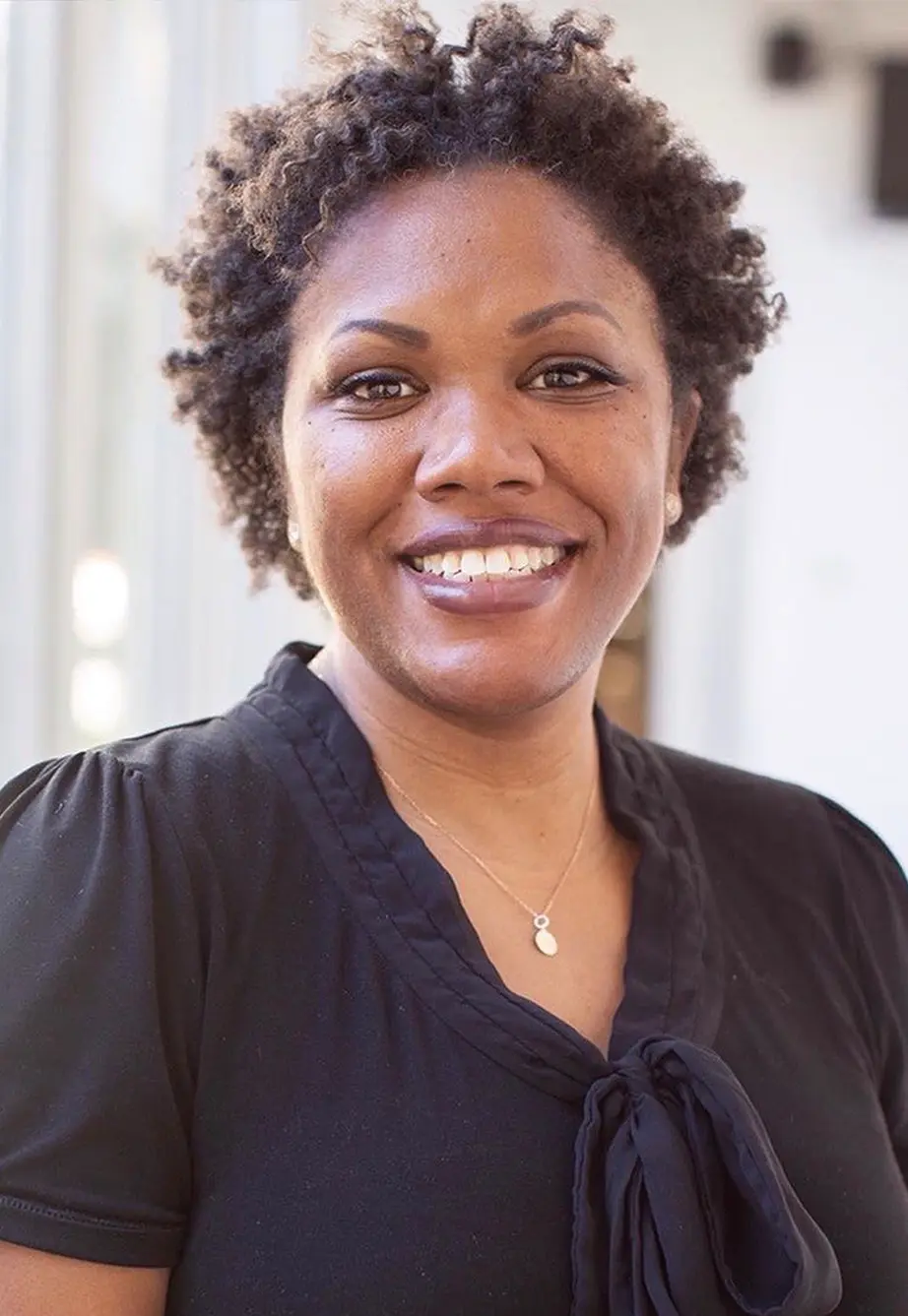
Courtesy of the subjects
“These events are a testament to our commitment to honoring the diversity of Vassar experiences and providing engaging opportunities for our valued alums,” said Parkinson. “What it gives them, I feel, is something that speaks to them personally.”

The initiative strives to deepen connections and foster engagement among Vassar alums, celebrating shared experiences and diverse backgrounds.

Parkinson and her intern/event producer, Arily Velasco ’25, want to involve more alums in generating program ideas and urge those with ideas regarding affinity-based programs that would appeal to a wide-ranging audience at various life stages to email vassaraffinity@vassar.edu.
Other events—open to all alums—are in the works and will be announced soon. Follow @VassarAffinity on Twitter and Instagram, download the Vassar Mobile App, or watch for invitations in alum inboxes for more information.
2027
Vassar’s Newest Class by the Numbers
-
62%
Identify as female
-
38%
Identify as male
-
A
Grade point average
-
14.2%
Are the first in their families to go to college
-
36%
Of domestic students identify as people of color

-
33%
Are bilingual or speak English as a second language
-
49
Languages are spoken in addition to English
-
18%
Are Pell Grant recipients
-
$20.8M
Vassar scholarship funds awarded to the class
-
$55,857
The average Vassar scholarship award
Activities
-

Were leaders in their high school’s student government -
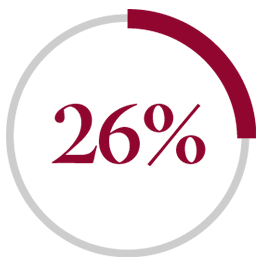
Played a musical instrument -

Participated in drama productions -

Were captains of a varsity sport -

Held a job while in high school.
And there’s more!
Among their ranks are individuals who:
-

Danced in the Bolshoi and Joffrey summer ballet intensives. -

Took a gap year to act in a Tony-award-winning Broadway play. -

Was founder and president of their school’s reptile club. -

Fostered 12 pugs over 7 years as part of a regional pug rescue group. -

Taught windsurfing. -

Is a social media influencer who reviews cookies.

The Frances Lehman Loeb Art Center Celebrates 30 Years and a Continuing Legacy
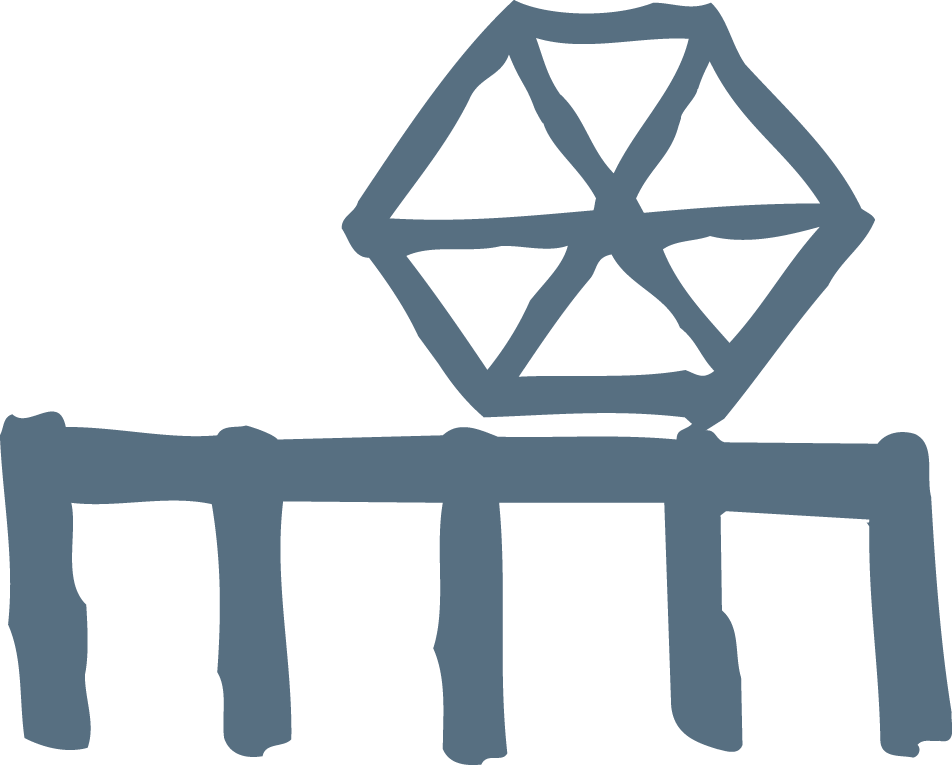

The overall complex of structures, incorporating both the new edifice and the renovated Taylor Hall (site of the Art Department, its classrooms, and library), serves as the entrance to the campus alongside the Frederick Ferris Thompson Memorial Library fronting on Raymond Avenue. The two connected buildings reinforce the importance of the visual arts and other academic resources in promoting the open exchange of ideas and inquiry in a liberal arts education. As an example, among the almost 30,000 visitors to the Loeb last year, there were 4,492 students from 22 different departments and programs for nearly 250 class sessions (about half of which were in the arts). Moreover, in addition to the hundreds of works of art regularly on display, 619 objects were temporarily pulled from storage to support teaching in the building’s galleries and classrooms.
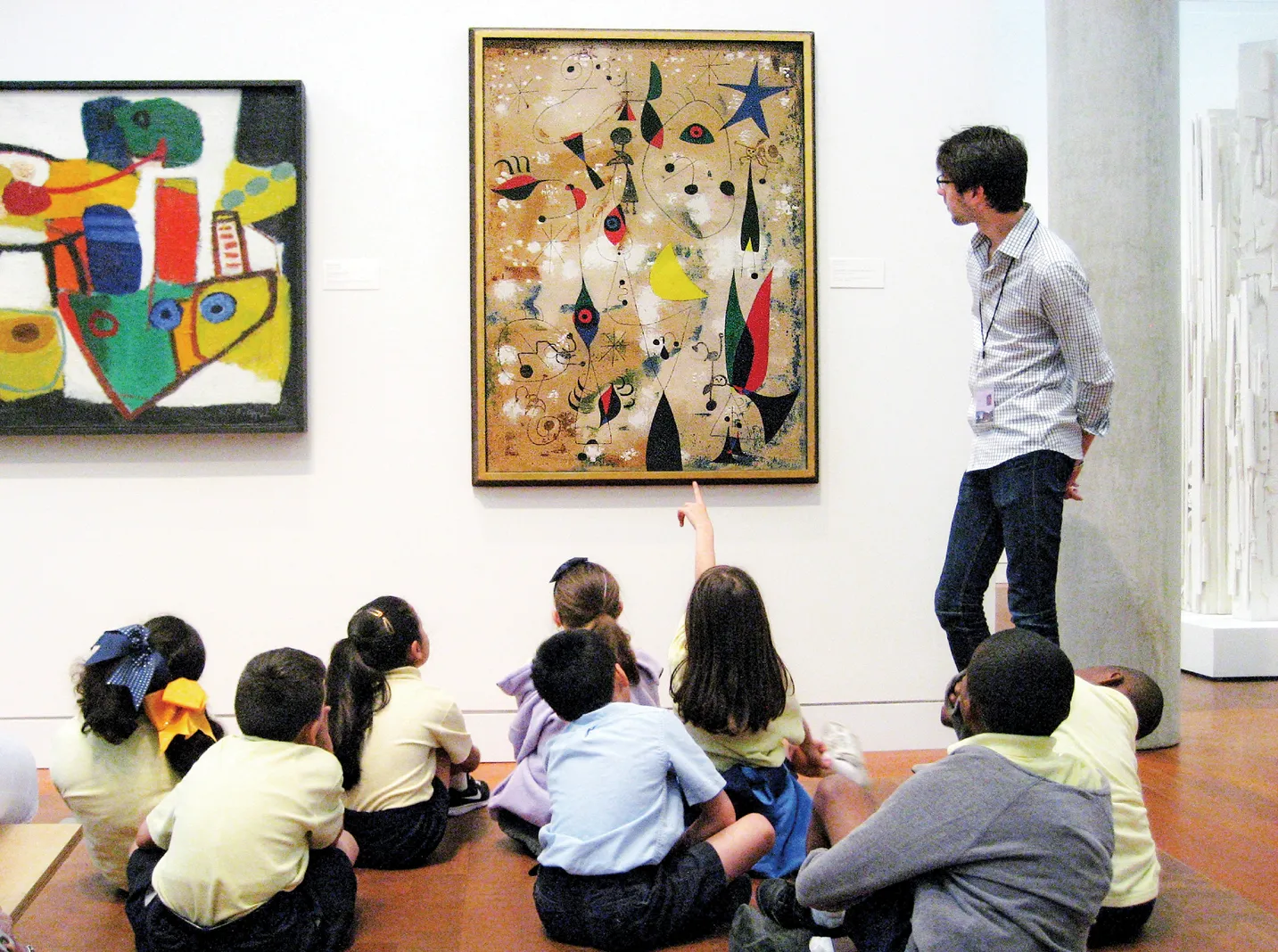

The prominent location of the Frances Lehman Loeb Art Center intentionally forges a vital link to neighboring communities. The recent expansion of its outreach efforts—including partnerships with the Poughkeepsie City School District, Arlington Central School District, The Art Effect, Celebrating the African Spirit, Dutchess County Historical Society, Locust Grove Estate, and the Poughkeepsie Public Library District—was recognized last June when the Loeb received the Dutchess Award. The accompanying proclamation celebrated its “enriching educational programs and unwavering commitment to fostering creativity and cultural appreciation [that] have greatly enhanced the quality of life for residents of the County and beyond.”
When the Vassar Quarterly, in 1990, announced that Frances Lehman Loeb, class of 1928, would provide funding for a new museum—the largest gift ever bestowed on the College by a living individual to date—she was lauded for her generosity:
“All her life she has loved art, been inspired by it, and made it accessible to others.” Today, after 30 years, the Frances Lehman Loeb Art Center continues to honor a woman whose life of philanthropy and public service embodied the ideals of liberal learning and bolsters the reputation of her alma mater.

Lynn Straus ’46: A Life of Giving
After graduating from Vassar, Straus received her Master of Science degree from Bank Street College of Education. She was director of the Village Fours in Mamaroneck, New York, which became the model for the Head Start program. She met and fell in love with her late husband, Philip Straus Sr., and they shared 54 years together before his passing in 2004.
The Strauses were ardent philanthropists, often gifting Vassar and Harvard University (Philip’s alma mater) works of art and contributions to support annual giving, special capital projects, and endowments. Lynn dedicated her time to Vassar by serving as a member of the Board of Trustees and on her Class Reunion Gift Committee. She and Philip supported the renovation of campus buildings, including the restoration of Gordon Commons Dining Hall’s second floor ceiling to its original architectural splendor. They were the lead donors to the Exploring Transfer program, an initiative to give community college students a chance to explore opportunities at a four-year liberal arts college.
But the Loeb held a special place in Lynn Straus’s heart.
For years, Straus was an active member of the Friends of Frances Lehman Loeb Art Center. She played a pivotal role on its advisory board for nearly a decade. In honor of her 50th reunion, the Strauses endowed the Philip and Lynn Straus Curator of Prints and Drawings position, currently held by John Murphy.
Beginning in 1983, the couple donated countless works of art from artists such as Edvard Munch, Albrecht Dürer, Helen Frankenthaler, and more.
“Their impact has been truly transformational,” said T. Barton Thurber, the Anne Hendricks Bass Director and Lecturer in Art for the Loeb Center. “Ranging from old master prints to German Expressionists, all of the nearly 50 objects are of the highest quality and many are unique examples by some of the greatest artists in the history of art. The opportunity for Vassar students, faculty, and other visitors to examine and enjoy these objects firsthand is immensely meaningful, and creates a lasting legacy for generations to come.”
At her memorial service, Philip Straus Jr., one of Lynn and Straus Sr.’s children, asked the crowd of roughly 150 people to stand if his mother’s generosity had helped any person or family get through school.
“I think a third of the audience stood up. She really cared about helping other people,” Straus said. “My parents were very connected to the Jewish tradition of giving and being good to other people. She stayed involved in Bank Street and Vassar because of her connections and because of how important she thought education was for other people.”
Lynn Straus’s bequest gave Ruby Funfrock ’24 the opportunity to experience masterworks of art firsthand. As the summer 2023 Ford Scholar/Pindyck Fellow at the Loeb, Funfrock had two main projects: looking into 1930s photographs and prints for a fall display and exploring Lynn Straus’s bequest.
“For a summer project, we had Ruby focus on one aspect of the gift: the prints by Edvard Munch and the German Expressionists inspired by him,” John Murphy, who worked closely with Funfrock over the summer, said. “Those works connect to the longer German woodcut tradition, which are also represented in works Lynn has given over the years, including a magnificent early 16th-century chiaroscuro woodcut by Hans Wechtlin.”
Funfrock had originally come to Vassar interested in studying biology before making the leap to art history. She dreams of working in a museum after graduation.
“It’s wonderful,” Funfrock said in July. “It’s honestly a dream come true. This is my first experience gaining hands-on training with prints. So it’s been a really lovely summer. I think it enriches my Vassar education.”
Funfrock has spent time with the works donated by the Strauses, identifying themes and techniques, a difficulty when you only see photos of the works in a classroom setting.
“I’ve learned about these artists, studied their works, and seen them in PowerPoints,” Funfrock said. “Having the opportunity to work with them in person, and working with John, who’s a really wonderful expert, is a once-in-a-lifetime experience that I feel incredibly grateful for.”
Kwan Man Cheng
Taking a deeper look into the artwork bequeathed to the Loeb Art Center, Funfrock has grown curious as to the connoisseurship of the Strauses.
“These German Expressionists were deeply emotional,” Funfrock said. “They convey very raw, intense emotions, and they were giving them to each other as gifts. So I’m curious why the Strauses were drawn to these artists and powerful themes.”
Murphy, who had the opportunity alongside Thurber to explore the Straus home, had a similar sentiment.
“Going through their house, especially the German Expressionist works, they are very raw, they’re provocative, they’re challenging, and so for the Strauses to create a partnership in collecting these pieces over time, they were clearly adventurous and open-minded collectors,” Murphy said. “I wonder if what they were responding to was maybe that emotional intensity. It seemed like Lynn was interested in human nature, especially early childhood education, and the Expressionists were really fascinated by children’s art and responding to the things that were less polished or trained or academic.”
Part of Funfrock’s summer work was to help conceptualize ideas of what a display dedicated to the Straus gift could look like in the future.
“For me, working with Lynn’s collection suggests how important education was to her, having direct experiences of things and not vicarious experiences,” Murphy said. “That’s all come to light for me through Ruby’s amazing work. She has completely enriched our understanding of this aspect of the collection. There’s no way we could have moved forward with any future plans related to this bequest without her diligence, care, and thoughtfulness. I’m really grateful.”
When asked what she would want to say to Lynn given the opportunity, Funfrock said, “First and foremost, ‘Thank you.’ If it wasn’t for her generosity, I wouldn’t be here.”
Philip Jr. thinks his mother would be truly excited that Vassar’s students are able to have these hands-on experiences with her collection.
“I think she would love to see students getting involved in art, and discovering how much they can learn about art and how much they can learn about themselves by looking at art,” he said. “That’s why she gave it, and she would be thrilled to see students getting that experience.”

Showcases Works from the Spelman College Museum of Fine Art’s Collection
Vassar is the first stop on a five-city tour for the exhibition, which aims to elevate the work of emerging African American artists.
“Spelman’s art collection has long been regarded as a hidden gem, and we have lent individual works of art for many years,” said Dr. Liz Andrews, Executive Director of the Spelman College Museum of Fine Art, who attended the opening at the Loeb. “We are excited to share a selection of works by artists who shape our collection with audiences around the United States for the first time. Our hope is that this tour will raise awareness of the work we are doing in Atlanta to uplift Black women artists.”
Mary-Kay Lombino, the Loeb’s Deputy Director and the Emily Hargroves Fisher ’57 and Richard B. Fisher Curator, said hosting the exhibition was part of the celebration of the museum’s 30th anniversary and the College’s 160th anniversary of its art collection. “Our anniversary year has been a time to look back at our accomplishments and also to look to other collections at small liberal arts colleges around the country for inspiration on what the future might look like for the Loeb,” Lombino said. “The Spelman collection is inspiring to us for their commitment to Black artists, in particular women. It aligns with our goal to continue to collect in that area and gives us an opportunity to share with our audiences artists’ work that we do not yet own but hope to acquire someday soon.”
In her welcoming remarks, President Elizabeth H. Bradley noted the common legacies Vassar and Spelman share as establishments that were founded as educational institutions for women in the 19th century.
Loeb Director T. Barton Thurber recalled his excitement upon viewing the Silver Linings exhibit on the Spelman campus in Atlanta, GA, in March of 2022. “I was taken by the works, with how compelling they were,” Thurber said. A short time later, he arranged for Lombino to visit the museum and to map plans for bringing the show to Vassar.
Silver Linings will remain on display at the Loeb until January 28, 2024. Over the next two years, it will travel to the Boise Art Museum, the University of Michigan Museum of Art, the Harn Museum of Art at the University of Florida in Gainesville, and the Hunter Museum of American Art in Chattanooga, TN, before returning to Spelman.
The five-stop tour is sponsored by the Art Bridges Foundation, a private organization that supports programs that expand access to American art in all regions across the nation. Hanna Leatherman, Art Bridges Partnership Development Manager, said it was fitting that Vassar had been chosen as the first stop on the Silver Linings tour. “It’s great to see these two historic institutions working together like this,” Leatherman said. “They have parallel histories, and it’s great to be able to help build that partnership.”
In addition to the exceptional works from the Spelman collection, the Loeb mounted satellite exhibitions from its own collection to provide context and amplify the Spelman works. Interwoven Histories: Prints by the Gee’s Bend Quilting Collective curated by Tenesha Carter Johnson, a senior at Spelman College and Loeb Summer Curatorial Intern, presents a selection of prints made by members of the quilting collective from Boykin (otherwise known as “Gee’s Bend”), Alabama. The prints utilize the intricate and unique quilt-making designs and techniques taught through generations of women, many of whom are direct descendants of enslaved people. The Loeb acquired the three prints on view, as well as three others, in 2019 to mark the 50th anniversary of Vassar’s Africana Studies Program.
Carter Johnson, who introduced members of the panel, thanked the Loeb staff and others at Vassar for supporting her work during her internship. She said her experience in helping to curate the two shows had reaffirmed her intention to become a curator after she graduates from Spelman. “Thank you, Vassar, for embracing me in this space. My heart is filled to be a part of this celebration,” she said.
Amanda Potter, Putnam Assistant Director of Learning and Community Engagement at the Loeb, said plans were underway to create some community-based programming highlighting Silver Linings. Potter said the works in the exhibition would be an integral part of a series of art classes held on Saturdays in the Poughkeepsie City School District called “Saturday Morning Lights.” Silver Linings was also a focus of the Loeb’s Family Day on November 18.
Andrews said she was glad to learn that the exhibition would be actively shared with members of the local community. “I love that the Loeb has been partnering with the city school district, encouraging people to come to the museum and to feel that they belong here,” she said. “I truly hope Vassar’s students, faculty, and members of the community find something inspirational in these works of art.”
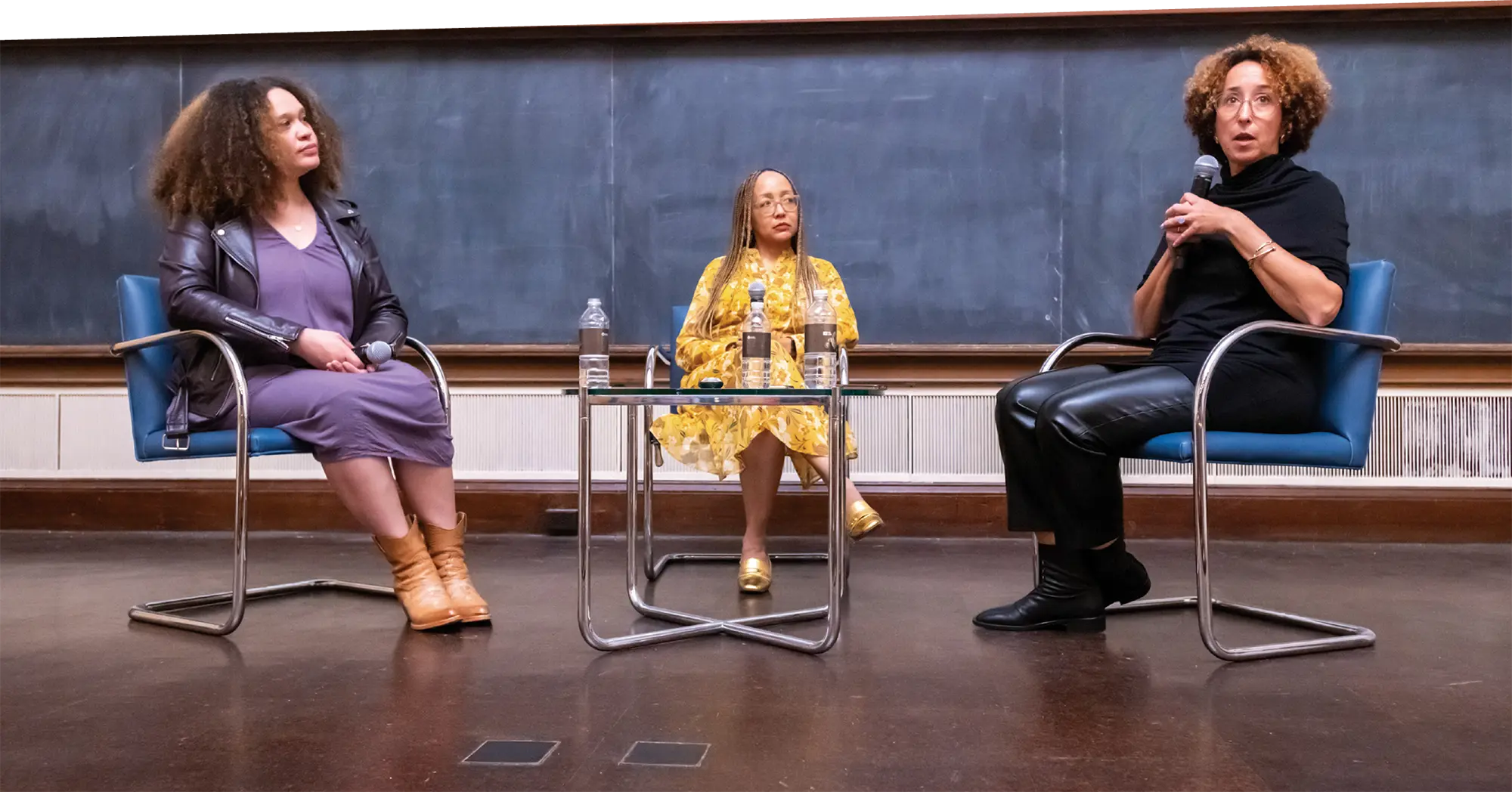
Leaving
a Trace
t has been five years since Associate Professor of Art Andrew Tallon, the charismatic teacher and historian of medieval architecture, passed away, but his pathbreaking research lives on. The 3D laser scan of Notre-Dame of Paris that Tallon produced in 2010 has already been instrumental in the reconstruction of the Gothic cathedral, damaged in a catastrophic fire that broke out on April 15, 2019.
On the unseasonably warm evening of October 25, 2023, two of the three architects responsible for rebuilding the cathedral, Philippe Villeneuve, Architect-in-Chief of Historic Monuments in charge of Notre-Dame, and fellow restoration architect Pascal Prunet, delivered a Claflin Lecture at Vassar’s Martel Theater, speaking about their efforts to shore up, conserve, and restore the cathedral since the fire. Their visit to Vassar was made possible by The Friends of Notre-Dame de Paris in honor of Andrew Tallon. The third architect, Rémi Fromont, remained in Paris, where he is overseeing the final stages of the reconstruction of the roof and spire. This phase of the project is scheduled to conclude on December 8, 2023, when the new rooster Villeneuve designed will be installed atop the spire.
“[Tallon’s] scan enabled us to reconstruct the vaults without any hesitation from a dimensional or formal standpoint, and it also granted us total freedom to understand how [the cathedral] was made, to be able to rebuild it in a thoughtful, intellectual, and intelligent way,” Villeneuve said during the recent visit to Vassar.
Tallon arrived at Vassar in 2007. Over the next three years, as part of a major grant he and Columbia art history professor Stephen Murray secured from the Mellon Foundation to develop an innovative website called Mapping Gothic France, Tallon selected two Vassar students annually to conduct summer fieldwork with him, Murray, and Murray’s doctoral students. The Vassar students Tallon selected were chosen through a competitive application process to participate in the digital humanities project and were responsible for taking 360-degree panoramic photographs of the scores of Romanesque and Gothic buildings the team visited in regions throughout France. Jessica Lentner ’09 and Kappy Mintie ’09 photographed sites in Champagne in 2008; Sofia Gans ’09 and Alexandra Thom ’09 focused on Normandy in 2009; and Ani Kodjabasheva ’12 and I [Lindsay Cook] concentrated on Burgundy in 2010.

Laser scanning Notre-Dame, photographing it for Mapping Gothic France, and viewing its stonework from the upper terraces led Tallon to worry about the building’s structural integrity. André Finot, the cathedral’s spokesperson, came to Notre-Dame from a career in the advertising industry. Not long after his arrival, Tallon invited him to climb the cathedral to warn him about the state of the building. Finot remembered Tallon telling him, “You see all these stones? This building is in danger—you need to do something. You should create a foundation, and everybody will help, because everybody loves Notre-Dame. Have a good day!”
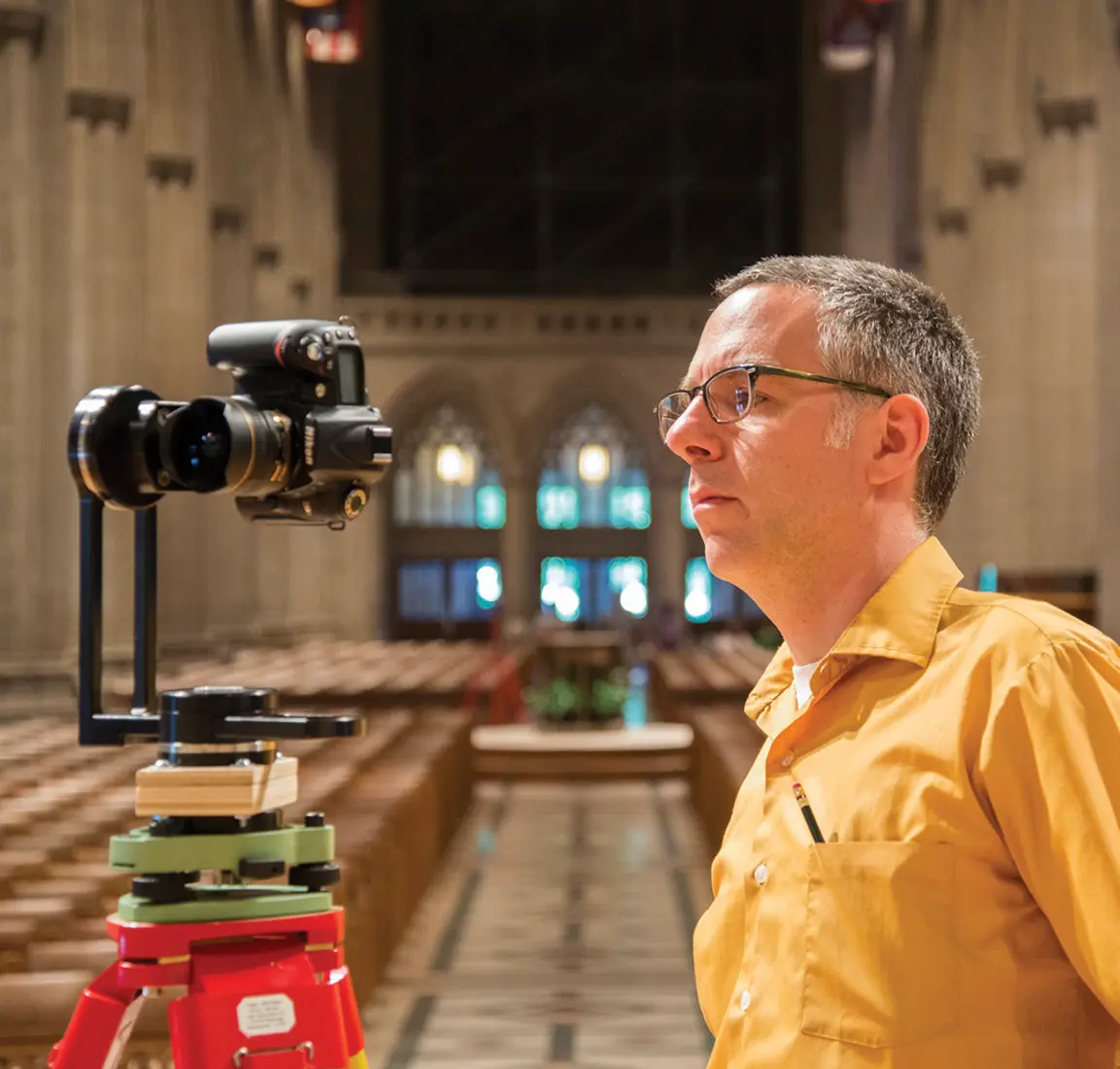
WNC 2014-Craig W. Stapert
When fire ripped through Notre-Dame’s roof on April 15, 2019, the restoration Tallon had helped set in motion was well underway. That very morning work began on one of the flying buttresses he had feared might fail. It was a lucky break that earlier that same week, sixteen of the copper statues adorning the spire were removed for conservation treatment and were not there when the fire broke out. They represent the twelve apostles and the four evangelists, integral to the spire restoration architect Eugène Viollet-le-Duc designed in the late 1850s. The carpentry supporting these figures was inspired, in part, by the base of the medieval spire, which still lingered under the roof in the mid-19th century, as University of Wisconsin-Whitewater Art History Professor Lynn T. Courtenay ’65 demonstrated in a noteworthy 1989 journal article.
The fire melted the lead roof tiles, destroyed the timber framework of both the 19th-century spire and the 13th-century nave and choir roofs, and weakened the stones its flames licked—but it could not claim the apostle and evangelist statues. They have since been restored, and, at the time of writing, they are all on view at the Cité de l’architecture et du patrimoine, the cultural heritage museum in Paris. Among these towering copper figures is St. Andrew, dedicated both to Cardinal André Vingt-Trois and to the memory of Andrew Tallon. When he visits the museum and sees the restored statue with Tallon’s name written on the plaque, Finot said, he feels “thankful for what [Tallon] did for Notre-Dame.”
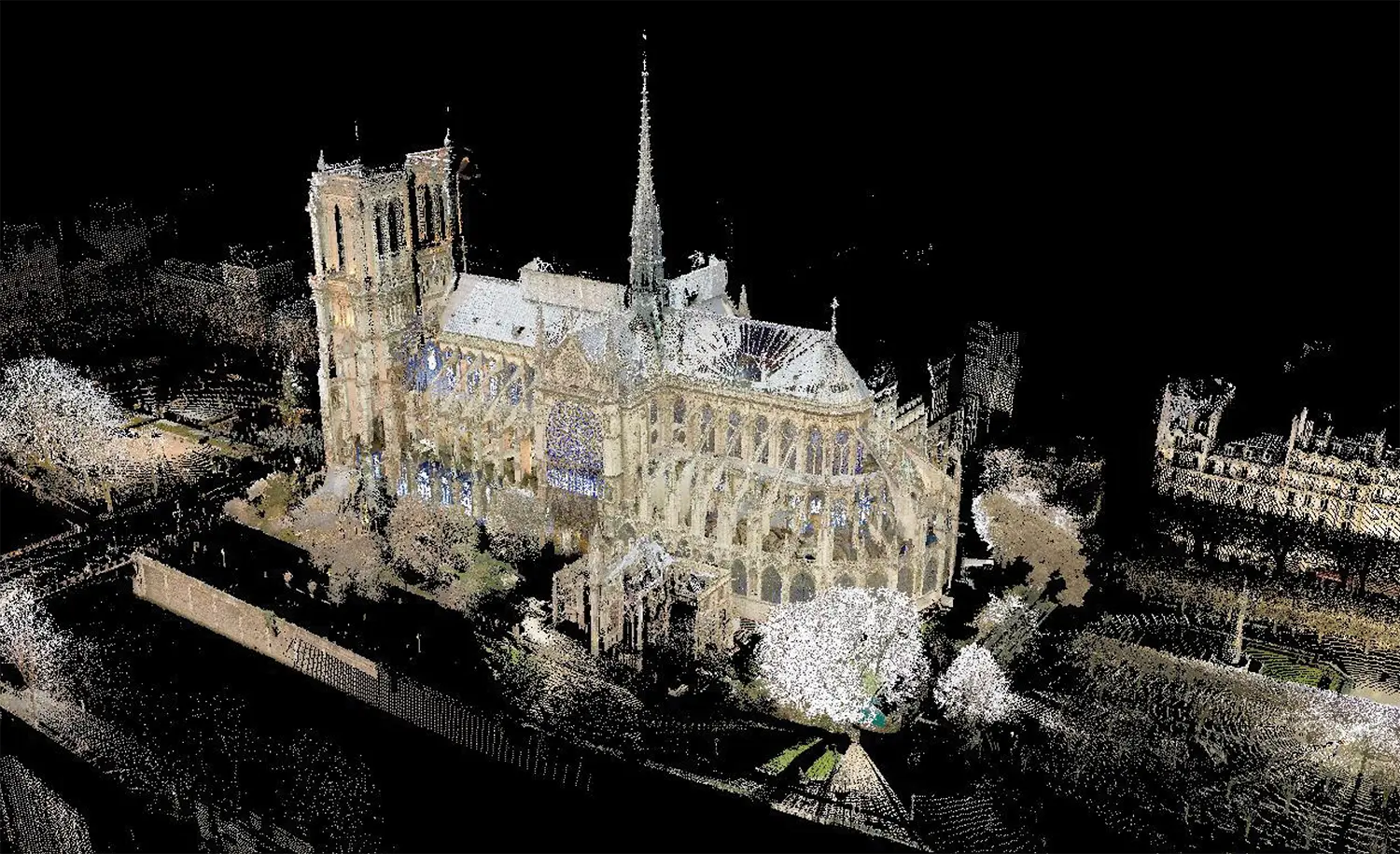
Courtesy of Marie Tallon
Tallon had sent a copy of his point cloud (collection of data points plotted in 3D space) to Villeneuve’s predecessor, Benjamin Mouton, before the latter retired in 2013, and after the 2019 fire, Marie Tallon saw to it that Villeneuve, Prunet, and Fromont had access to her late husband’s work. During their lecture and in a follow-up interview conducted the next day, Villeneuve and Prunet said that Tallon’s scan—which Prunet called an “exact trace” of the state of the building at the time it was scanned—has been used in numerous ways since the fire. For example, it aided design of the wooden centering custom-made to cradle each unique flying buttress and rib vault and to rebuild the damaged vaults and the sole transverse arch destroyed when the tip of the spire separated from its base and fell westward, becoming a projectile that crashed into the nave.
“Andrew Tallon’s point cloud, well, it’s a bit like listening to a Mahler symphony,” said Prunet, alluding to the scan’s sublime scale and complexity. Extending the musical metaphor, Prunet continued, “It’s a recording,” but one that “needs to be decrypted.”


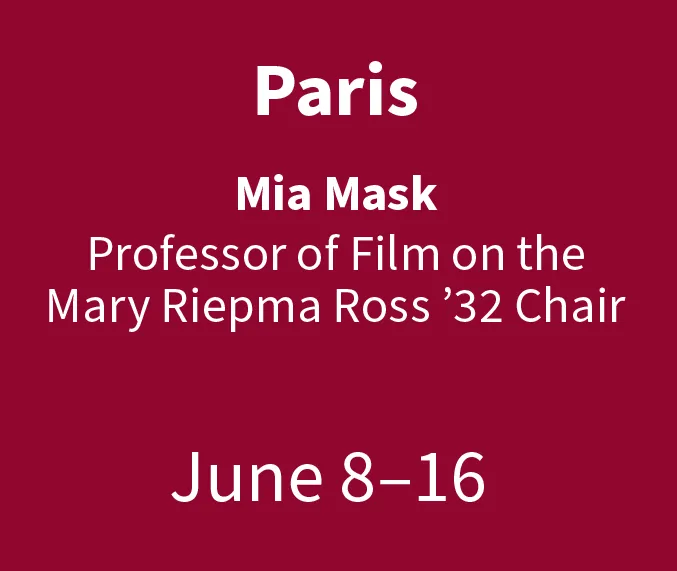



Richard L. Cretella Tennis Center Opens with Dedication Remarks, Open Play
“I can confidently say that Vassar now has one of the very best outdoor tennis facilities among our peer schools in the northeast,” Michelle Walsh, Director of Athletics and Physical Education at Vassar, said. “That makes such a big difference because it helps us to recruit outstanding scholar-athletes to the campus—students who excel in the classroom, on the court, and who contribute in so many different ways to our campus community.”
The Richard L. Cretella Tennis Center, built on the former Ballentine Field, has eight tennis courts made with “post-tension” concrete underneath that is made to last at least 20 years, new spectator seating, and storage for team equipment. A new scoreboard will also be installed soon. The courts are conveniently located directly adjacent to Walker Field House, providing the teams with access to locker rooms, indoor courts, and sports-medicine facilities.
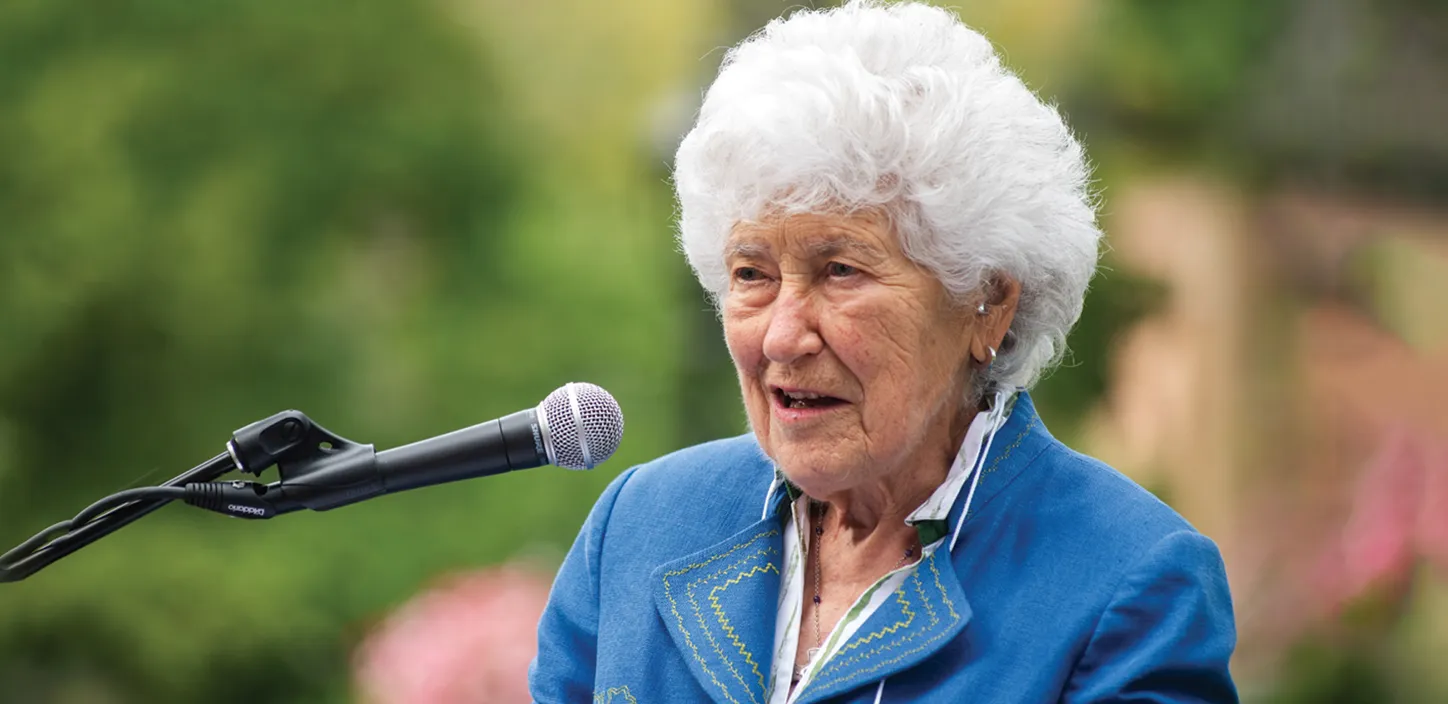
“On behalf of both the men’s and the women’s tennis teams, we are so incredibly grateful for this amazing state-of-the-art tennis facility,” Tina McDermott, head men’s tennis coach, said. “We’re just so very proud to practice and compete here. We want to thank the donors again for their support and generosity.”
Mars, encouraged by her daughters, created annuity trusts in both of her brothers’ names. When her older brother, Albert W. Cretella Jr., passed, a scholarship was created in his name. After Richard Cretella’s passing in October 2022, Mars and her daughters had a need for the trust to fund something for the College and the College had a need for new tennis courts. This was perfect, as Cretella was an avid tennis player, passing his knowledge and love for the game on to his children and his sister.
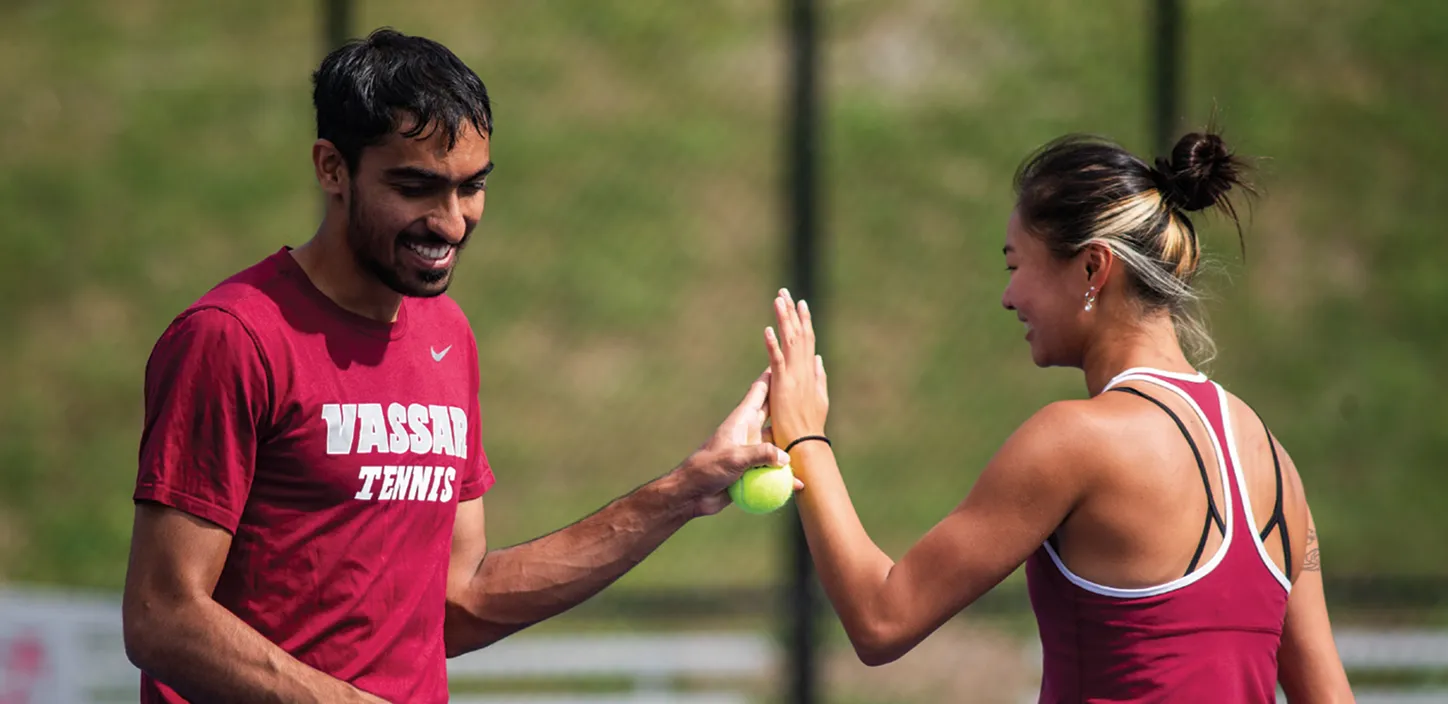
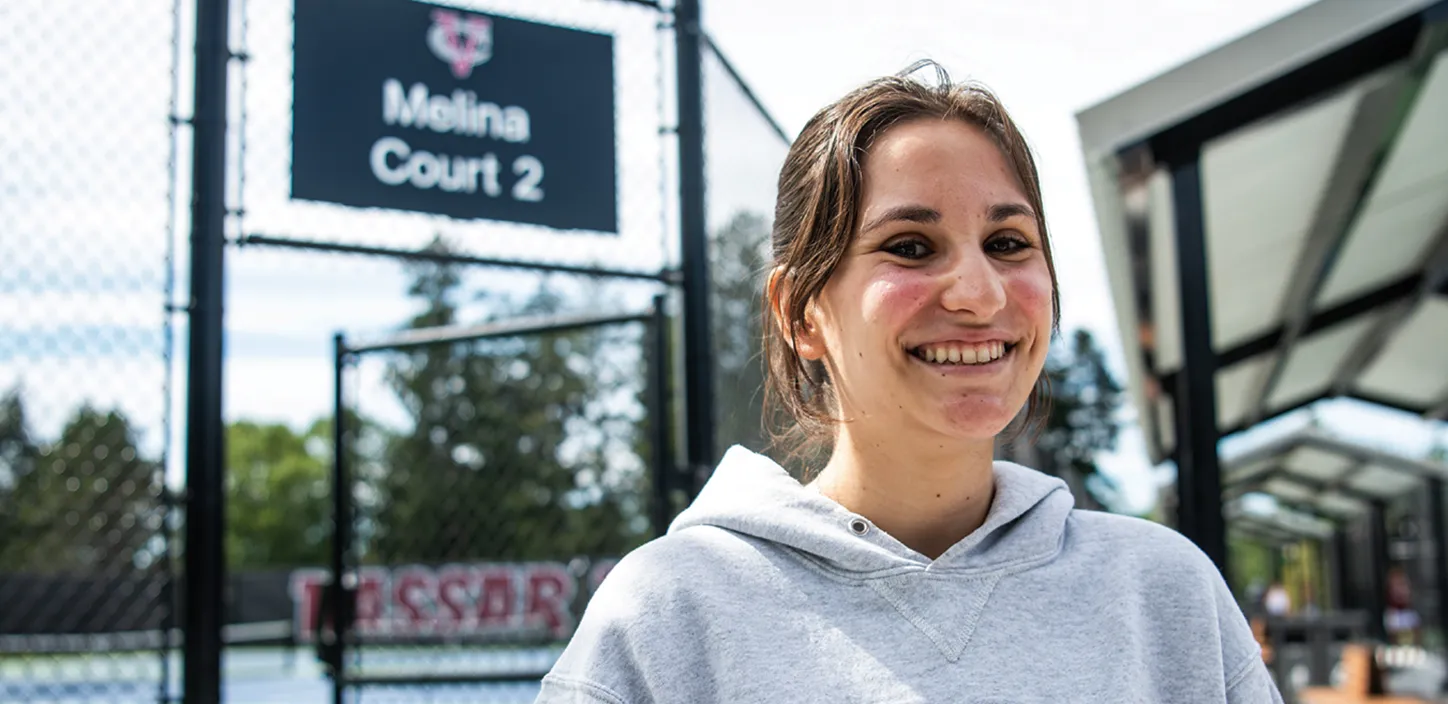
Upon seeing the courts for the first time, Mars said, “It’s wonderful, beautiful, impressive. How many settings do you get like this for tennis?”
The teams and coaches are celebrating the new courts, too.
“It’s the best facility by far I’ve ever had the opportunity to work on in my 26 years,” women’s head coach Marty Perry said. “From day one, the team is playing better. It’s a huge help to the success of the programs and for recruiting.”
“The first day we practiced on the courts, our coach [Perry] was saying we were a different team,” Macey Dowd ’25, a member of the women’s team, said. “They’re a good source for recruiting.”
“It’s a big step up from the old courts,” men’s team member Jay Wong ’24 added. “We’ve had a breakthrough and this gives us bigger potential to recruit and to host tournaments.”
Members of both teams said the new courts will provide a much better spectator experience and give the coaches better access to the players during practice.
“It’s my last year and I’m going to enjoy every moment of it,” Benjamin Almquist ’24, a member of the men’s tennis team, said. “It’s beautiful. It really enhances the practice and match experience.”
As the Walker Field House shows its age, the new tennis courts, according to President Bradley, are “our first, and most recent step, toward strengthening the vision for Vassar Athletics broadly.
“Having those courts really starts us on our way to the larger replacement that we need,” Bradley continued. “So, so much more to look forward to in the program.”
Vassar Celebrates 100 Years of Alumnae House
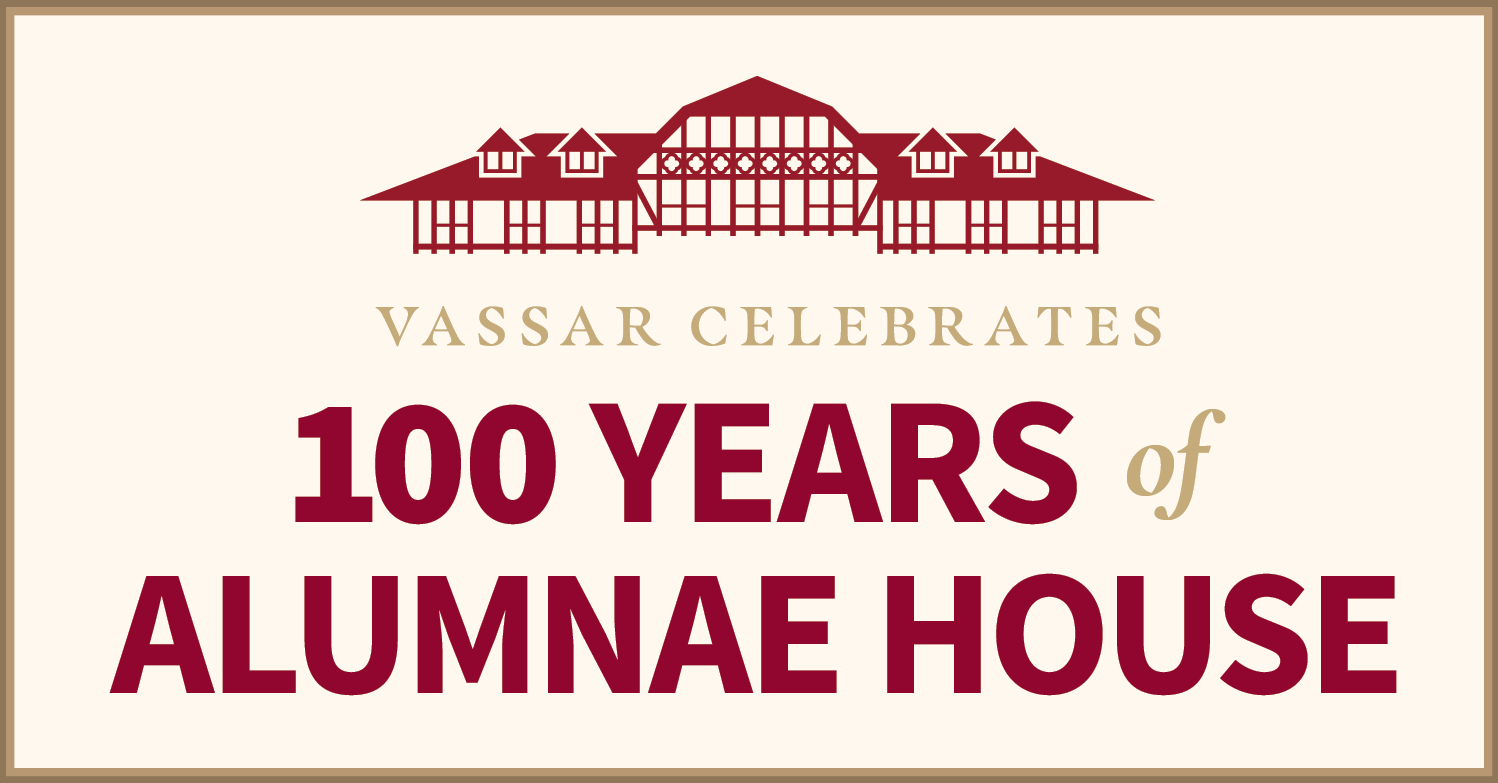
his coming year marks 100 years since the opening of Alumnae House, when Blanche Ferry Hooker, class of 1894, and Queene Ferry Coonley, class of 1896, made a historic $300,000 gift to the College, establishing a home for AAVC and a place to celebrate “the work of the mind” that is the “principal bond in alumnal relations.” In the century since, Alumnae House has become a hub for maintaining our bond as alums, and it remains a forever home for every alum looking to revisit their Vassar days, celebrate life milestones, and give back to the intellectual life of the college and alum community through their participation. We welcome you back and ask you to reflect on what AH@100 means to you as you peruse this special issue of VQ.
To mark 100 years since its opening, we’re planning several special events. The campus and alum community will come together to re-dedicate Alumnae House and inaugurate its second century on April 4, 2024. Alums also will celebrate the Centennial during Reunion 2024. We’ll look back on its history—as a guest house, an intellectual venue, a wedding venue, a pub, a quarantine zone, and as the home of the AAVC. Most importantly, we’ll come together to discuss and imagine the future we want to create in the spaces where we gather and dwell, as an ever-changing and widely expansive, smart, critical, creative, and compassionate body of alums.
With this in mind, I also want to take a moment to pause and reflect on the meaning of this historic anniversary. Looking back to 1924 means thinking about the era of women’s suffrage, the exclusionary 1924 Immigration Act, the post-influenza-pandemic decade, a time when gender, civil rights, and what it means to be American were being reshaped. It was at once an era of progress and regression. A 100-year milestone should always be a reminder that there remains work to be done in the world and that we need one another more than ever.
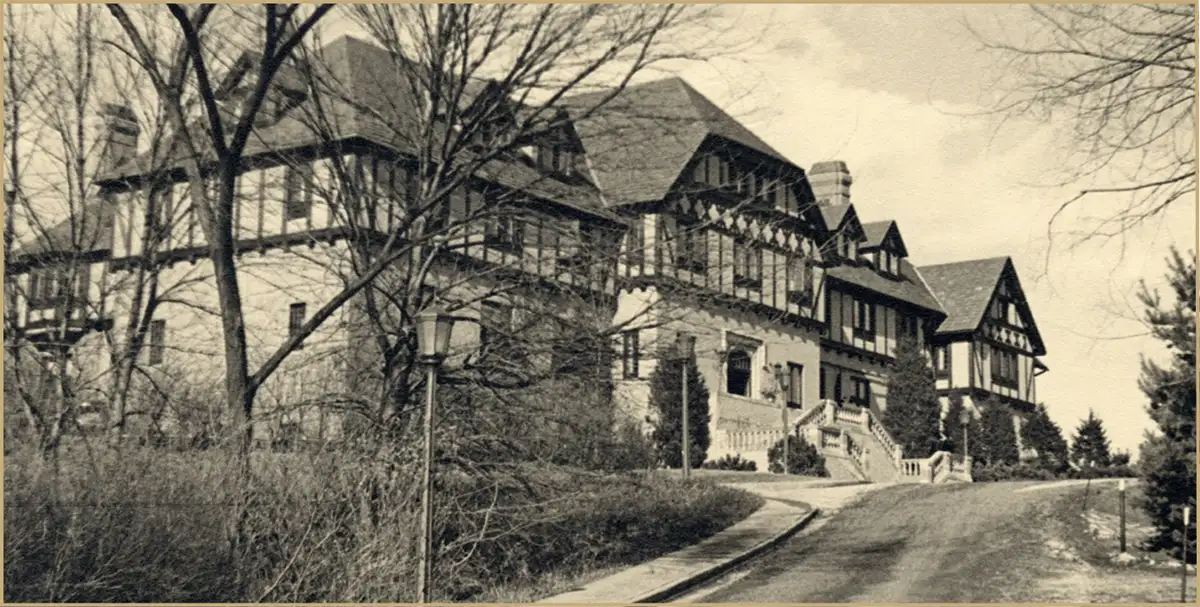
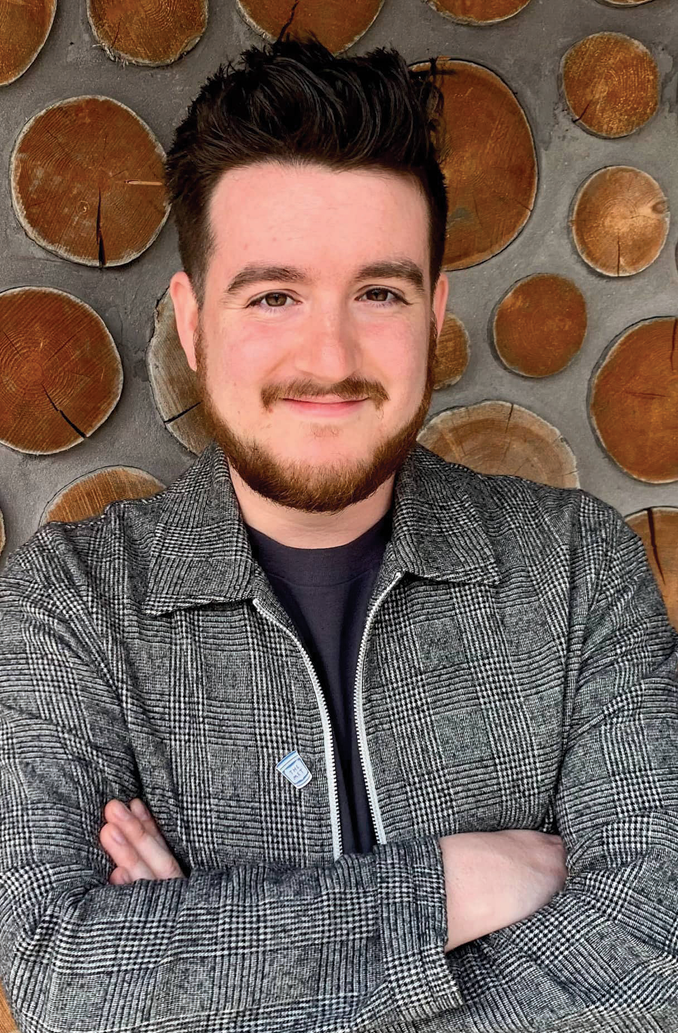
I also see this tradition of giving back to one another come to life every year during Sophomore Career Connections, when the rooms of Alumnae House are filled with alums who come back to talk to students about what they’ve done in the worlds of the arts, the sciences, law, social change, education, business, and other sectors.
By next summer, Alumnae House will have new neighbors, the Vassar Institute for Liberal Arts and the Heartwood Inn, along with a gorgeous winding landscape that welcomes Vassar, Poughkeepsie, and the world to our beloved Tudor Castle on the hill. I wonder what first-year students might think of Alumnae House when they visit for their first taste of a Vassar Devil on some sweltering August orientation afternoon in 2061.
Laying the Groundwork
Vassar Archives and Special Collections
In 1914, sisters Blanche Ferry Hooker, class of 1894, and Queene Ferry Coonley, class of 1896, dedicated supporters of the College, met with then-Vassar President James Monroe Taylor to discuss a place where alums could come together, pledging $300,000 in funding to bring their vision to fruition.
The original plan for the house, according to the August 1924 issue of the Quarterly, was to satisfy the demand for continuing education at Vassar. “It has always been the hope of the donors of the House and of the directors of the Associate Alumnae that Alumnae House would be more than merely a club where returning alumnae might be sheltered,” wrote Harriet Sawyer. “The beauty of detail throughout the House has been designed with an educational purpose, and the idea underlying all the life in the house is educational. It is the hope of all concerned that Alumnae House may be the scene of stimulating conferences and inspiring courses of study, where alumnae from all parts of the country may meet, confer, and discuss.”
The idea of constructing a building would get closer to reality in 1915, when Henry Noble MacCracken became Vassar’s new president, but goals for the project would change to developing faculty housing with a wing for alums. The hope was that the building would be completed in time for the Associate Alumnae’s 50th anniversary in June 1921, but plans had to be put on hold because of World War I and its aftermath. Due to wartime shortages and the post-war economy, plans for the building would continue to change. In the end, the decision was made to build two separate buildings, one for alums and a second for women faculty members (Williams House), thus significantly increasing the price of the project.

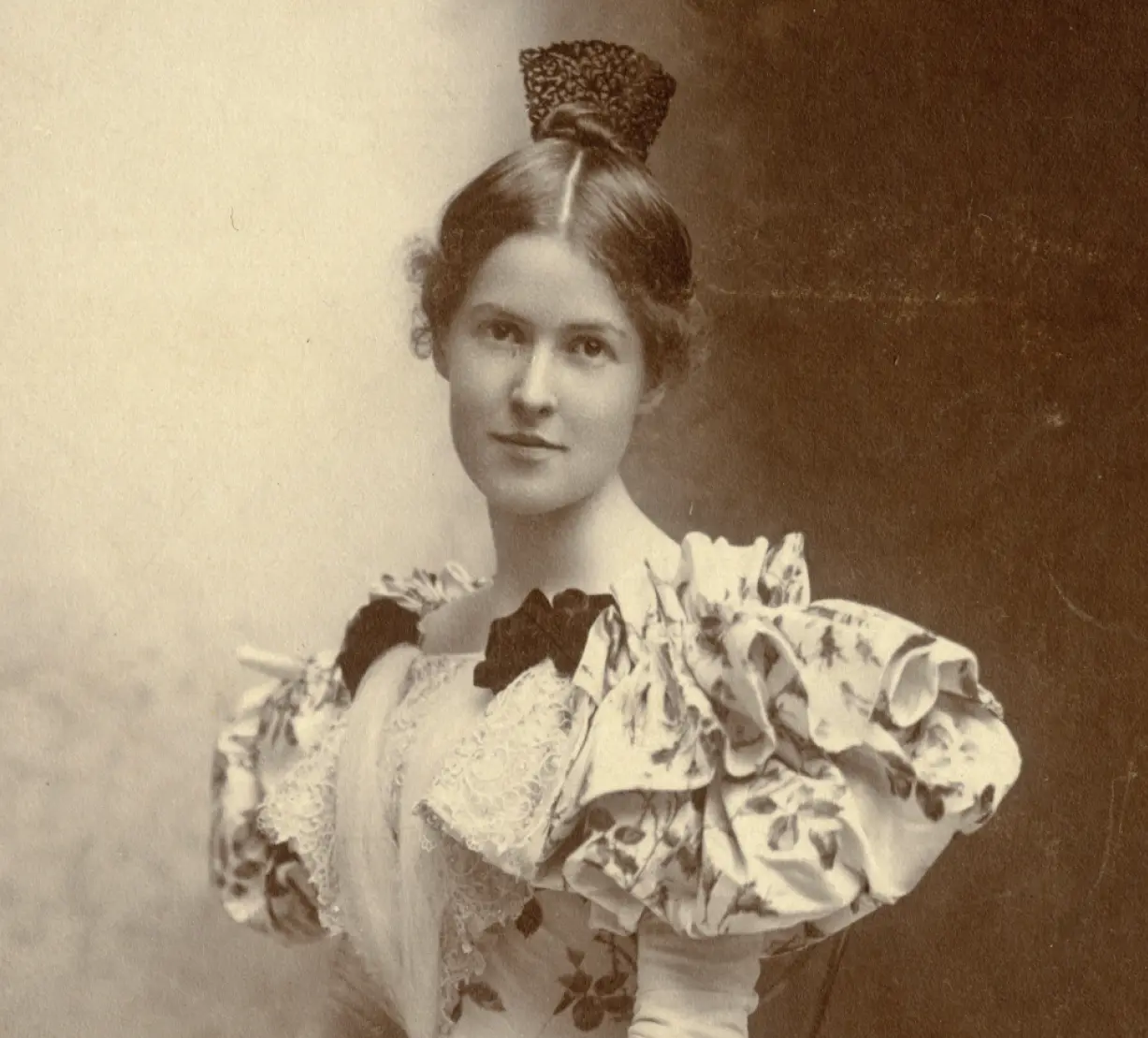
Vassar Archives and Special Collections
According to The Campus Guide: Vassar College by architecture professors Karen Van Lengen ’73 and Lisa Reilly ’78, the donors had chosen architects Richard and Joseph Howland Hunt to design and construct the house in a half-timbered Tudor style typical of Vassar buildings from this period. The design for the original landscape was by the Olmstead brothers—sons of Frederick Law Olmsted, who co-designed Central Park. “Their careful shaping of the rocky hill in front of the house gave the building a sense of place overlooking the college grounds while also buffering it from the noise of Raymond Avenue,” the guide declared.
On the rainy afternoon of June 8, 1924, nine years after the idea’s inception, Alumnae House would be officially dedicated and blessed. [Read more about the medieval-style ceremony.]
The House started to come to life. Faculty members, including Margaret Washburn, Laura Wylie, and Lucy Maynard Salmon, held a series of conferences attended by alums, students, and other educators throughout 1924. In its first year, Alumnae House hosted 2,250 guests, according to The Book of Alumnae House. They included alums and friends, young men who were visiting students, parents, and visitors from other countries, including New Zealand, Sweden, and England.
Today, the house continues to hold the promise of comfort and intellectual engagement. Along with Vassar’s new Institute for the Liberal Arts, being erected just down the hill, the House will form what is being called “West Campus.”
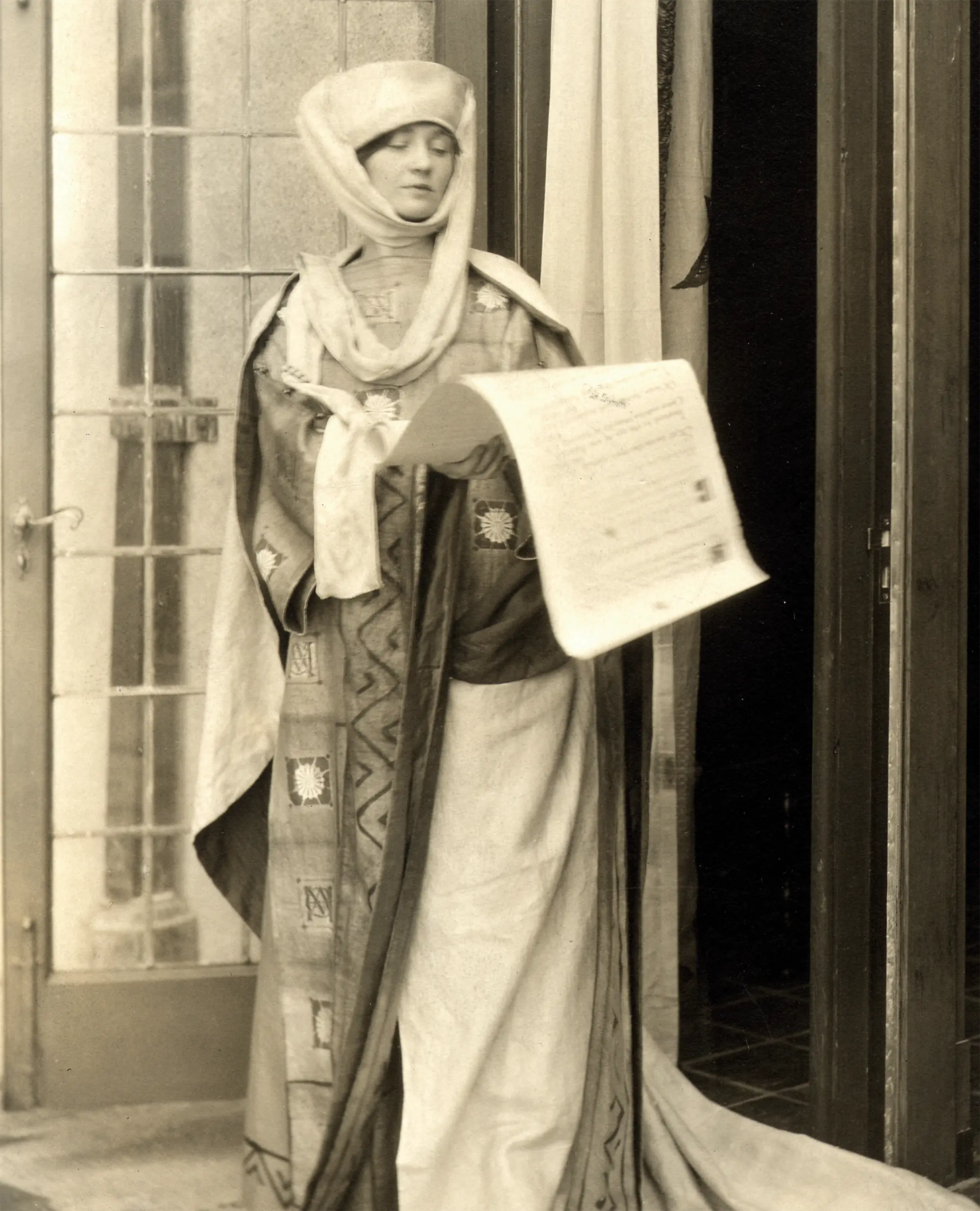
A Medieval
Dedication
Like many details of the Alumnae House interior, the dedication ceremony was conceived by Violet Oakley—the artist who created the centerpiece of the living room, The Great Wonder triptych. As with the triptych itself, Oakley worked with Louise Meigs, class of 1891, who headed the Alumnae House Opening Committee and who had commissioned The Great Wonder to honor her deceased Vassar roommate, Hester Oakley Ward, class of 1891, Violet Oakley’s sister.
The ceremony began in the living room with the singing of a Shakespearean house blessing:
friends, on every sacred room,
That it may stand till the perpetual doom,
In state as wholesome as in state ’tis fit.
Worthy the owners and the owners it.
As Violet Oakley described it in a letter she wrote shortly after the occasion, “Little Hester … reached up and unlocked the great, gold Doors—unfolding them reverently, and stepping down and back with her arms still unconsciously outstretched—coming to Earth, as it were, as a bird quietly descends.”
The audience gasped.
The ceremony concluded with a dedication song written by Elizabeth Coonley and Adelaide Hooker:
That never burned before.
And halls are thronged to-day that shall
Be silent nevermore.
Then come, good people, gather ye,
And dedicate this house to be,
For shelter and for unity,
From now for ever more.
 House of
House of A Thousand Treasures
A Thousand Treasures
 House of
House of
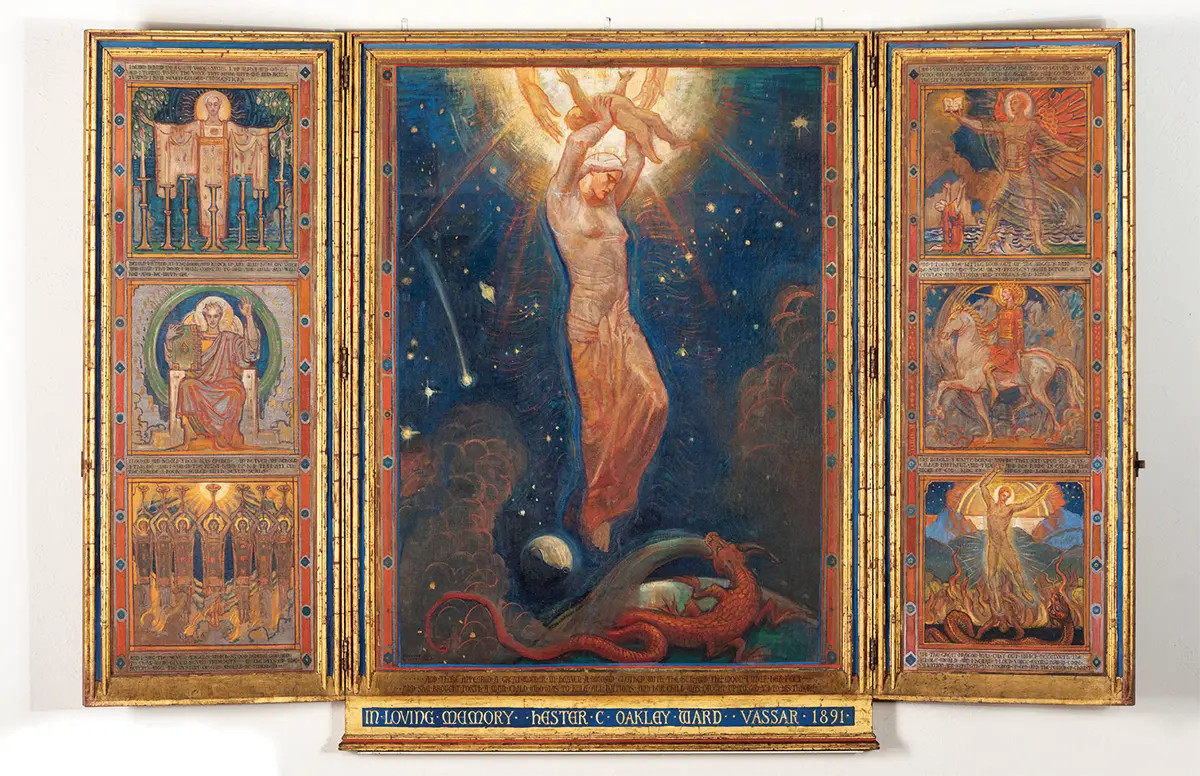
house is not a home until it is furnished. Well aware of this, the two sisters who provided the funds to begin construction on Alumnae House put out the call to fellow alumnae for help outfitting the new building. And help they did: Gifts large and small began pouring in, ranging from grand items to small necessities. This began a tradition of gifting items and funds to the House that continues to this day. In fact, the vast majority of furnishings and artwork that have graced Alumnae House over time have been donated or purchased by alums, not the College.
Alums donated trees and other plant materials for the grounds. They sent books they had written for the Alumnae House Library. Queen Ferry Coonley, one of the original benefactors, provided curtains and weaving for eight bedrooms.
Two silver vases and a dress belonging to Princess Ōyama (Sutematsu Yamakawa), class of 1892, were displayed in a room dedicated in her memory by the class. A watercolor of Matthew Vassar’s brewery, originally displayed in the pub, is a gift of Martha H. MacLeish, class of 1878; it was painted by her daughter, Ishbel, class of 1920. As part of the house’s 75th anniversary celebration in 1999, Martha Lingua-Wheless ’78 coordinated an Anniversary Quilt with over a dozen alums, which is still displayed on the second floor. And the list goes on!
The most iconic gift to the House, of course, is The Great Wonder: A Vision of the Apocalypse by Violet Oakley, a triptych painted by an artist personally connected to Vassar that was unveiled amidst great fanfare at the house’s formal dedication on June 8, 1924.
The Great Wonder and Great Influence of Violet Oakley
In a pamphlet handed out at the dedication ceremony, Oakley explained the message of empowerment she wanted women to take from the artwork’s central image:
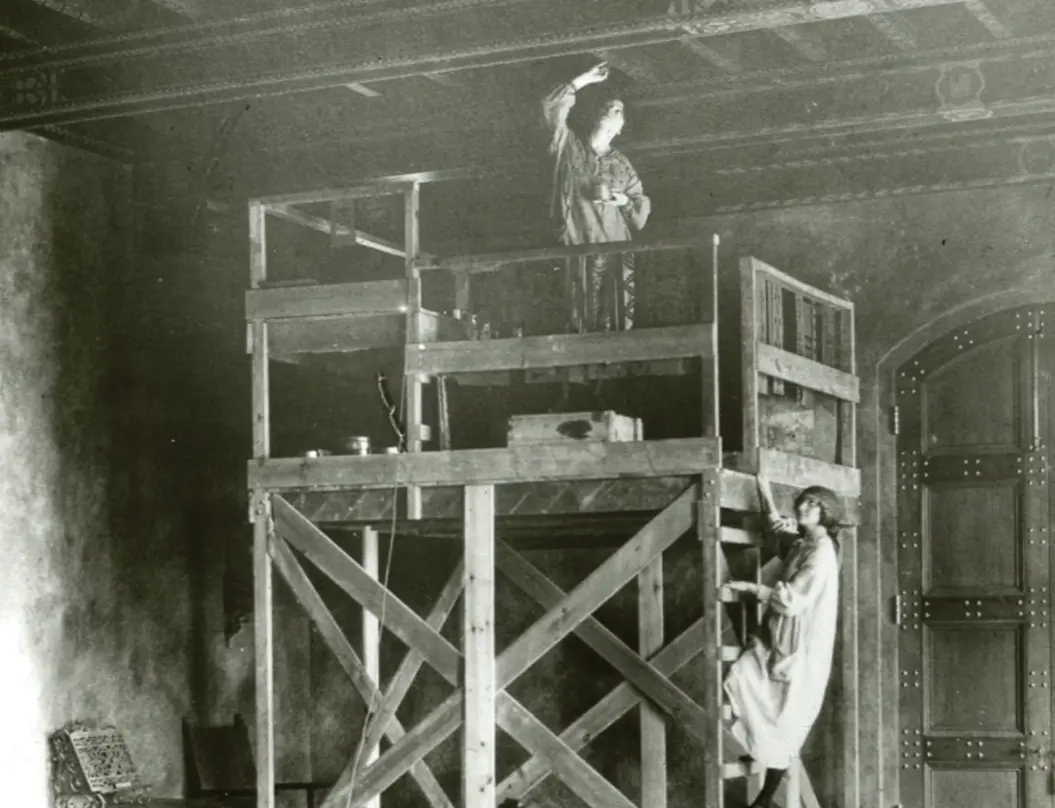
Oakley’s original furnishings can still be found throughout the house. However, much of it has been moved to other rooms, as successive house decorators prioritized creature comfort over artistic statement.
Pub Murals by Anne Cleveland
As they were being painted, Liz DeLong ’47 offered a perfect tongue-in-cheek description in the June 5, 1946, issue of the
Miscellany:
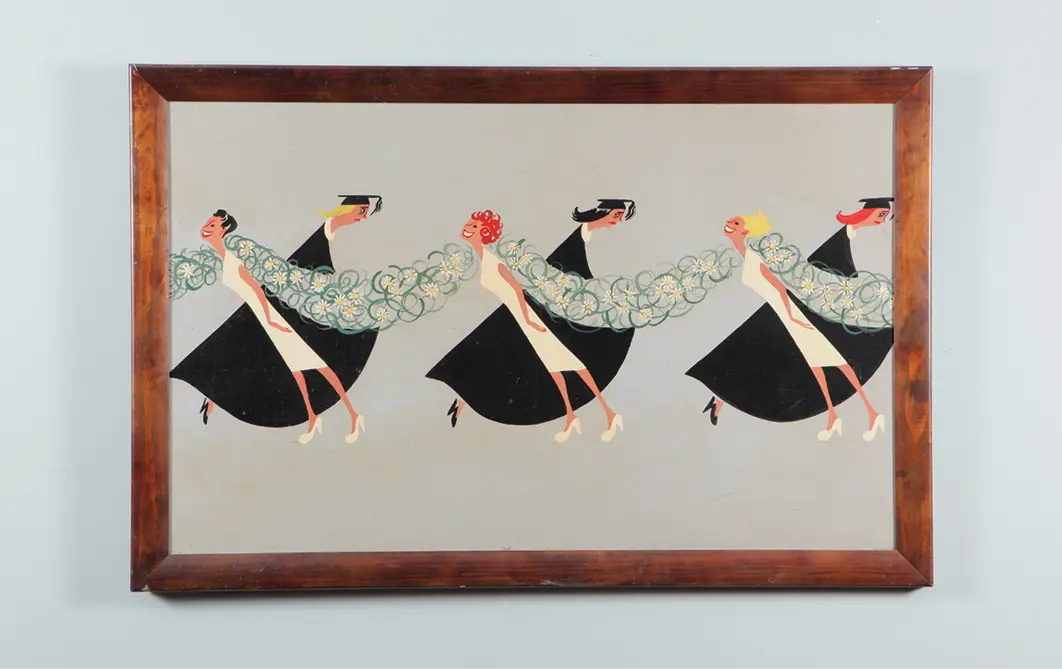
Restoration and Modernization
These gifts all help to maintain the feeling so many have when visiting: that Alumnae House truly is a home away from home.
A House Full of Life!
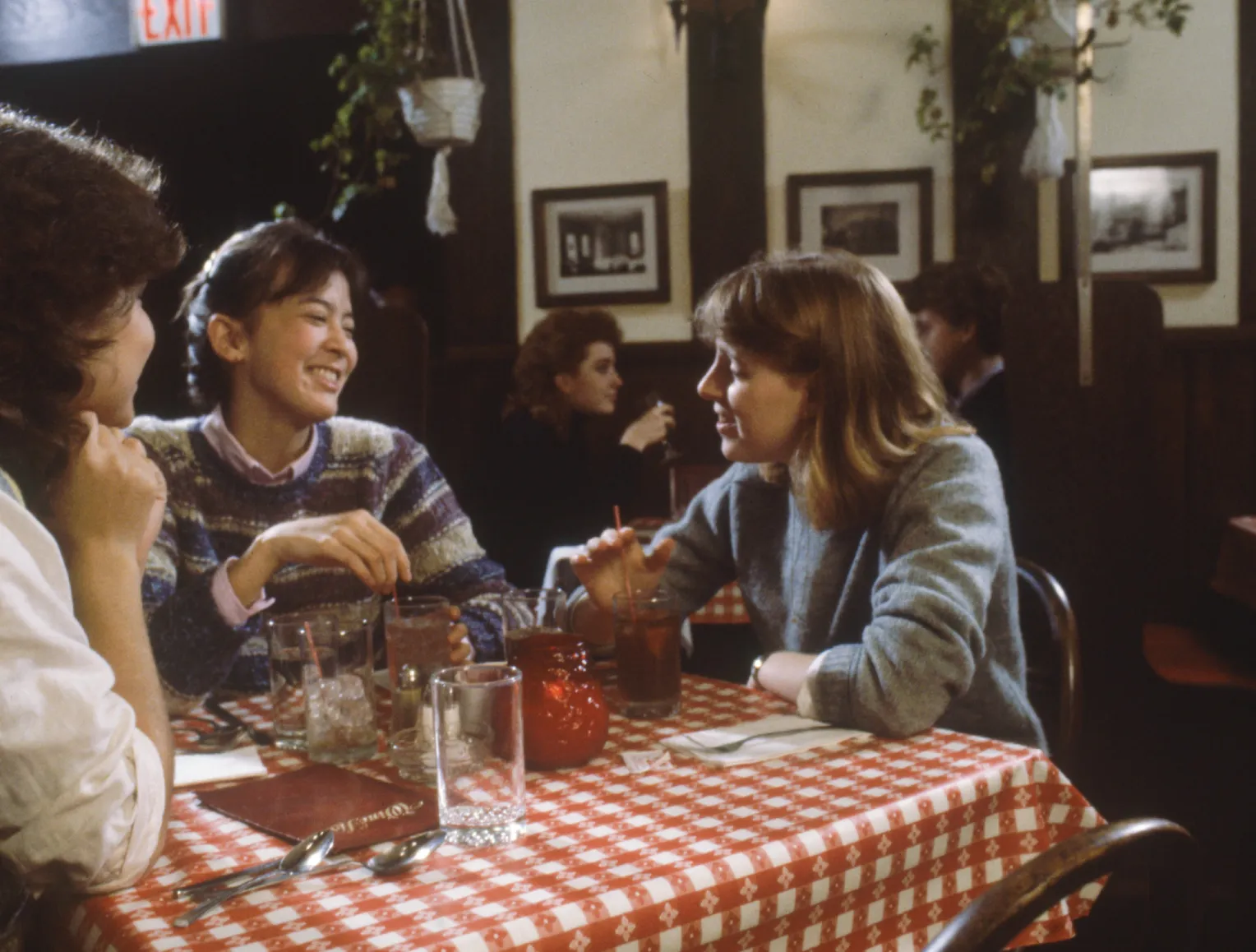


John Abbott / Evan Abramson ’00
The Pub
In the March 1950 issue of the Vassar Quarterly, Eloise Sydenstricker Morton ’50, who worked as a cashier in the establishment while a student, reflected that, at its inception, “Nobody dreamed how much it would supplement and at times replace the formal dining room service. Nobody suspected that 300 starving souls might appear for a Sunday breakfast, or that 100 faculty and townspeople would be served luncheon every day, indoors and out, or that 10 dozen hamburgers could be ordered and grilled in a single evening. Nobody realized how students would take the Pub to their hearts and call it their own.”
Although the establishment had to cease operations as a full-service restaurant in 2009, it remains a gathering place for members of the Vassar community, hosting catered meetings, holiday celebrations, and other happenings, such as monthly Faculty Pub Nights—a chance for educators to relax and compare notes while enjoying drinks and nibbles. The Pub was even used as a location for taping the series From the Pub, which featured alums conversing on a variety of timely topics.
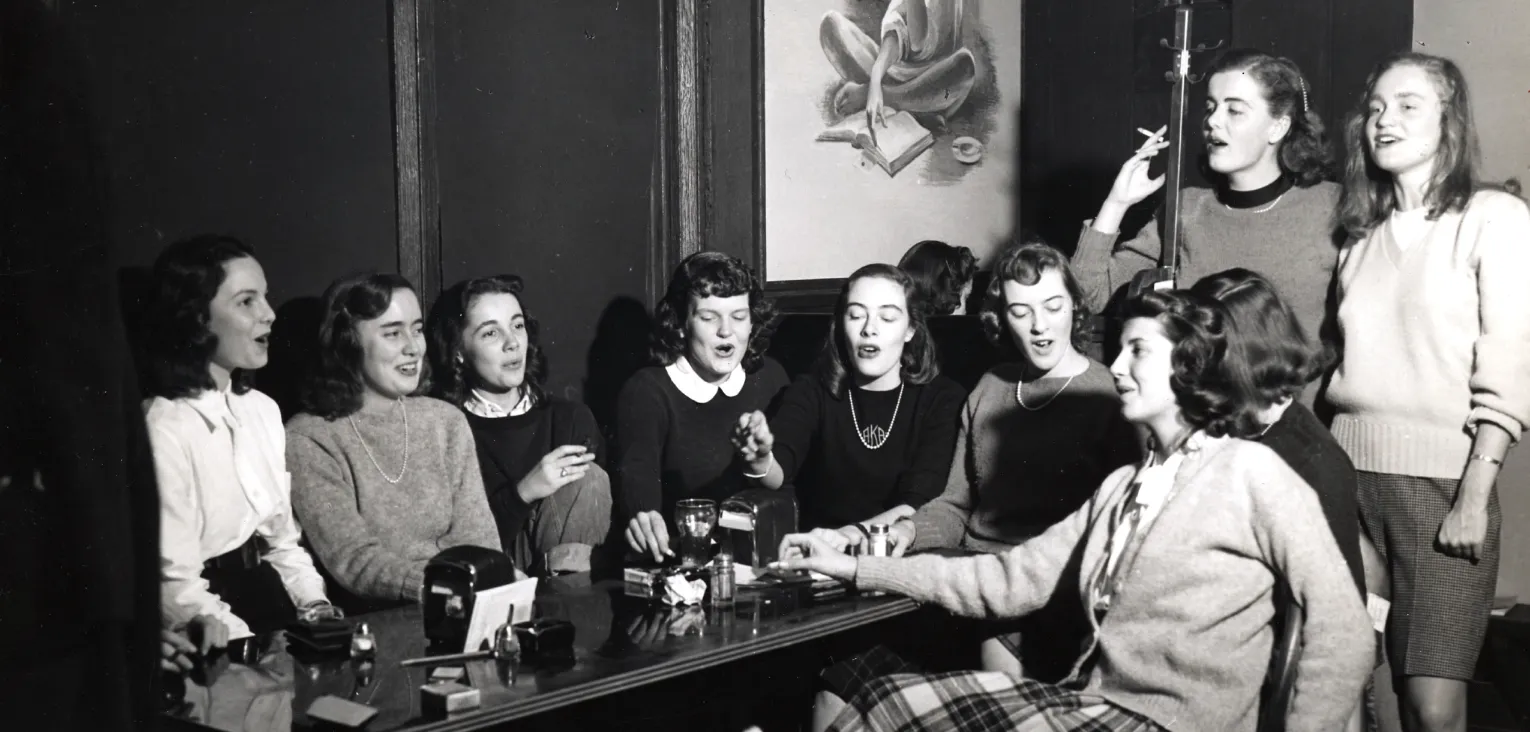
Nuptials
Matt Soper and Samantha Trautman Soper, both ’91, first met as regular patrons of Matthew’s Mug, and became closer in their senior year, when Samantha served as the statistician for the soccer team (Matt was Co-Captain). But it wouldn’t be until Reunion, five years later, that they would recognize their romantic potential. Vassar was so much a part of their story that getting married on campus seemed a no-brainer. They were married in the Chapel 25 years ago and chose to hold the reception and dinner at Alumnae House—a place Matt describes as warm, familiar, and timeless. About 30 alums joined them to celebrate their union—many of their guests stayed overnight at the inn.
The House provided a place of solace for Keith St. John ’81 and his husband Bill Garber when they married 15 years ago, three years before same-sex marriage would be legalized in New York. There were a lot of challenges to overcome. The Episcopal Diocese of Albany, where they live, didn’t allow same-sex marriages on its property or allow its clergy to perform the service. They traveled across the border to Massachusetts, where same-sex marriage was legal and recognized by New York to get married legally, then drove to Poughkeepsie the next day to the “much-adored” Alumnae House, located outside of the Albany jurisdiction. St. John says it was the perfect setting for the wedding he wanted. “Aside from being steeped in history and a part of the College and campus I had grown to love during my years at Vassar,” he says, “I was attracted to the warmth, beauty, and charm of Alumnae House—it was emblematic of the style and sophistication I had hoped would characterize the entire event.”
Comforting Accommodations in Times of Need
In October 1943, during World War II, Vassar President MacCracken sought permission to house 35 freshmen in Alumnae House, due to an underestimation of the incoming class size. The alumnae association obliged. The House re-opened to regular house guests again in 1945.
Throughout the first phase of the COVID pandemic, Alumnae House served as a place where students who had tested positive were able to isolate until they could return to campus. Aside from having a cushy place to land, students were fed meals and also treated to care packages arranged by local alums and House Manager Martha Barry.
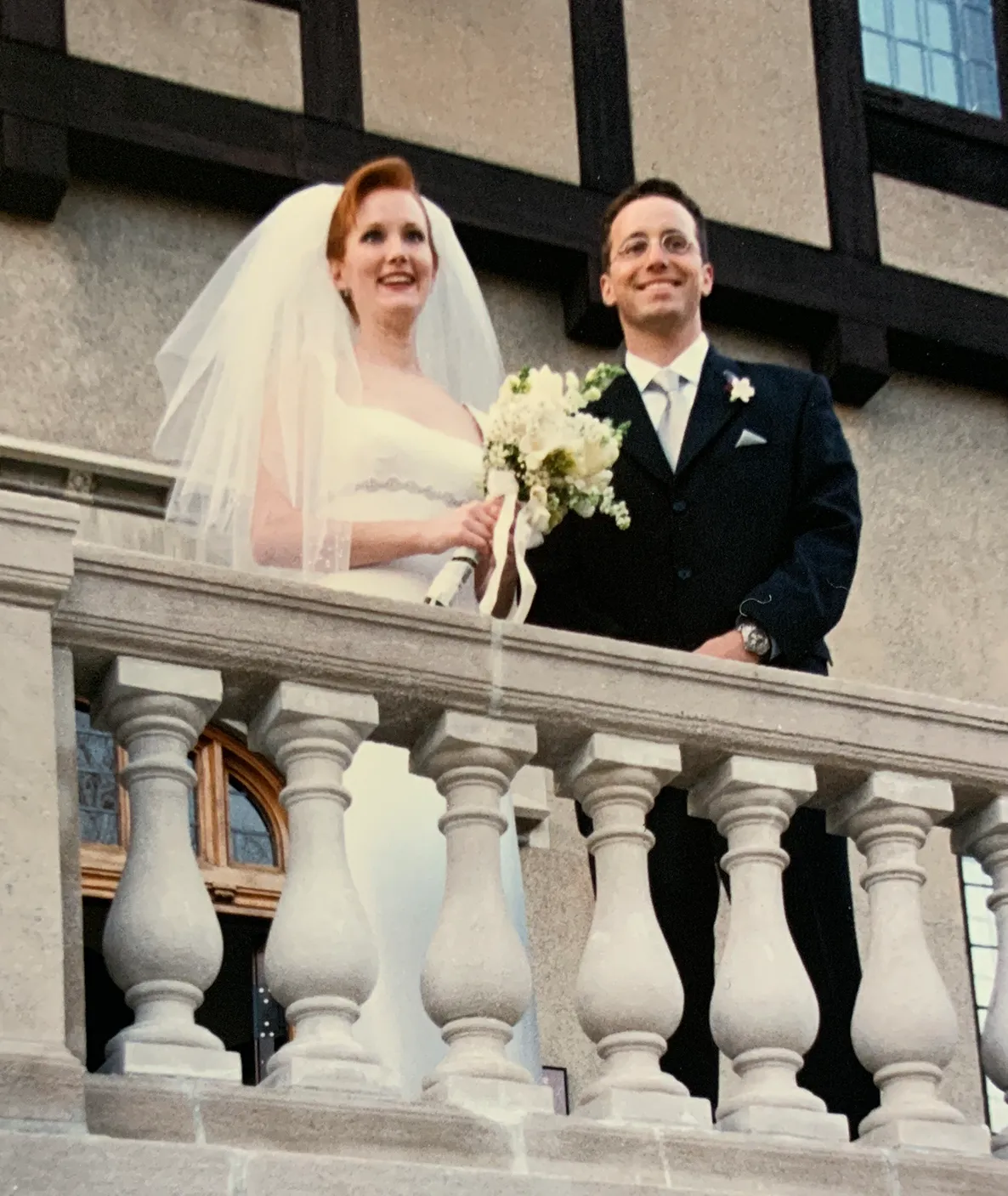
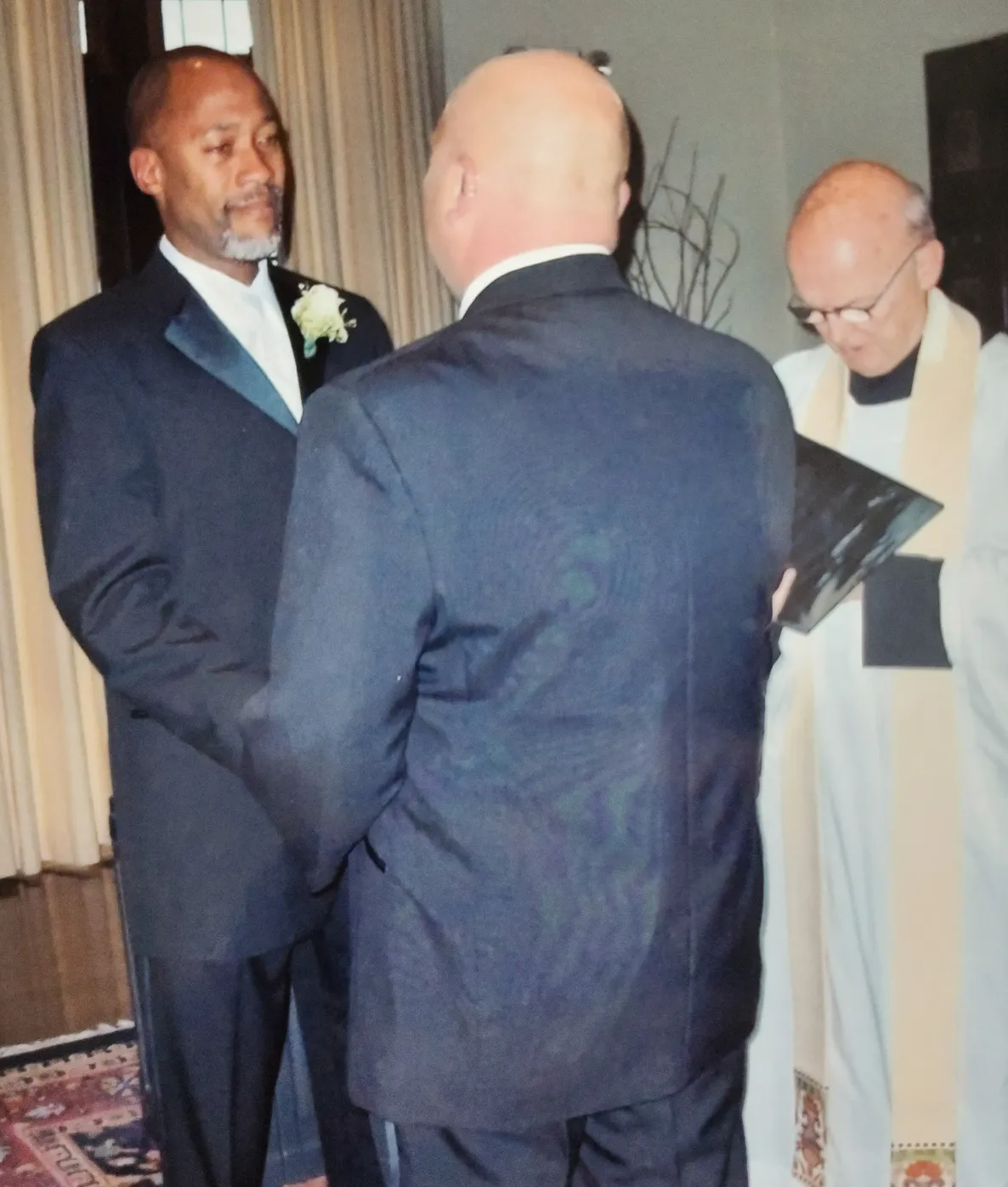
Courtesy of the subjetcs
All Things AAVC
Alumnae House has been a home base for AAVC Board functions, too. Each year the AAVC honors outstanding alums, faculty members, and staff who exemplify ideals of service, excellence in their fields, and that certain je ne sais quoi we call the “Vassar spirit.” The Alumnae House Dining Room has often been where the honorees are feted.
The House also provides a comfortable and inviting space for AAVC Board meetings. Brian Farkas ’10, a current Vice President of the AAVC Board, notes the extra special importance the House takes on not only when tackling board business, but also in the “off times” after meetings:
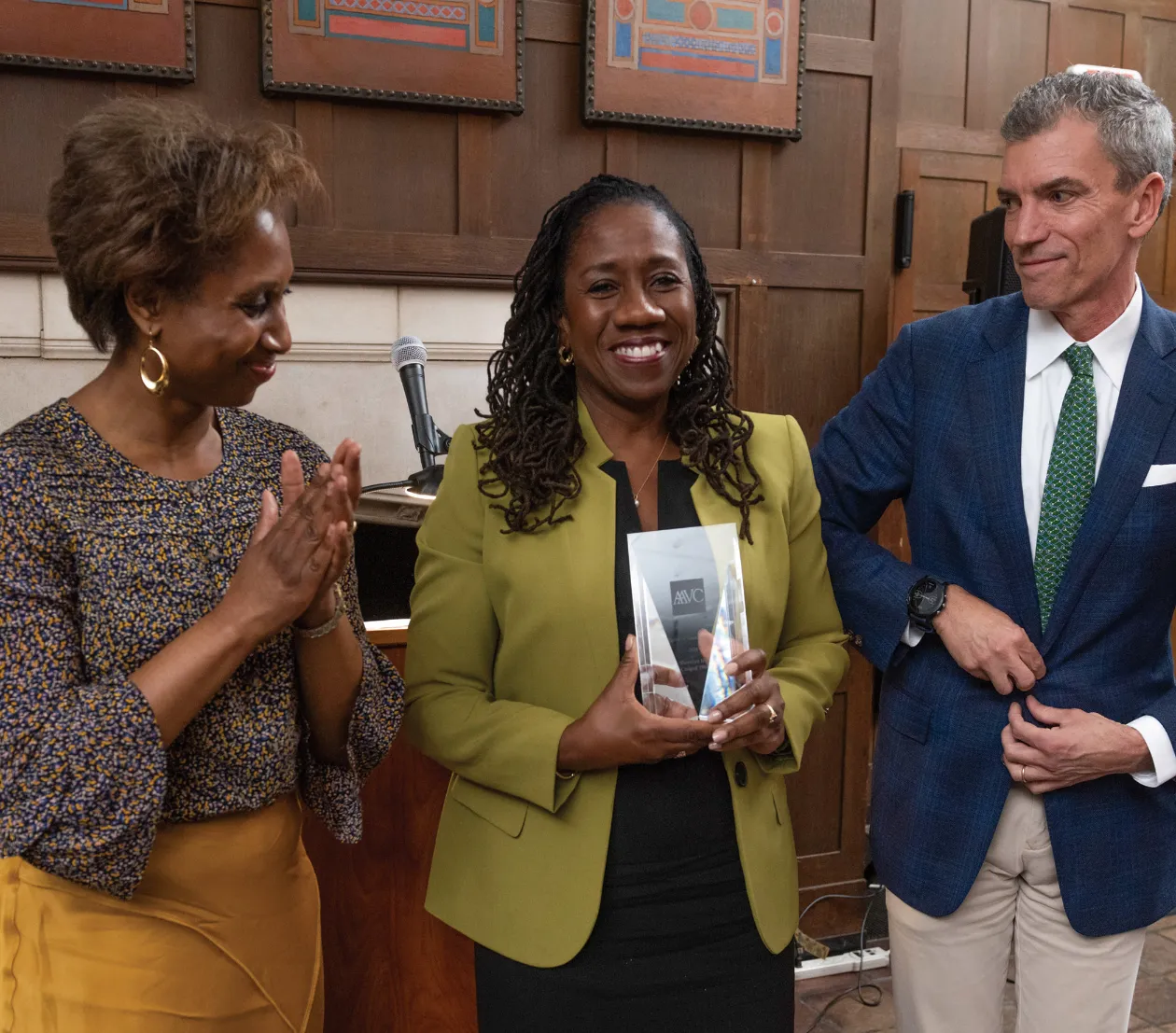
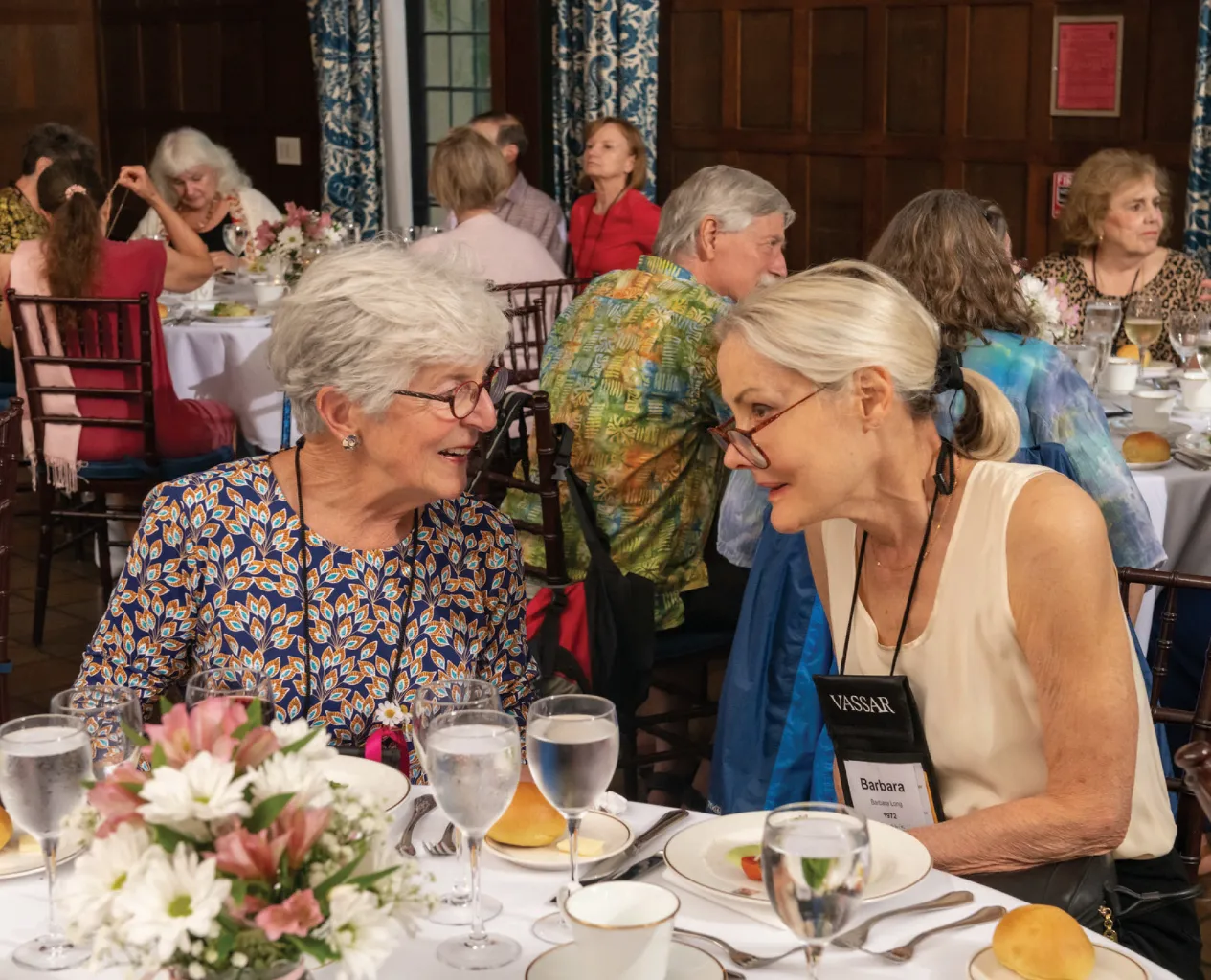
Karl Rabe
Reunions
Community Events
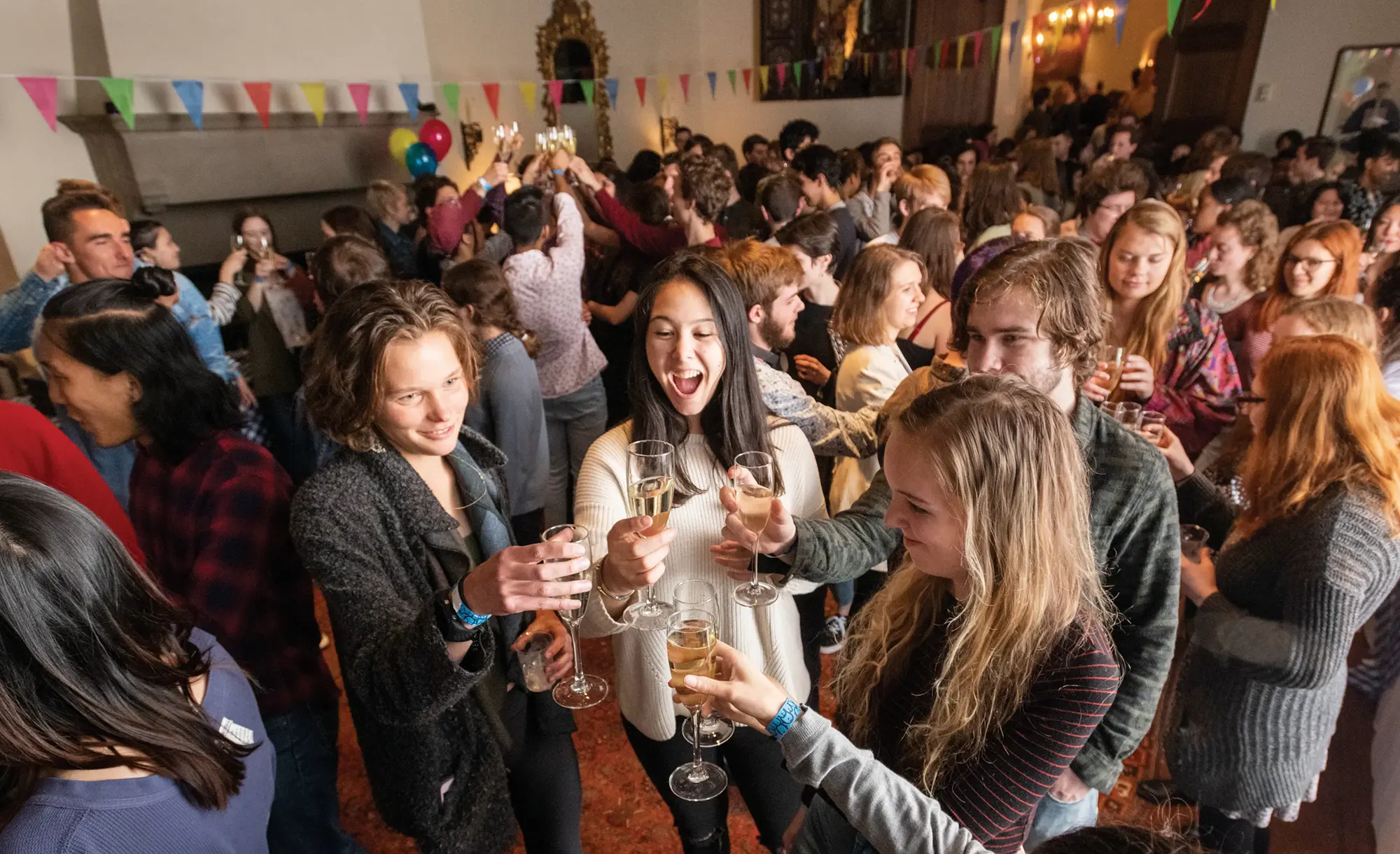

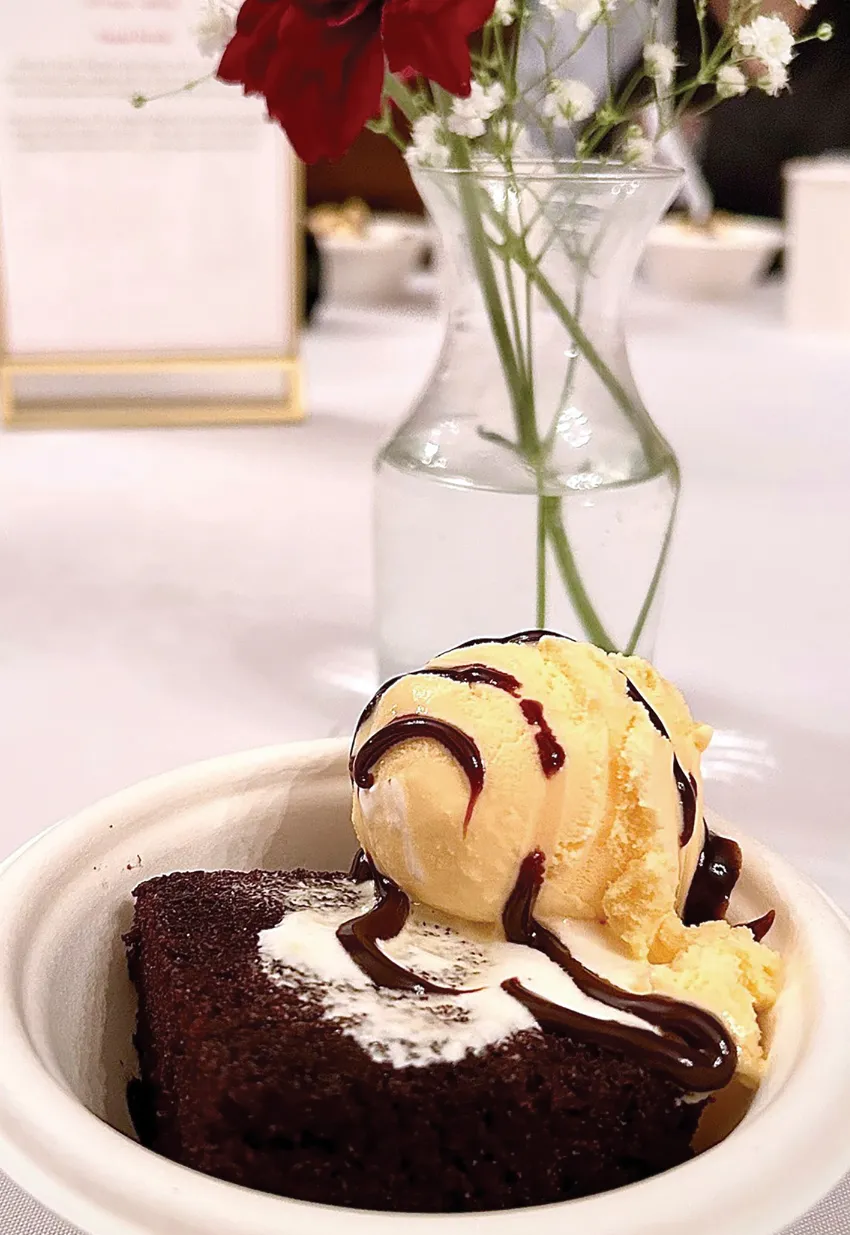
Logan Walker ‘27
student engagement
Since 2008, seniors have marked 100 nights before graduation with a party at Alumnae House bearing that name—100 Nights. There’s something about being close to the finish line that encourages revelry. Even closer to graduation, during Senior Week, students have traditionally gathered at Alumnae House for their Senior Receptions to celebrate the upcoming milestone. Who remembers posing for their senior class picture on those Vassar-famous steps?
Between their first year at the College and the last, students get the opportunity to visit the House for all manner of receptions, recitals, lectures, workshops, and panels.
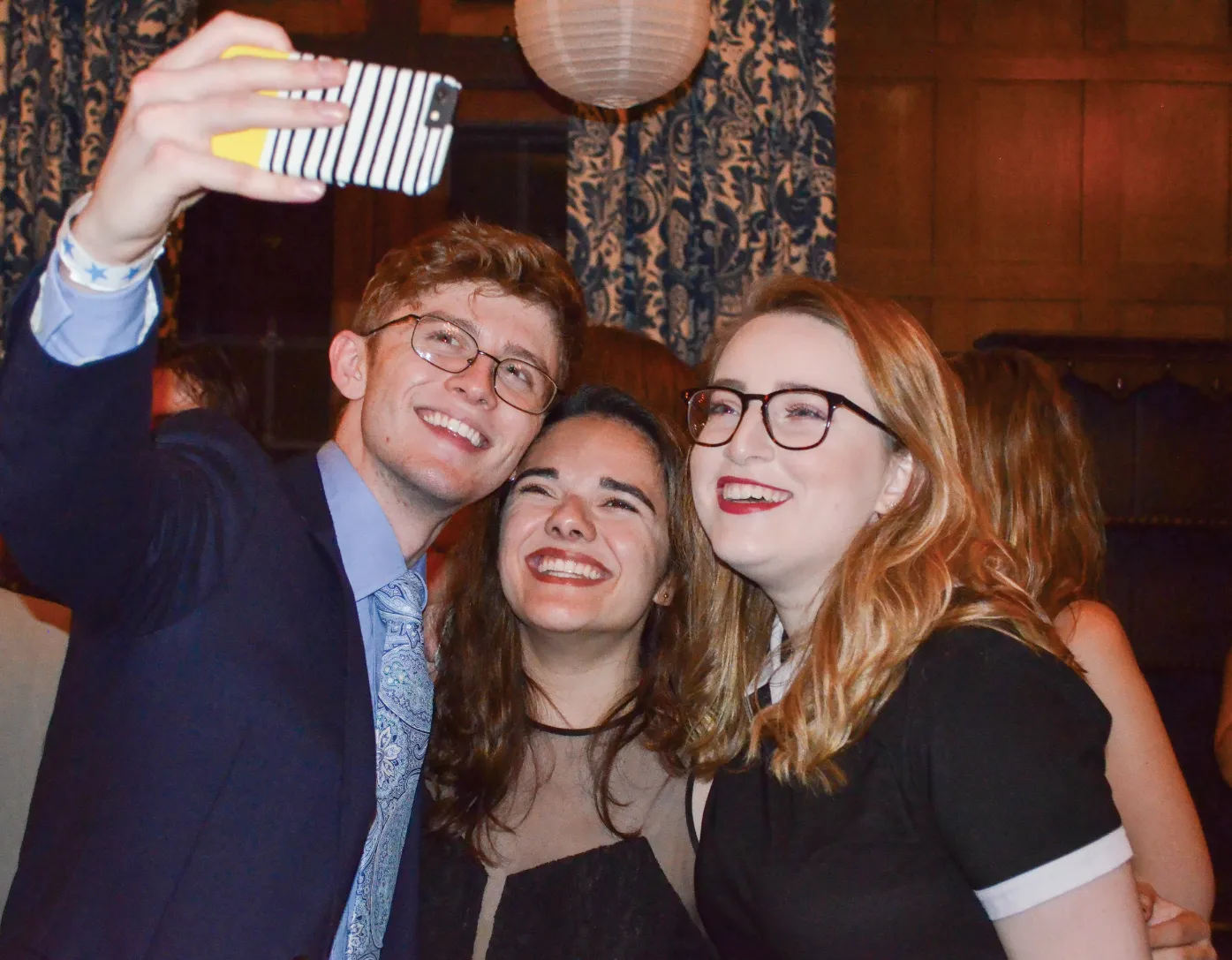
Karl Rabe
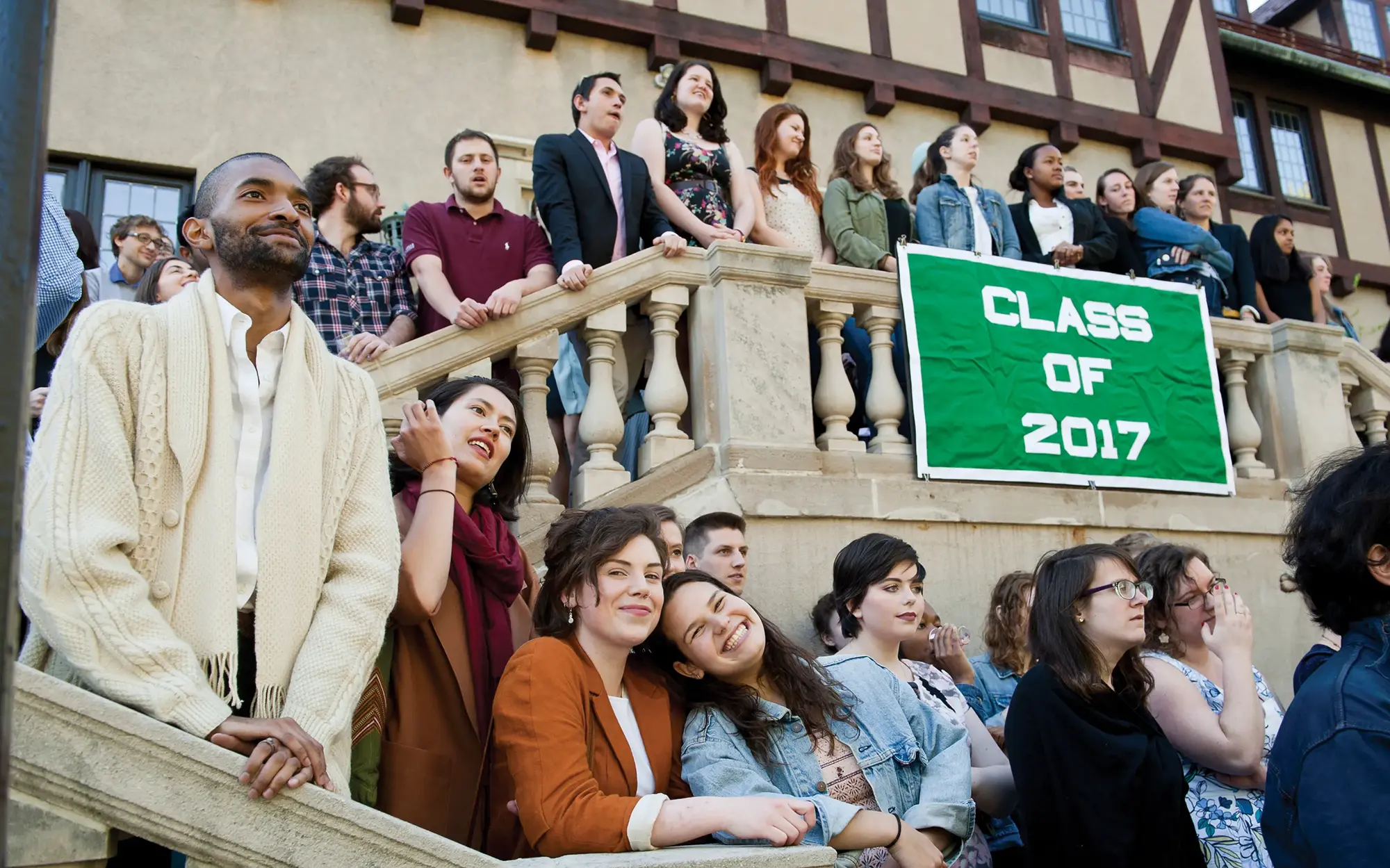
 Bookends
Bookends
 Bookends
Bookends
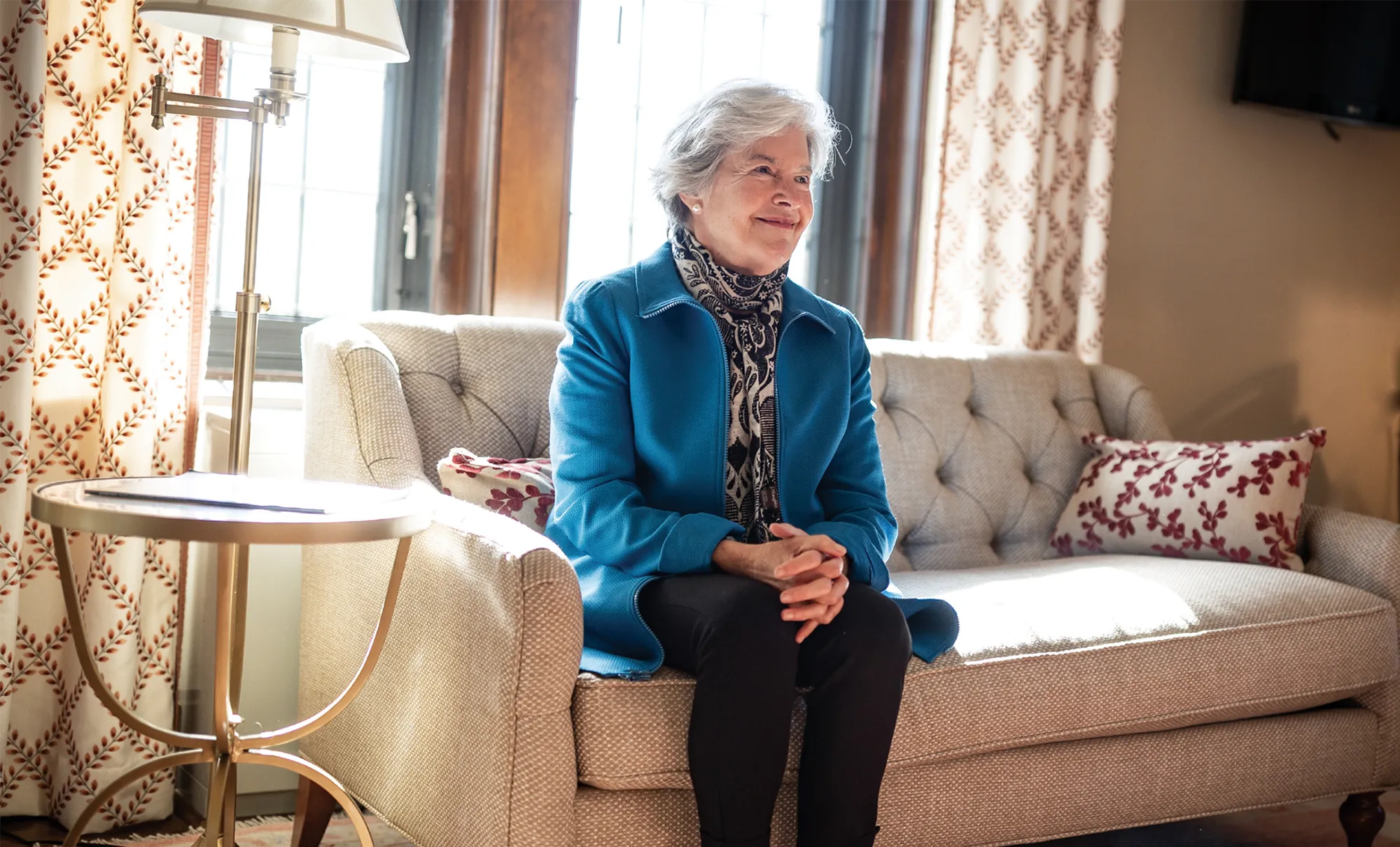
Sally Dayton Clement ’71, P’09, a clinical social worker and psychoanalyst based in New York City and Millbrook, NY, and Ellen “Elly” Dayton Grace P’03, a multidisciplinary artist who resides in Minneapolis, MN, come from a long line of generous citizens invested in supporting their communities.
Their mother, Mary Lee Lowe Dayton ’46, had been active in civic affairs and the feminist movement and worked to support such women’s organizations as Planned Parenthood. She established a fund now known as the Women’s Foundation of Minnesota, which focuses on community-based programs that “ensure safety, opportunity, and pathways to economic security for women, girls, gender-expansive people, and families across Minnesota.”
Their father, Wallace C. Dayton, had been keenly interested in environmental conservation; he led and supported such organizations as The Nature Conservancy and the National Audubon Society.

In the early 2000s, Sally, then a new Vassar Trustee, told Mary Lee the College had raised most of the money to renovate Alumnae House, but was still looking for funds to install air conditioning. Mary Lee asked, “Why aren’t they asking us for money?” She thought those who had adopted Alumnae House as their dorm for one “cozy” year would be happy to support the renovation of the building. She certainly stepped up, donating the funds to make the house a comfortable place to stay year-round.
In a tribute published in VQ after Mary Lee’s death, her Alumnae House roommate, Katherine Winton Evans ’46, noted that Mary Lee—whom the Minneapolis Star Tribune had dubbed “a civic lioness”—had also funded a renovation of the Wimpfheimer Nursery School, where she’d spent a good deal of time as a child study major (Mary Lee later worked as a kindergarten teacher). But Katherine noted that Alumnae House would remain one of Mary Lee’s “favorite cubs.”
The tradition of giving continues with the sisters. When asked what their mother would say if she were alive, Sally says, “She would be very happy to see that Elly and I are giving a gift to a place as meaningful to her as Alumnae House. The philanthropic tradition really inspires me, and I’m sure Elly, also. Our parents had a model for being involved in organizations they cared about both in terms of money and time.”
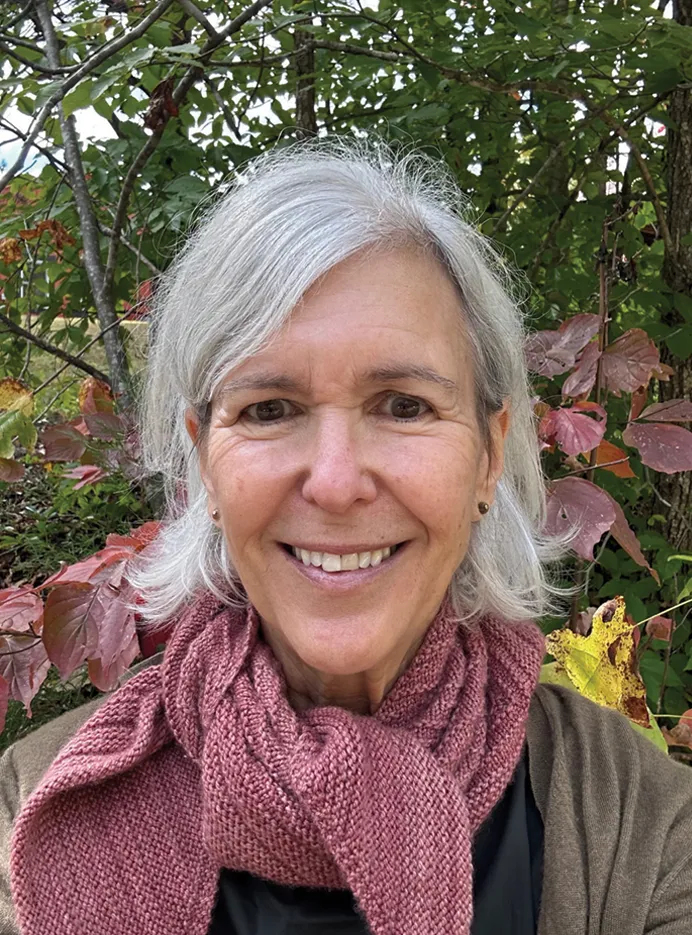

It doesn’t hurt that she owes a debt of gratitude to Vassar for helping her meet her husband, Stephen. “My classmate Margot [Clement Clark] invited me home to Buffalo Easter weekend freshman year because she felt sorry for me. I had no place to go that long holiday weekend,” says Sally, who hails from Minnesota. “It was then I met her big brother.”
For her part, Elly says, “It’s kind of sweet that I get to combine this gift with my sister.” Though she is not an alum, she has seen how Vassar has benefited her daughter Katy Sturgis ’03. “My daughter has so many good memories of Vassar. She still has very close ties to the friends she made there, strong connections,” she says. “So it definitely inspires me to support the school.”
As Vassar’s new Inn is constructed down the hill, a stone’s throw from the House, Sally is convinced that the venerable building will remain relevant for those who call Vassar their alma mater. “Alumnae House is a reflection of Vassar’s history and longevity. It’s an old-fashioned building that is beautiful and charming,” she says. “That reflects the College’s roots. And the two buildings side-by-side really show Vassar is anchored in the present, too.”
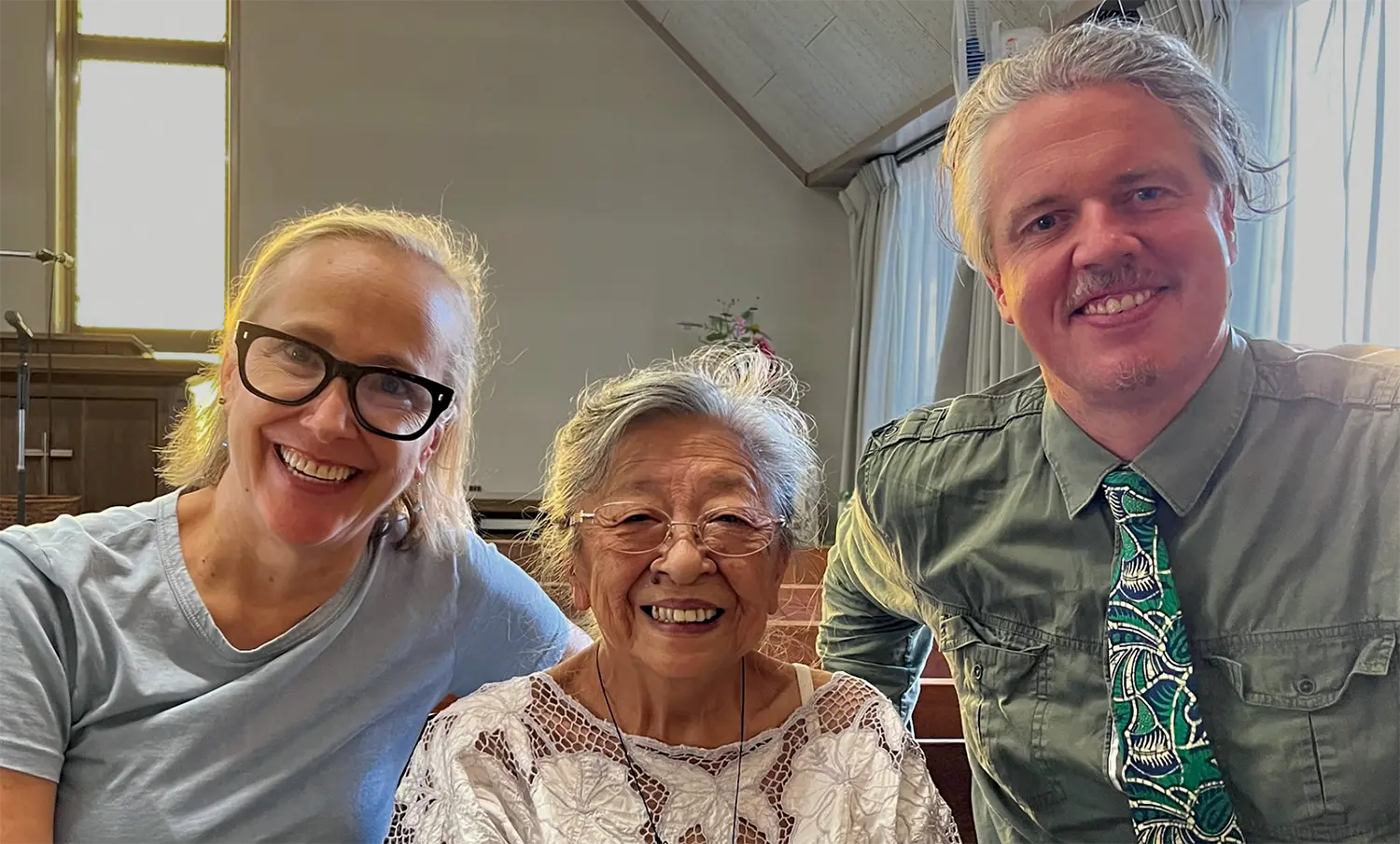
Courtesy of the subjects
Alums bring John Hersey’s Hiroshima to the Big Screen
John Hersey’s Hiroshima, an account of the experience of six hibakusha, or survivors of the blast, published in the August 31, 1946, issue of The New Yorker, was the first widely available document to tell Americans what really happened on the ground. The piece—which comprised the entire issue of the magazine—described not only the mass casualties that occurred, but the effect on individual civilians, many of whom were severely wounded or developed disabling, sometimes fatal, radiation sickness.
Hersey’s trip to the decimated city seven months after the bombing and the article that grew out of it is now the subject of a new independent feature film—currently in development—conceived by producer and visual artist Cannon Hersey ’99, John Hersey’s grandson. Joining him on the project, which is scheduled to begin shooting next June, are producer Donald Rosenfeld ’85, screenwriter Elisabeth Bentley, who attended Vassar as a freshman, and archivist/operations manager Jason Jhung ’98.
“Hiroshima has been called the best piece of journalism in the 20th century, one that would shape perceptions about nuclear proliferation for generations to come,” Cannon Hersey says. The piece made his grandfather, who had already distinguished himself as a war correspondent, a household name.
“He was a witness when everyone else was reluctant [to speak],” Rosenfeld adds. “And he told a bolder story than anyone [had] imagined.”
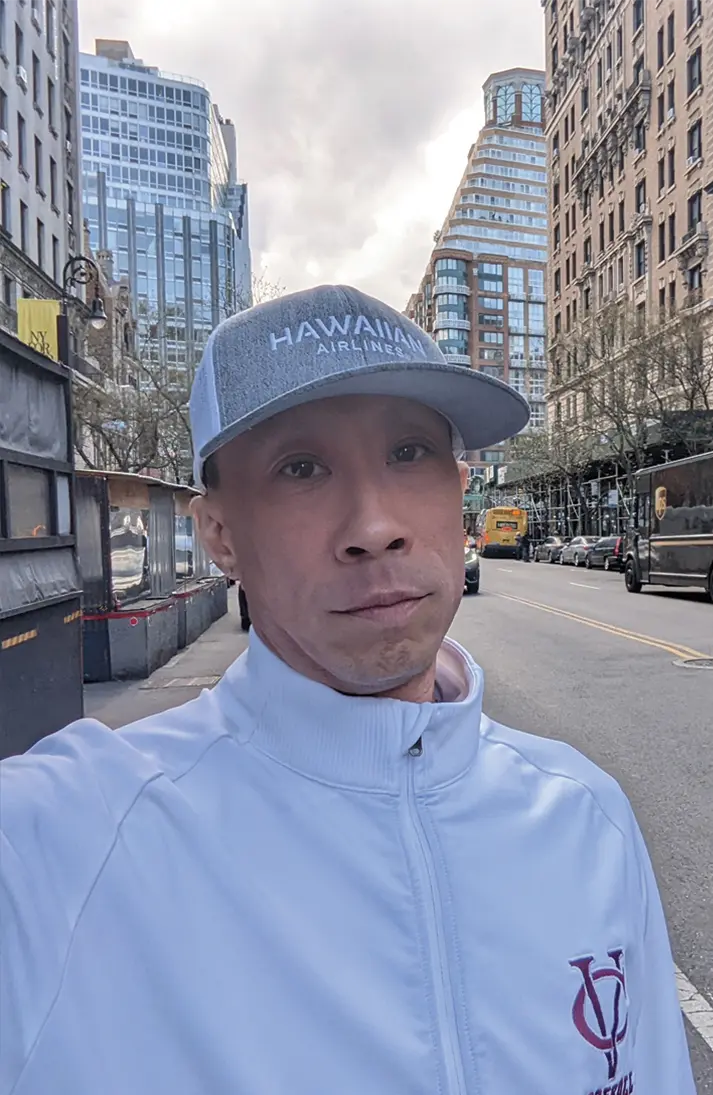
Courtesy of the subject
One challenge facing the filmmakers was Hersey’s approach to journalism and his personal reserve. He didn’t talk about his experience in Hiroshima with this family, and he gave very few interviews. “He chose to let the words on the page speak for themselves,” Cannon Hersey says.
Fortunately, John Hersey’s papers have been archived at the Beinecke Rare Book & Manuscript Library at Yale, providing the filmmakers with a trove of information. It was there that Bentley made a fortuitous discovery, a 230-page unpublished memoir by Reverend Kiyoshi Tanimoto, a Methodist minister and one of the hibakusha Hersey interviewed.
“While John Hersey wrote himself out of the story, Tanimoto describes his experience [vividly], what he thought, what he saw, and what he felt. He was a unique voice in Japan,” Bentley says. Her treatment focuses on the two weeks Hersey and Tanimoto spent together, using their relationship as a lens through which she tells the larger story.
Research has also offered new insight into the role of Hersey’s wife, Francis Ann Cannon, who was not only an intellectual partner to the journalist, but had family connections that helped pave the way for his entrée to Japan.
After the war ended, Tanimoto, already considered suspect by some Japanese for following a Western religion, was criticized by many for speaking out about the horrors he had witnessed. Hersey’s work, though widely acclaimed, was countered by those advancing the official government position: that the bombings were necessary to save additional lives.
Both Cannon Hersey and Rosenfeld view their project as a way of bringing global attention to the ongoing threat of nuclear warfare and the growing movement to end the proliferation of nuclear weapons. Building on their commitment to bringing an international perspective to the issue, the American team is partnering with a Japanese production company on the film.
“Oppenheimer told the first part of the story. We’re going to tell the next chapter,” Rosenfeld says, noting that the success of this past summer’s film about the building of the atomic bomb has created an audience that is ready to learn more.

Samuel Stuart Photography
“There’s a lot of material that still hasn’t been catalogued,” Jhung says. “My focus is on finding the best way to structure information and make it accessible.” He’s also looking forward to sharing media and resources with the Japanese team.
After writing Hiroshima, which was subsequently published as a bestselling book, John Hersey didn’t return to Japan for almost 40 years. In 1985, he added a chapter describing the fates of the six survivors. He would also write an essay about the internment of Japanese-Americans in Manzanar that accompanied a book of photographs taken by Ansel Adams.
“For the rest of his life my grandfather spoke out about racism, the right to vote, and the social issues of his time, including the Vietnam War,” Cannon Hersey says. John Hersey also continued publishing both nonfiction and novels and taught writing at the university level. As a teacher “he was committed to the next generation of storytellers,” says the grandson. “It was not just about his voice, but many voices.”
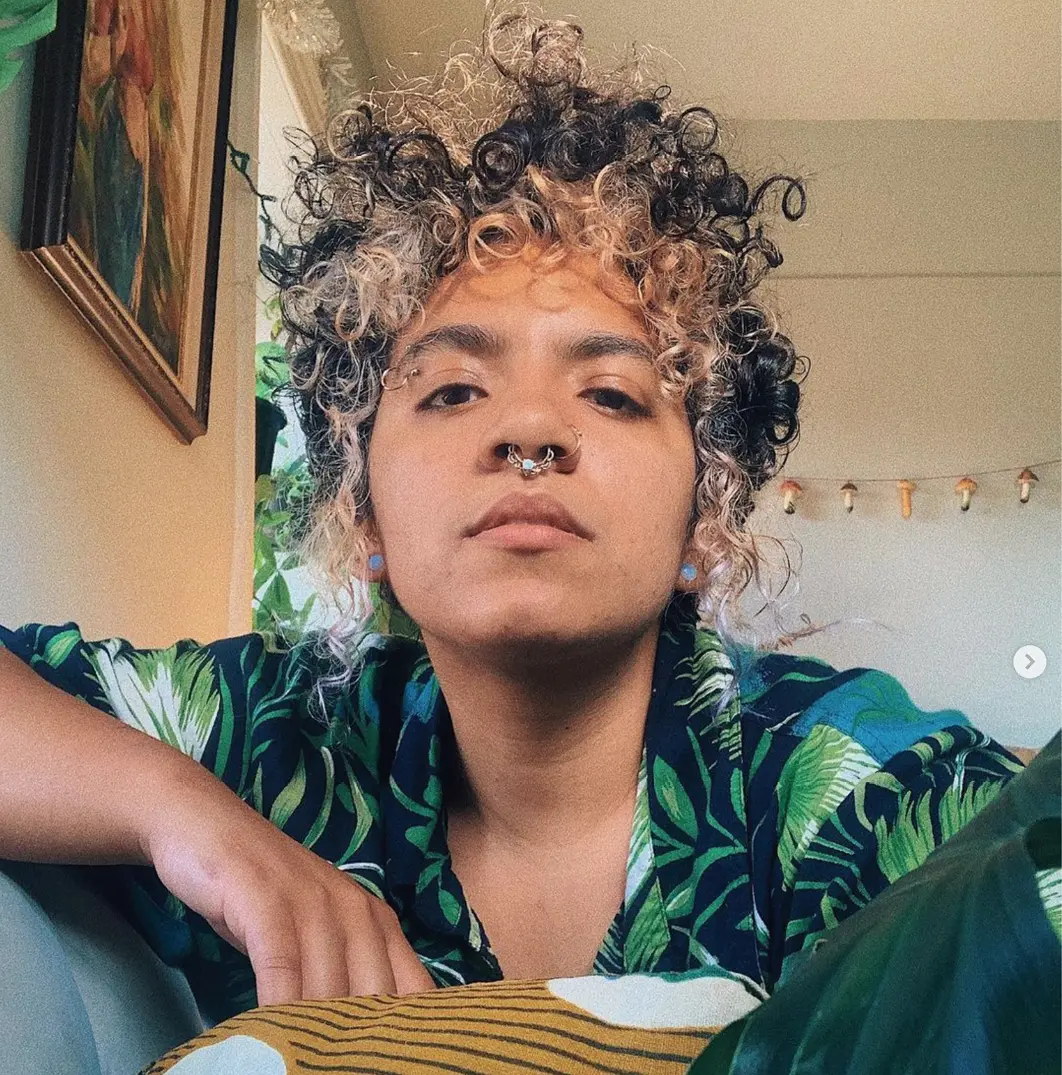
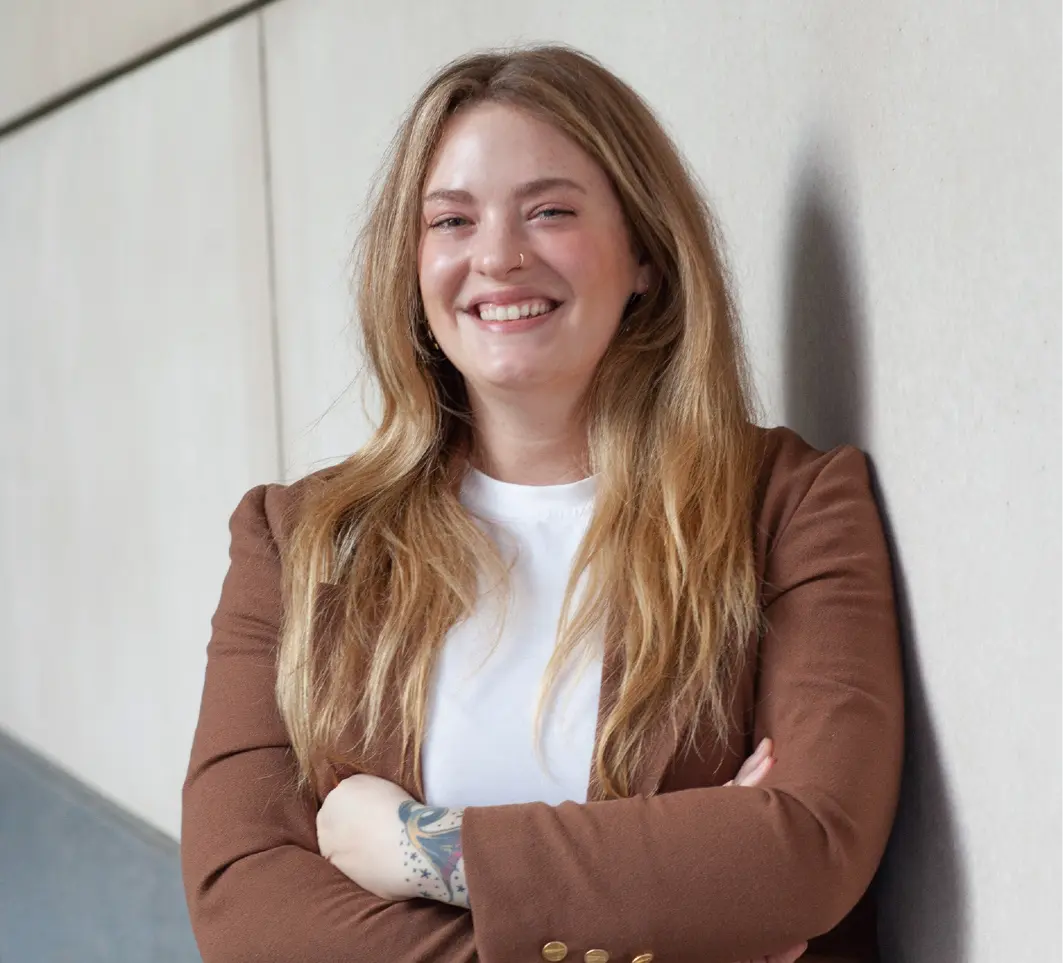

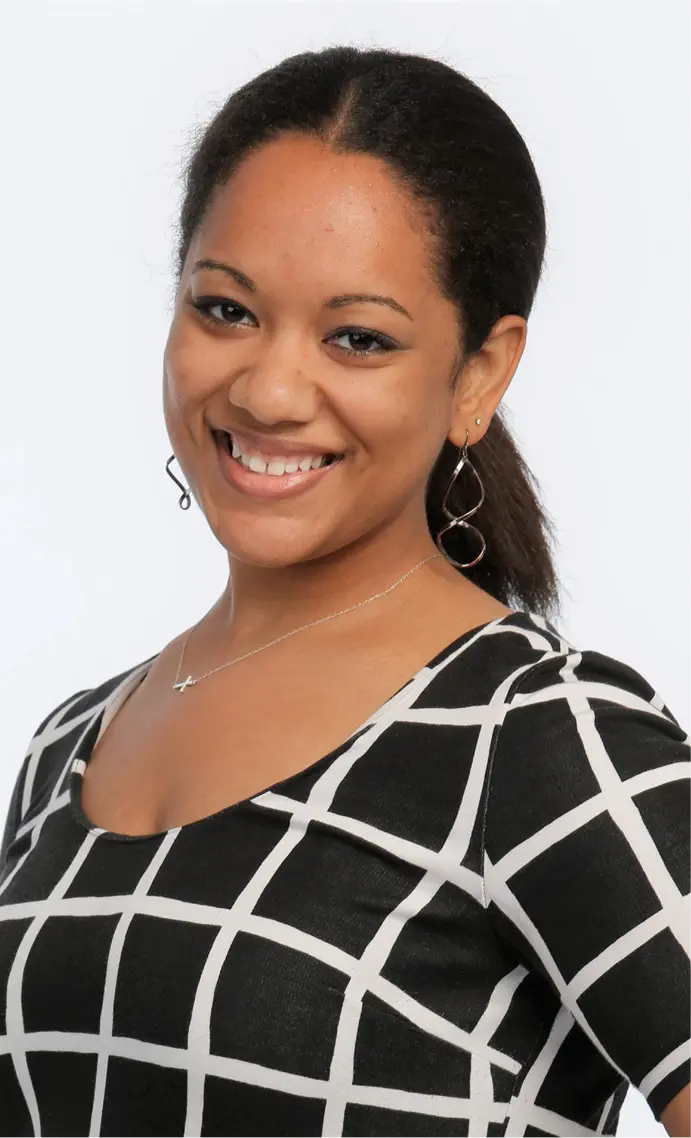
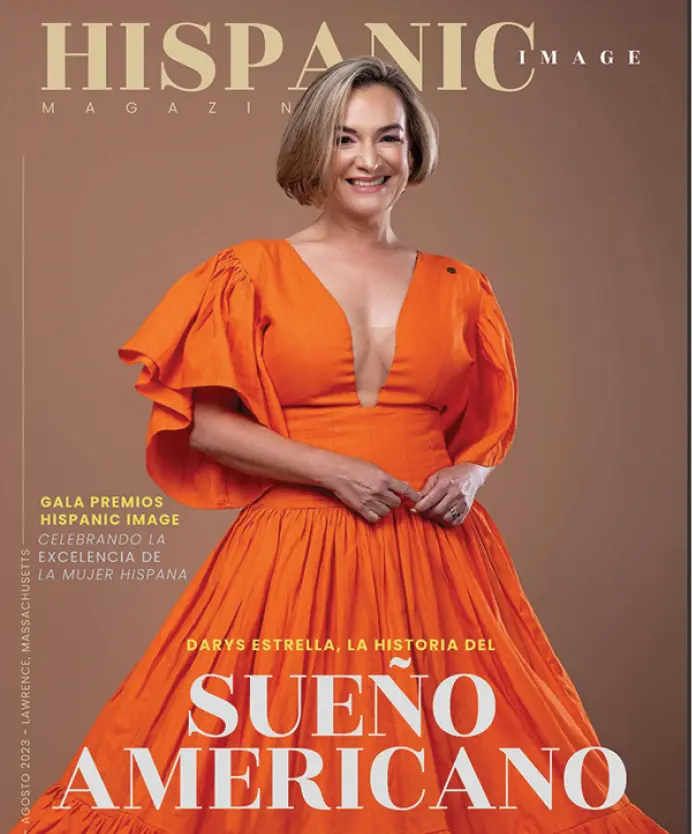
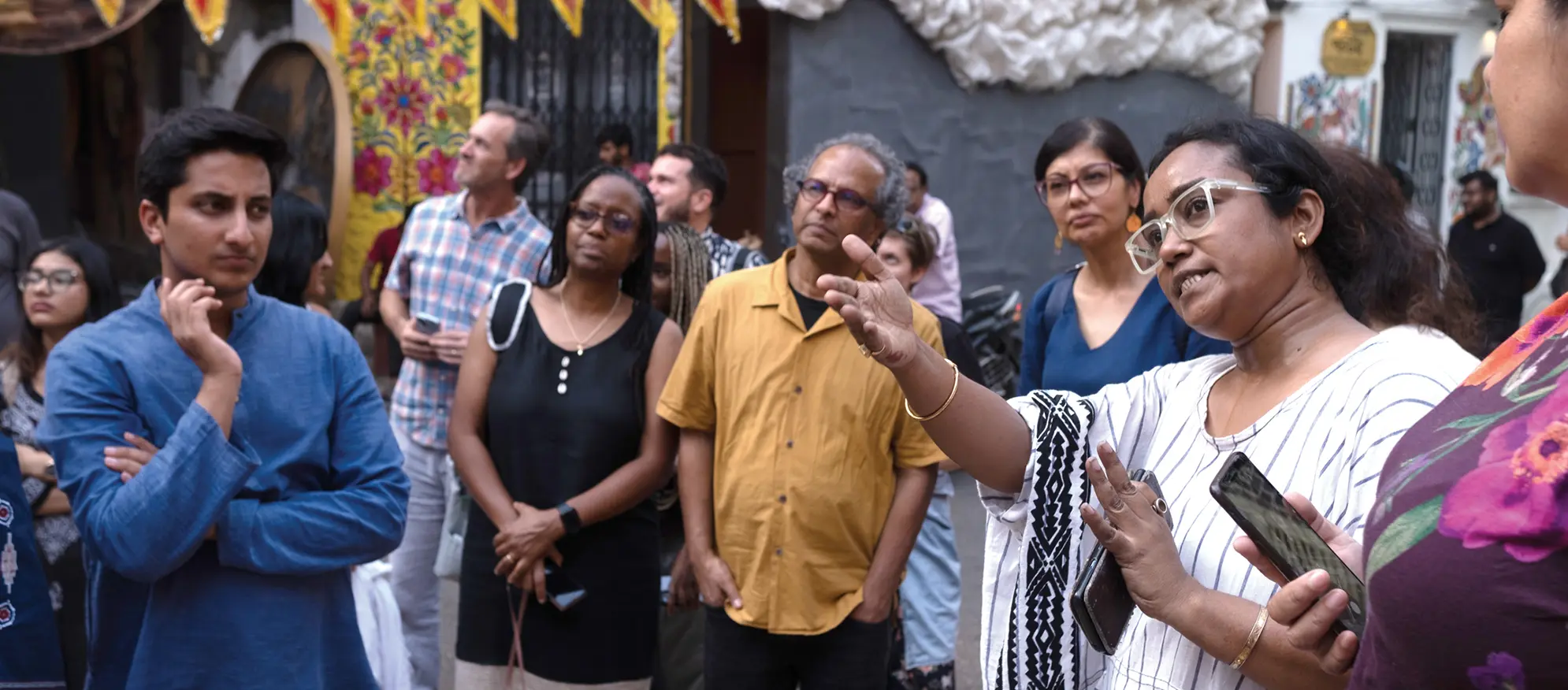
Madhabendu Hensh
Gathering of the Vassar Club of South Asia Expands Opportunities for Connection
Kolkata’s Durga Puja, an open-air art festival that made the UNESCO List of the Intangible Cultural Heritage of Humanity in 2021, showcases pandals—elaborate, temporary structures to venerate the goddess Durga. Divides of class, religion, and ethnicity dissolve among crowds visiting pandals scattered across hundreds of Kolkata paras (neighborhoods). The VCSA program proved to be a culturally rich, affordable, intergenerational program, and an open-source model leveraging the Club leadership’s local networks and cultural sites.
Vassar faculty hosts Candice Lowe Swift, Associate Professor of Anthropology, and Himadeep Muppidi, Professor of Political Science, facilitated daily academic modules, conversations with local thought leaders, pandal visits, and culinary experiences.
“As a teacher, it’s like, wow, there’s Zoom, there’s the classroom, and there’s being present,” Muppidi reflected. “You get such a rich sensorial experience; the questions you can raise, and the issues you can talk about, are just so much more complex.”
Academic modules included interactive sessions with Dr. Tapati Guha-Thakurta, author of the dossier that secured Durga Puja’s UNESCO recognition; Debanjan Chakrabarti, Director, British Council East India; Melinda Pavek, U.S. Consul General, Kolkata; Ruby Palchoudhuri, President Emerita, Crafts Council of West Bengal; and a panel of several young artists/designers moderated by Anamika Debnath, Centre Coordinator of the Foundation Program of the National Institute of Fashion Techno-logy, Kolkata.
VCSA collaborated with Sayantan Maitra Boka of massArt, a Kolkata-based NGO, to preview pandals across the city before the main festival began. Pandal designers and neighborhood organizers generously shared insights into design concepts, materials, and themes. Some pandals were completed, while others were still in progress due to the late rains this season, allowing us to see both process and finished product. Our attempt to visit pandals in North Kolkata was thwarted by heavy Puja traffic—an authentic Kolkata experience. Our three-and-a-half-hour bus ride let us connect, reflect on our experiences, and think about urban impacts and the infrastructure challenges Kolkata will face with increased international tourism following UNESCO’s designation—all while we enjoyed some roadside dhaba coffee.
We left Kolkata with more questions than answers, more curiosity than affirmations. Ben Hinerfeld ’92 was visiting India for the first time. “The trip has made the world much larger—but more intimate—for me,” he shared. American Studies major Lavanya Manickam ’25 said, “I’m so grateful to all the people we met who shared Kolkata with us. I’ve been wondering—how can we engage in a practice of cultural exchange that truly respects the care and dedication we have for each other?”
-
NONFICTION
A History of Boston
by Daniel Dain ’93
Peter E. Randall Publisher, 2023 - Invasive Plants, Guide to Identification and the Impacts and Control of Common North American Species, 3rd Ed.
by Sylvan Kaufman ’92 and Wallace Kaufman
Stackpole Books, 2023 - The Jazz Masters
by Peter C. Zimmerman ’80/81
Peter C. Zimmerman and University Press of Mississippi, 2023 - Stitching Love and Loss: A Gee’s Bend Quilt
by Professor Lisa Gail Collins
University of Washington Press, 2023 - I Love Russia: Reportage from a Lost Country
by Elena Kostuychenko, translated by Ilona Yazhbin Chavasse ’00
Penguin Press US, 2023 - Radical Play: Revolutionizing Children’s Toys in 1960s and 1970s America
by Rob Goldberg ’01
Duke University Press, 2023 - Single at Heart: The Power, Freedom, and Heart-Filling Joy of Single Life
by Bella DePaulo ’75
Apollo Publishers, 2023 - When Bad Things Happen to Privileged People: Race, Gender, and What Makes a Crisis in America
by Dara Strolovitch ’92
University of Chicago Press, 2023 - The Black Joy Project
by Kleaver Cruz ’11
Mariner Books, 2023 - She Devils at the Door
by Eliza Smith Brown
Carnegie Mellon Press, 2023 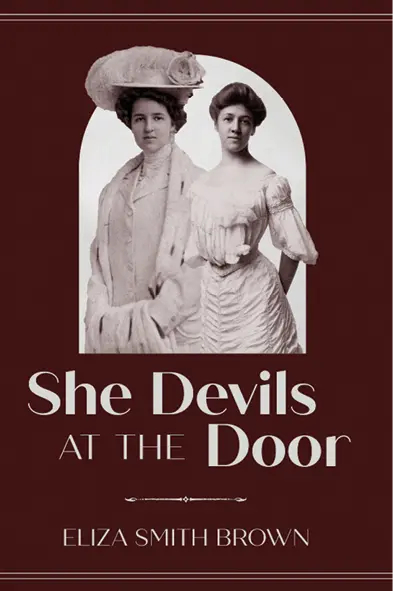
- More Than We Expected: Five Years With a Remarkable Child
by James Robinson ’97
Post Hill Press, 2023 
- From Christians to Europeans: Pope Pius II and the Concept of the Modern Western Identity
By Professor Nancy Bisaha
Routledge Press, 2023 
-
FICTION
My Beloved Life
by Professor Amitava Kumar
Knopf, 2024 
- The Song of Us
by Kate Fussner ’09
Harper Collins, 2023 - The Disappeared: Stories
by Andrew Porter ’94
Knopf, 2023 - Russian Gothic
by Aleksandr Skorobogatov, translated by Ilona Yazhbin Chavasse ’00
Old Street UK, 2023 - Hello Stranger
by Katherine (Pannill) Center ’94
St. Martin’s Press/Macmillan, 2023 - The Goodwill Mission
by Pari Forood ’81
Austin Macauley Publishers, 2023 -
POETRY
Displaced Dolls and Oviducts
by Marigo Stathis ’87
Finishing Line Press, 2023 -
MUSIC
The Undiscovered Viola d’Amore
by Paul V. Miller ’98
Centaur Records, 2023 - Please send all submissions of new publications to vq@vassar.edu with a high-resolution copy of the cover, if you have one.
When Oppenheimer Came to Campus
In October 1958, about a decade and a half after leading the Los Alamos Laboratory in developing the atomic bomb as part of the Manhattan Project, Oppenheimer came to Vassar. Then the Director of the Institute for Advanced Study, he gave a speech in the Chapel and spent the next day visiting classes and meeting with students, faculty members, and science clubs. He also did an interview with The Miscellany News, telling the student newspaper that education was a “roadmap” to knowledge areas, but also that one should not take it too seriously because the roads are always being torn up.
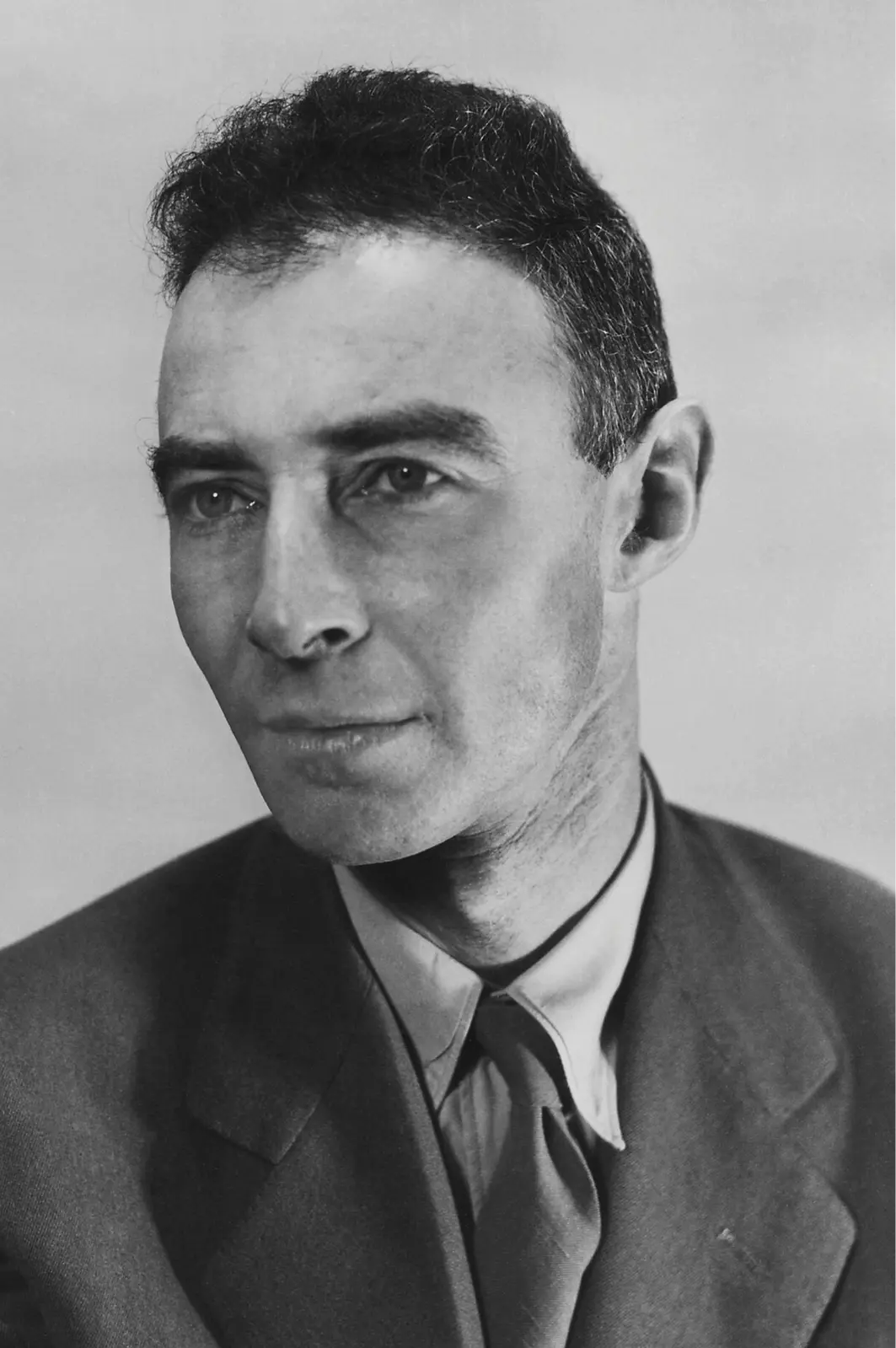
U.S. Department of Energy
So when Oppenheimer arrived in Poughkeepsie, the Vassar community must have been eager to hear his thoughts. In his speech, “Knowledge and the Structure of Culture,” he focused on the expansion in human knowledge. “Today it can hardly be doubted that every 10 years or so we know twice as much as we did 10 years before,” he told the audience. Information did not go to everyone or to individuals, but instead to communities of specialists “who are in charge of that particular adventure,” he said. A person can’t know everything and instead must “ignore a great deal which, as an organism, we are perfectly capable of knowing,” he continued, “blotting out a great part of the truth in order that some truth may be perceived.”
He concluded by saying that in uncertain times, science provides order. “In this vast world, with its unceasing change and its immense novelty, without precedent, beyond easy comprehension,” he said, “there are present for us these beautiful, simple, always growing perspectives of order, more than ever before in man’s history.” He received a standing ovation.
Memories of the lecture would remain with students for decades. Katie Webb Johnson ’62, who was just weeks into her freshman year, didn’t know much about Oppenheimer ahead of the talk. “I remember being extremely impressed by him as a speaker,” she says. “But I was struggling to keep up because I was not well versed in those things.” She recalls others in the audience having stronger thoughts about the speaker, given the security-clearance controversy, which even the Misc. alluded to in the lead-up to the lecture. “There was a significant emotional aura, cloud, around his speech,” Johnson remembered—many students in the audience “had opinions.”
Off campus, alums debated the merits of inviting Oppenheimer, too. Writing to VQ, a 1928 alum questioned why Vassar would invite such a poor security risk. “Is loyalty to country in poor repute at Vassar these days?” she asked.
Associate Professor of Physics and Science, Technology, and Society José Perillán, who directs the STS program, has incorporated Oppenheimer’s lecture into a class. He typically has students analyze a 1959 essay by philosopher of science Thomas Kuhn, and this fall he added the Oppenheimer talk, “putting them into conversation,” he says. “It’s just a fascinating point/counterpoint of a historian of science who was trained as a scientist, and this great scientist, Oppenheimer, who’s reflecting on knowledge and the creation of knowledge and our modern scientific enterprise.”

Library of Congress
Tatlock arrived at Vassar after her father, a literary scholar and professor at another institution, had spoken on campus multiple times. As a student, her social justice concerns were in evidence. Writing for the Misc., Tatlock penned an eyewitness account of a labor strike, and made the local news when she and other students wrote a letter in support of people who were marching for food and shelter. A Poughkeepsie Eagle-News editorial said the letter “will doubtless start new comment about radicalism at Vassar.”
As this summer’s film depicts, Oppenheimer and Tatlock’s relationship was complex. They met through friends at Berkley the year after she graduated from Vassar (she was a graduate student and Oppenheimer was a physics professor). She is said to have introduced him to the Communist Party. He later testified that they almost married twice. He instead married Katherine “Kitty” Harrison in 1940, but he and Tatlock, who would go on to become a psychiatrist, continued to meet. They are last known to have seen each other in 1943, an encounter that alarmed U.S. intelligence due to concerns that Oppenheimer might use Tatlock to pass information to the Soviets.
The following year, Tatlock, who had battled depression throughout her life, was found dead by an apparent suicide, though Kai Bird and Martin J. Sherwin in their book American Prometheus: The Triumph and Tragedy of J. Robert Oppenheimer explored other theories, including assassination.
Oppenheimer addressed their relationship during his security hearing a decade later, telling the panel, “She loved this country and its people and its life.” What he didn’t say was that she may have had trouble being happy in her own.
Letter from the President of the AAVC
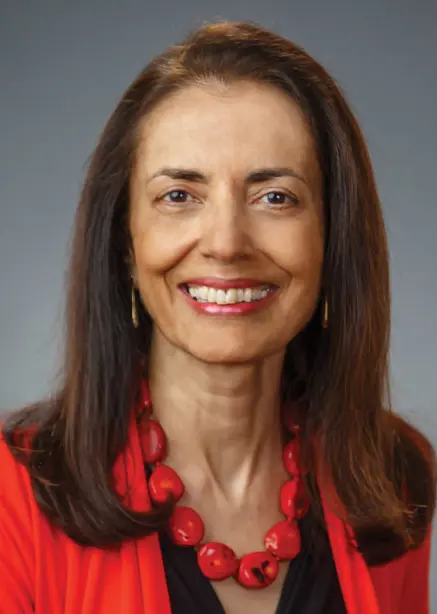
I write to you at a time of unsettlement and sadness around the world and in our community. We have heard from many of you about the gender pay equity lawsuit and about the horrific situation in Israel/Gaza. Please know that we hear you, that the College is responding to both issues in real time, and that the AAVC is here to support you.
Meanwhile, we remain committed to the other work of the AAVC, including, importantly, the celebrations for the 100th anniversary of Alumnae House in 2024.
The AAVC Board House Committee, led by James Estrada ’13, with Vice Chair Alisa Swire ’84, and working closely with Martha Barry ’86, is immersed in extraordinary preparation for this very special occasion. There are plans afoot for several celebrations during 2024, and we so hope each of you will be able to join at least one of them. We have also embarked upon archival research and brainstorming about how best to honor the history of the House, while charting a path forward that reflects the diversity of our present and leads us into the future. Some of you have shared memories and anecdotes of your experiences at Alumnae House, and we welcome all of you to send a quick note with your story to vq@vassar.edu. Alumnae House continues to be the warm and welcoming space that was founded to provide a home to alums returning to campus, and we hope you find occasion to visit or spend the night in the beautifully redone rooms. Even just sitting in the lobby is a transportive experience!
Our other AAVC committees are embarking on their work, whether it be for nominations, career networking, awards, annual fund, or alum engagement of all varieties. Woven through all of our efforts is a core emphasis on diversity and equity, coupled with inclusion and a sense of belonging. Our DEI committee is focused on embedding these principles into the work of the AAVC, at the board level and beyond, and our October meetings began with a workshop on these fundamental issues.
Please reach out with thoughts, reactions, suggestions, or anything else on your mind. I would love to hear from you.
Wishing you a safe and healthy autumn,

aavcpresident@vassar.edu

- Monica Vachher ’77, Illinois
President and AAVC Trustee - Brian Farkas ’10, New York
Vice President and AAVC Trustee - Tyrone Forman ’92, Illinois
Vice President and AAVC Trustee - Anne Green ’93, New Jersey
Nominating and Governance Committee Chair - Katrine “Cage” Ames ’69, New York
- Gail Becker ’64, New Jersey
- Maybelle Taylor Bennett ’70, Washington, DC
- Alexandria Dempsey ’09, California
Class Engagement Committee Chair - Patrick DeYoung ’18, California
AAVC Trustee - AC Dumlao ’13, New York
- James Estrada ’13, Michigan
Alumnae House Committee Chair - Justin Hergianto ’04, New York
Communications Advisory Committee Chair - Delia Cheung Hom ’00, Massachusetts
AAVC Trustee
Diversity, Equity, and Inclusion
Ad Hoc Committee Chair - Peggy Ann Nagae ’73, Oregon
- Katherine “Kat” Mills Polys ’93, Virginia
Vassar Fund Committee Chair - Amy Pullman ’71, Virginia
Alumnae/i Recognition Committee Chair - Chip Reid ’77, Washington, DC
- Sheryl Smikle ’81, Georgia
- Andrew Solum ’89, United Kingdom
Clubs Committee Chair - Keith St. John ’81, New York
- Alisa Swire ’84, New York
- Carlos Hernandez Tellez ’14, Brazil
Career Networking Committee Chair - Ellie Winter ’18, Rhode Island
Student and Young Alumnae/i Engagement
Ad Hoc Committee Chair - Lisa Tessler
Associate Vice President and
Executive Director of the AAVC - Patricia Lamark
Program Associate, Alumnae/i Engagement


-
1936
Ethel Stacy Aldridge
April 30, 2017 -
1936
Candace Collins Benton
February 8, 2003 -
1936
Violet Salmanowitz Klosty
July 6, 2015 -
1942
Jane Tawney Klassen
November 10, 2013 -
1944
Diana Klemin
July 24, 2023 -
1944
Barbara Bitting Frazer Lowe
March 28, 2023 -
1944
Jean Hamilton Mulford
October 6, 2019 -
1944
Sallie Welsh Van Arsdale
May 26, 2023 -
1945-4
Sarah Raymond Rathvon
May 21, 2021 -
1945
Betty Watkins Blair
March 4, 2008 -
1945
M. Anne Fezandie Goodwin
January 19, 2023 -
1945
Ellen Zinsser Green
August 15, 2023 -
1945
Rhoda Levine Marks
July 23, 2023 -
1946
Nanette Chaitt Barcus
August 7, 2020 -
1946
Nancy Peterson Brewster
February 17, 2016 -
1946
Elizabeth Crapo Klemann
January 21, 2023 -
1947
Mary Fite Black
May 6, 2023 -
1947
Alice Colonna
April 26, 2023 -
1947
Mary Handy Parker
June 19, 2023 -
1949
Joan Hoiness Bouchelle
August 9, 2023 -
1949
Lila Gimprich d’Adolf
October 27, 2022 -
1950
Rita Conger Banning
April 24, 2023 -
1950
Mildred Welch Clough
July 28, 2023 -
1950
Elisabeth Petschek de Picciotto
August 14, 2023 -
1950
Janet Herrick Encinas
June 20, 2023 -
1950
Elizabeth Norris Mace
August 18, 2023 -
1950
Barbara Longfellow Moon
August 26, 2023 -
1951
Margot Courtright
May 26, 2023 -
1951
Carol Schweitzer Goldberg
July 5, 2023 -
1951
Janet Frost Ruslavage
June 24, 2023 -
1951
Laura Munisteri Smith
April 14, 2014 -
1952
Melanie Marquet Burrell
March 3, 2023 -
1952
Carol Cossum
June 24, 2023 -
1952
Elaine Gray Loseff
September 27, 2022 -
1952
Vivian Weyerhaeuser Piasecki
July 10, 2023 -
1952
Elizabeth Wentworth Pierpont
March 18, 2023 -
1952
Sarah Bennett Reichart
July 12, 2023 -
1952
Nancy Clapp Roe
August 6, 2023 -
1952
Mary Bemis Rose
May 15, 2023 -
1952
Anne Braitmayer Webb
August 6, 2021 -
1952
Georgia Elmes Welles
August 3, 2023 -
1953
Maya Bravy Hoffman
February 21, 2023 -
1954
Phoebe Ashley Chardon
July 31, 2023 -
1954
Louise Davidson Heyneman
May 3, 2023 -
1954
Lillian Henderson Miller
July 15, 2023 -
1954
Priscilla Graham Vandemark
May 15, 2023 -
1955
Edyth Knapp Baker
February 24, 2008 -
1955
Elizabeth Hamilton Horn
March 22, 2023 -
1955
Audrey Schwartz Horne
April 28, 2023 -
1955
Diane Kirkpatrick
July 3, 2023 -
1955
Matilda Faulkner Maassen
July 13, 2023 -
1955
Sylvia Klionsky Reichman
November 12, 2019 -
1956
Anne Wittmer Mott
February 17, 2023 -
1957
Joan Grunwald Boros
December 13, 2022 -
1957
Diane Kassel Goodman
December 12, 2020 -
1957
Shirley Mills Lee
August 22, 2023 -
1957
Elizabeth Coale Treadway
June 5, 2023 -
1958
Sheila Mettel Freiman
May 1, 2023 -
1958
Sarah Swinford Kinney
August 24, 2023 -
1958
Donna Buck Wampler
July 8, 2023 -
1959
Bettyann Holtzmann Kevles
August 18, 2023 -
1959
Judith Bourne Newbold
January 20, 2021 -
1960
Martha Nichols Brown
August 13, 2023 -
1960
Gretchen Buckelmueller Mieszkowski
August 26, 2023 -
1960
Whitney Simonds
June 19, 2023 -
1961
Stephany Warick Haines
March 4, 2023 -
1962
Eileen Louise Powers Buchanan
November 21, 2020 -
1962
Emily Trowbridge Noyes
May 7, 2021 -
1964
Karen Bowles Cutright
August 25, 2023 -
1964
Andrea Kende Levy
June 30, 2023 -
1967
Pamela Krusen Meyjes
August 8, 2023 -
1971
Mary Catherine Burke Lybeck
March 27, 2023 -
1973
Nicole Duffee
June 11, 2023 -
1973
Dana Kilbourn Fairbank
July 13, 2023 -
1974
B. Ross Drummond
September 2, 2007 -
1974
Virginia Sarah Magladery
December 21, 2007 -
1974
Angela Renee Misher-Poole
September 15, 1994 -
1974
Bruce S. Tranen
July 21, 2022 -
1974
Raymond J Weisman
February 3, 2021 -
1975
Sheila Cain
April 14, 2020 -
1977
Meghan Fawcett Wise
April 14, 2023 -
1978
Howard B. Green
July 24, 2023 -
1979
Robert C. Hester
February 5, 2020 -
1982
Paula Kartluke Belluardo
February 9, 2022 -
1982
Adele Hars
July 23, 2023 -
1983
Jonathan H. Mann
August 1, 2023 -
1989
Gordon P. Davis
November 5, 2022 -
1990
R. Peter Nessen
September 14, 2023 -
1990
Robert A. Reeves
May 11, 2022 -
1993
Junko Nishimura
May 30, 2021 -
1993
Pamela K. Twining
July 8, 2023 -
2000
Victoria Anne Taylor
January 1, 2023 -
2015
Pamela Hall
September 4, 2016 -
2018
Eric B. Fishman
May 18, 2023 -
Faculty/ Staff
Anne Iker Gittleman
Professor Emerita, French and Francophone Studies
October 24, 2023
-
Fisher Island Club, FL, Rental
Exquisite beachfront condo for rent. 10 minutes to South Beach. 3br/3.5ba, fully equipped with golf cart. Available Apr-Dec.
wpluxuryrealestate.com - –and–
-
Berkshires Vacation Home
Beautiful home in Berkshires near NY/MA border. Gorgeous views 2 hours and 15 mins from Manhattan. Quick access to five ski areas. 4br/3.5ba, heated
pool, jacuzzi, sauna, pond, ping pong, bikes, gym equipment. 7 acres close to Hudson, Lenox, Great Barrington, and Stockbridge. Available Dec-May.
fourseasonluxuryatsummerhill.com -
French Provinces: Rent Our Lovely Rustic Farmhouse in Southwestern France
Midway between Dordogne and Lot rivers. Quiet picturesque farming village near Figeac and St. Céré; 45 minutes to Sarlat, capital of the Dordogne Valley; 70km to Cahors and its vineyards. Well located for those interested in pre-history, medieval history, gastronomy, hiking and canoeing. For information, contact
Professor Geoffrey Jehle
845.437.5210, or visit the web page at http://nadal2.objectis.net -
Condo Rental, French Quarter
Situated on a quiet and central block in New Orleans’s Vieux Carre, this cozy historic Creole cottage is perfect for a single or a couple looking to explore all the music, food, art, and culture New Orleans has to offer. Start your morning enjoying your chicory coffee in the interior courtyard and end your night sipping a Sazerac under a gas lamp on the front patio. Channel your inner Anne Rice or Tennessee Williams in this excellent writer’s retreat. Slide the 12-foot-tall wood pocket doors closed and curl up in a queen bed after a long day of jazz, gumbo, and cemetery tours. Walking distance to various streetcar lines and buses. Washer/dryer, internet, gas stove, utilities included.
Eddie Gamarra ‘94
eddiegamarra@gmail.com -
Historic House in Greenport on Long Island’s North Fork
Charming, historic home in maritime village, 5-minute walk to town, all amenities, transportation (LIRR, Hampton Jitney), 3 br/sleeps 5 (2 queen, 1 full), 2 full ba, outdoor shower, cook’s kitchen, gracious dining room, library/study, 2 working fireplaces. Sunroom leads to porch/deck/pergola with water views of Sterling Harbor, lg private yard. Internet/cable TV, all
utilities incl. Two-week or monthly: June $12k; July $16k; August $17k; August-Labor Day $18k; September $15k. Other times, please inquire. Photos at vrbo.com (#188841). -
For Sale in Catskill Mountains
Prime mountaintop land situated in the beautiful Catskill Mountains, minutes from several towns and Ski Windham. May be used for private estate, home development, forestry, hunting, agriculture. Easy access. 139 acres with underground springs, pond, and flowing creek. Call, text, or email.
-
Premed Advising Services
Judy Levine, Vassar alum and former medical-school Director of Admissions provides private, personal premed advising. If you or someone you love is headed to medical school or is thinking about it, professional counseling may be just what’s needed to make it happen. It can be a one-time credential check or full support through the long application process.
-
Coaching: Academic Accountability
Vassar alum with a master’s in psychology from Hunter College, CUNY, offers Academic Accountability Coaching (AAC) for undergraduates. AAC provides a weekly one-to-one check-in. The focus is on study skills and time management. Behavioral strategies for conquering procrastination, test anxiety, and anxiety relief are part of the coaching if the need arises. Most importantly, I seek to help each student find a balance between school and all the other things that undergraduates love to do. I’ve taught psychology for eight years and I know that school can be overwhelming. AAC offers an important support for achieving academic, career, and personal success.
Leila Gastil
lwgastil@gmail.com -
Career and Job-Search Counseling
Vassar alum and experienced career counselor will guide you to a satisfying career path and successful job search. Can meet with you in person in Westchester or NYC, and/or by phone and email. No situation is too difficult!
Trapped in Niger
say this with no umbrage to Vassar: Just months before graduating, I was totally oblivious to the existence of the country to which a Peace Corps recruiter was offering to send me. I high-tailed it to the Thompson Library, ferreted out the atlas section, and saw to my surprise that not only was this the name of an actual country but that it took up a significant swath of territory in the Sahara Desert. Its name? Niger.
Fast forward 46 years, to last July. It was my eleventh visit back to this country since my Peace Corps service; once you’ve made friends in a local language, your tongue aches for you to return. In the interim I had lured a woman there from Martinique to see if she could “hack it.”
Niger is a country that has ranked last on the United Nations Human Development Index longer than any other. Long obscured by poverty and perceived irrelevance, the country shot to the fore of global American consciousness when in 2003 President George W. Bush identified it—falsely, as it turned out—as the provenance of uranium for Saddam Hussein’s phantom program of weapons of mass destruction. But it is true that in the decades since 9/11, Niger has been periodically plagued by terrorism, from the random murders of peaceful villagers to the kidnapping of Western tourists for ransom. Through it all, the Nigérien people—like others throughout West Africa—have remained remarkably vibrant, hopeful, and welcoming. That includes those of Senegal, where in 2012 I visited our then grown-up son and met the Acting Peace Corps Director Pamela Martin. We didn’t know it at the time, but Pam and I had been classmates at Vassar. (Sometimes, it takes a coup d’état to connect with a classmate …)
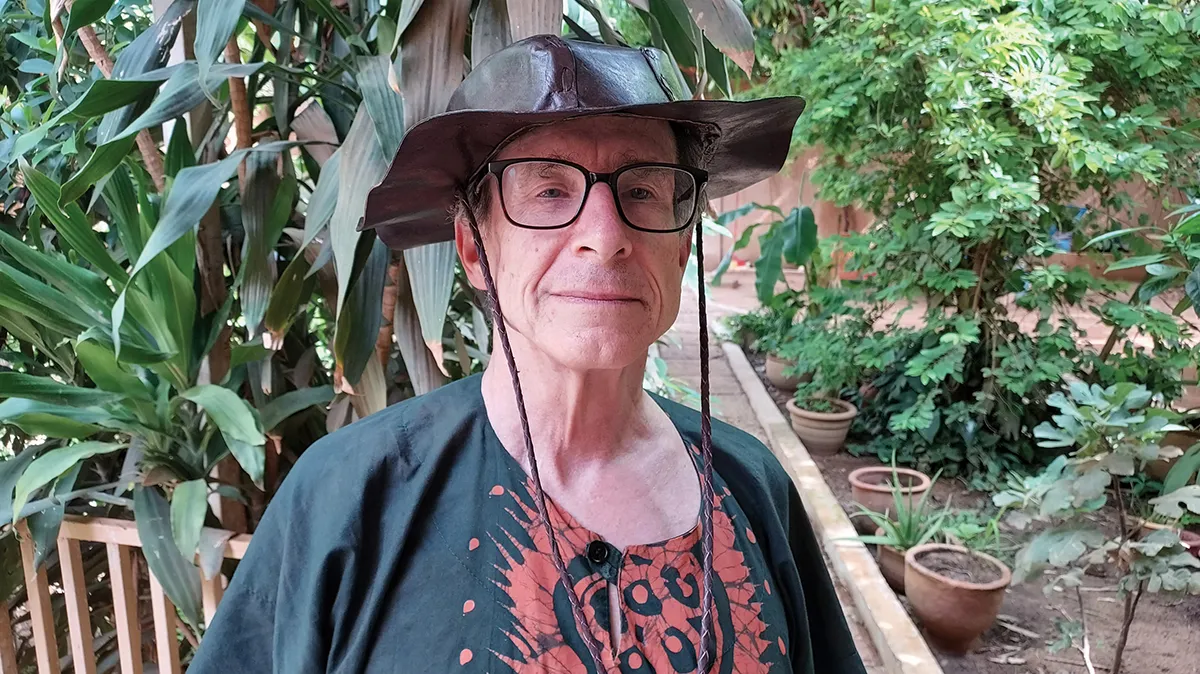
It felt like a variation of another lockdown that we’d all experienced: the one during the COVID-19 pandemic. The restlessness, the apprehension tinged with boredom. When might I be free to travel? When will it end? Only this time, the cause was not viral but political.
Martinique is part of France the way that Hawaii is part of the U.S., so by virtue of my marriage to a French citizen—the one I had lured to Niger thirty-eight years prior—I managed to secure a seat on one of the evacuation flights from Niamey to Paris operated by the French Air and Space Force. Met at Charles de Gaulle Airport by the French Red Cross and two diplomats from the American Embassy in Paris, I was filled both with relief and regret—relief for my escape, but regret for the compatriot and country I had left behind.
A country where I had brought our ten-year-old son to help resolve an inheritance dispute over the family horse (resulting in our co-authored book, My African Horse Problem, in 2008); a land where I crunched on fried grasshoppers with our sixteen-year-old daughter (the same person who resisted eating sea fish transported a thousand miles overland from the nearest coast). A country I knew not during my four years in Poughkeepsie, but which the Peace Corps seared into my soul—as it has done with dozens, if not scores, of other Vassar alums in other enchanting lands.




vq@vassar.edu
#AH100VC
